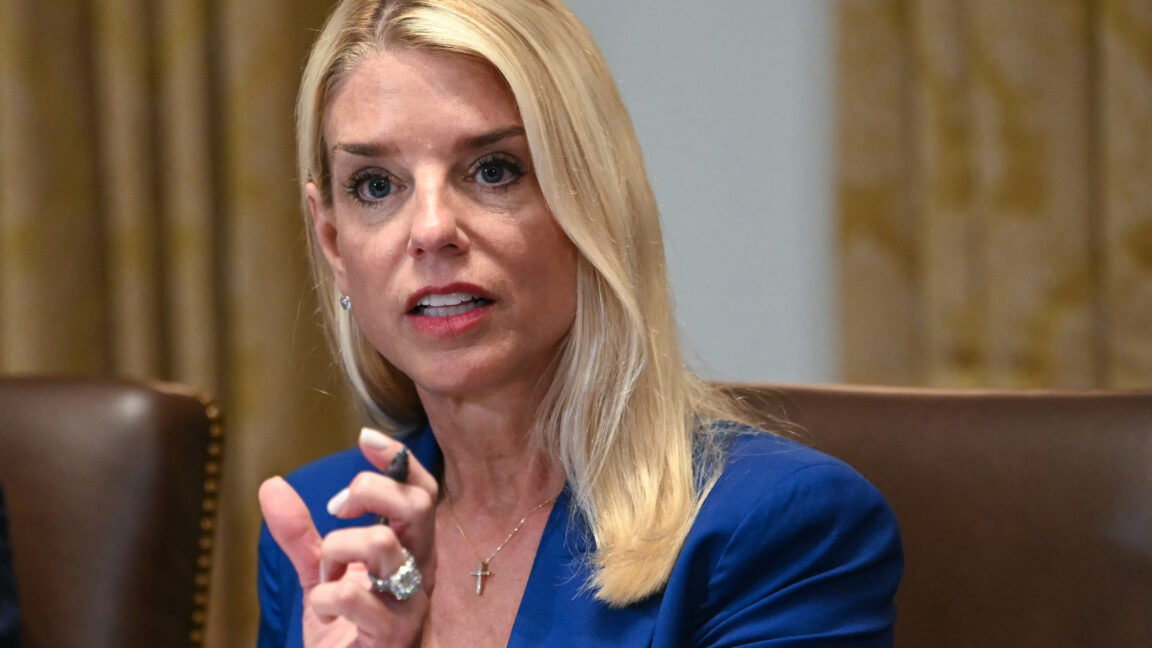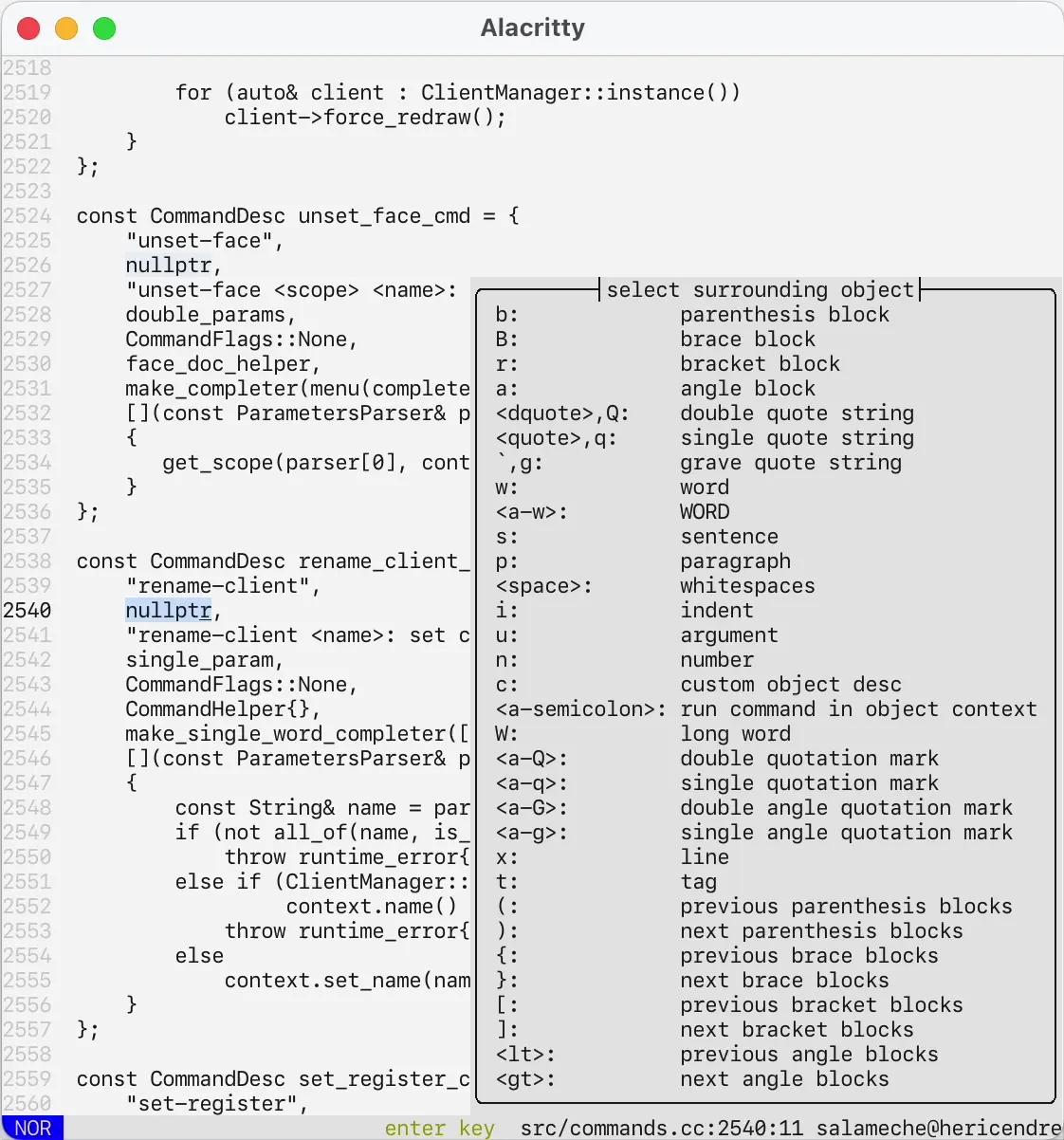
Trump’s Ultimatum for America’s Largest Public-Energy Provider
Now Microsoft’s Copilot Vision AI can scan everything on your screen

Medieval preacher invoked chivalric hero as a meme in sermon
 Ars Technica - All content
Ars Technica - All content

Large study squashes anti-vaccine talking points about aluminum
 Ars Technica - All content
Ars Technica - All content

Congress moves to reject bulk of White House’s proposed NASA cuts
 Ars Technica - All content
Ars Technica - All content
How to choose which Apple Watch to buy

Disaster at FEMA

Seagate’s massive, 30TB, $600 hard drives are now available for anyone to buy
 Ars Technica - All content
Ars Technica - All content
Microsoft’s “Digital Escort” Program Could Leave Sensitive Government Info Vulnerable to Espionage. Here’s What to Know.
 ProPublica
ProPublica
ProPublica is a nonprofit newsroom that investigates abuses of power. Sign up to receive our biggest stories as soon as they’re published.
For nearly a decade, Microsoft has used engineers in China to help maintain highly sensitive Defense Department computer systems. ProPublica’s investigation reveals how a model that relies on “digital escorts” to oversee foreign tech support could leave some of the nation’s most sensitive data vulnerable to hacking from its leading cyber adversary.
Here are the key takeaways from that report:
Only U.S. citizens with security clearances are permitted to access the Defense Department’s most sensitive data.Since 2011, cloud computing companies that wanted to sell their services to the U.S. government had to establish how they would ensure that personnel working with federal data would have the requisite “access authorizations” and background screenings. Additionally, the Defense Department requires that people handling sensitive data be U.S. citizens or permanent residents.
This presented an issue for Microsoft, which relies on a vast global workforce with significant operations in India, China and the European Union.
Microsoft established its low-profile “digital escort” program to get around this prohibition.Microsoft’s foreign workforce is not permitted to access sensitive cloud systems directly, so the tech giant hired U.S.-based “digital escorts,” who had security clearances that authorized them to access sensitive information, to take direction from the overseas experts. The engineers might briefly describe the job to be completed — for instance, updating a firewall, installing an update to fix a bug or reviewing logs to troubleshoot a problem. Then the escort copies and pastes the engineer’s commands into the federal cloud.
The problem, ProPublica found, is that digital escorts don’t necessarily have the advanced technical expertise needed to spot problems.
“We’re trusting that what they’re doing isn’t malicious, but we really can’t tell,” said one current escort.
The escorts handle data that, if leaked, would have “catastrophic” effects.Microsoft uses the escort system to handle the government’s most sensitive information that falls below “classified.” According to the government, this includes “data that involves the protection of life and financial ruin.” The “loss of confidentiality, integrity, or availability” of this information “could be expected to have a severe or catastrophic adverse effect” on operations, assets and individuals, the government has said.
Defense Department data in this category includes materials that directly support military operations.
The program could expose Pentagon data to cyberattacks.Because the U.S.-based escorts are taking direction from foreign engineers, including those based in China, the nation’s greatest cyber adversary, it is possible that an escort could unwittingly insert malicious code into the Defense Department’s computer systems.
A former Microsoft engineer who worked on the system acknowledged this possibility. “If someone ran a script called ‘fix_servers.sh’ but it actually did something malicious, then [escorts] would have no idea,” the engineer, Matthew Erickson, told ProPublica.
Pradeep Nair, a former Microsoft vice president who said he helped develop the concept from the start, said a variety of safeguards including audit logs, the digital trail of system activity, could alert Microsoft or the government to potential problems. “Because these controls are stringent, residual risk is minimal,” Nair said.
Digital escorts present a natural opportunity for spies, experts say.“If I were an operative, I would look at that as an avenue for extremely valuable access. We need to be very concerned about that,” said Harry Coker, who was a senior executive at the CIA and the National Security Agency. Coker, who also was national cyber director during the Biden administration, added that he and his former intelligence colleagues “would love to have had access like that.”
Chinese laws allow government officials there to collect data “as long as they’re doing something that they’ve deemed legitimate,” said Jeremy Daum, senior research fellow at the Paul Tsai China Center at Yale Law School. Microsoft’s China-based tech support for the U.S. government presents an opening for Chinese espionage, “whether it be putting someone who’s already an intelligence professional into one of those jobs, or going to the people who are in the jobs and pumping them for information,” Daum said. “It would be difficult for any Chinese citizen or company to meaningfully resist a direct request from security forces or law enforcement.”
Microsoft says the program is government-approved.In a statement, Microsoft said that its personnel and contractors operate in a manner “consistent with US Government requirements and processes.”
The company’s global workers “have no direct access to customer data or customer systems,” the statement said. Escorts “with the appropriate clearances and training provide direct support. These personnel are provided specific training on protecting sensitive data, preventing harm, and use of the specific commands/controls within the environment.”
Insight Global — a contractor that provides digital escorts to Microsoft — said it “evaluates the technical capabilities of each resource throughout the interview process to ensure they possess the technical skills required” for the job and provides training.
Microsoft says it disclosed details of the escort program to the government. Former Pentagon officials said they’d never heard of it.Microsoft told ProPublica that it described the escort model in documents submitted to the government as part of cloud vendor authorization processes. Former defense and intelligence officials said in interviews that they had never heard of digital escorts. Even the Defense Department’s IT agency didn’t know about it until reached for comment by ProPublica.
“I probably should have known about this,” said John Sherman, who was chief information officer for the Defense Department during the Biden administration. He said the system is a major security risk for the department and called for a “thorough review by [the Defense Information Systems Agency], Cyber Command and other stakeholders that are involved in this.”
DISA said, “Experts under escort supervision have no direct, hands-on access to government systems; but rather offer guidance and recommendations to authorized administrators who perform tasks.”
There were warnings early on about the risks.Multiple people raised concerns about the escort strategy over the years, including while it was still in development. A former Microsoft employee, who was involved in the company’s cybersecurity strategy, told an executive they opposed the concept, viewing it as too risky from a security perspective.
Around 2016, Microsoft engaged contacts from Lockheed Martin to hire escorts. The project manager says they told their counterpart at Microsoft they were concerned the escorts would not have the “right eyes” for the job given the relatively low pay.
Microsoft did not respond to questions about these points.
Other cloud providers wouldn’t say if they also use escorts.It’s unclear whether other major cloud service providers to the federal government also use digital escorts in tech support. Amazon Web Services and Google Cloud declined to comment on the record for this article. Oracle did not respond to requests for comment.
To make Ironheart feel tactile, the show’s creative team had to get on the same page

Security Experts ‘Losing Their Minds’ Over FAA Proposal

Chinese firms rush for Nvidia chips as US prepares to lift ban
 Ars Technica - All content
Ars Technica - All content
Trump announces billions in investments to make Pennsylvania an AI hub

What Pixar Should Learn From Its Elio Disaster
Xbox tests letting you stream your own games on PC
Adidas now offers a laced version of its 3D-printed shoes

Congrats on the New DOD Gig, MechaHitler!
The best deals on MacBooks right now

Corporate inadequacy has rendered my favorite rediscovered gadget useless
 Ars Technica - All content
Ars Technica - All content

I've found the best PC gaming deals in the Black Friday in July sale at Dell - save up to $750

We’ve covered the Dell Black Friday in July deals a few times in recent days, and they’re still coming. In fact, there are now so many offers that we’ve got a whole list of them here.
Here are the best AirPods deals you can get right now

Putin Needs to Believe He Can’t Win
Analogue’s 4K N64 has been delayed again, but only by a month
Sony’s pocket-sized RX1R camera returns with its first update in 10 years

From the hospital to the car plant: What is GM doing with CT scanners?
 Ars Technica - All content
Ars Technica - All content
There's a bunch of discounted AMD and Nvidia graphics cards now up to 50% off at Amazon today
I spent a good chunk of my weekend combing through GPU deals like these. I don't really need a new graphics card, but seeing prices drop by almost half gets my curiosity going. It’s not even just the big names like the RTX 5090 or the Radeon RX 7900 XT, even refurbished cards look tempting when they’re going for hundreds less. I know some folks hesitate with renewed products, but I’ve had solid luck so far. Last year, I grabbed a renewed RTX 4070 super and it’s been running steady since. I guess it’s that mix of curiosity and trying not to miss out that keeps me scrolling through these lists. Here's the best deals I can find for your latest rig upgrade:

Dear James: My Ex and I Were Horrible to Each Other

Grok’s “MechaHitler” meltdown didn’t stop xAI from winning $200M military deal
 Ars Technica - All content
Ars Technica - All content

The Supreme Court Won’t Explain Itself

GOP’s pro-industry crypto bills could financially ruin millions, lawmaker warns
 Ars Technica - All content
Ars Technica - All content
Amazon still has a saving on Samsung 990 Pro SSDs even after Prime Day is over
Just when you thought Prime Day was over, we’ve mentioned it again and triggered all those flashbacks.

Photos: The Grand Canyon Burns
The IRS Is Building a Vast System to Share Millions of Taxpayers’ Data With ICE
 ProPublica
ProPublica
ProPublica is a nonprofit newsroom that investigates abuses of power. Sign up to receive our biggest stories as soon as they’re published.
The Internal Revenue Service is building a computer program that would give deportation officers unprecedented access to confidential tax data.
ProPublica has obtained a blueprint of the system, which would create an “on demand” process allowing Immigration and Customs Enforcement to obtain the home addresses of people it’s seeking to deport.
Last month, in a previously undisclosed dispute, the acting general counsel at the IRS, Andrew De Mello, refused to turn over the addresses of 7.3 million taxpayers sought by ICE. In an email obtained by ProPublica, De Mello said he had identified multiple legal “deficiencies” in the agency’s request.
Two days later, on June 27, De Mello was forced out of his job, people familiar with the dispute said. The addresses have not yet been released to ICE. De Mello did not respond to requests for comment, and the administration did not address questions sent by ProPublica about his departure.
The Department of Government Efficiency began pushing the IRS to provide taxpayer data to immigration agents soon after President Donald Trump took office. The tax agency’s acting general counsel refused and was replaced by De Mello, who Trump administration officials viewed as more willing to carry out the president’s agenda. Soon after, the Department of Homeland Security, ICE’s parent agency, and the IRS negotiated a “memorandum of understanding” that included specific legal guardrails to safeguard taxpayers’ private information.
In his email, De Mello said ICE’s request for millions of records did not meet those requirements, which include having a written assurance that each taxpayer whose address is being sought was under active criminal investigation.
“There’s just no way ICE has 7 million real criminal investigations, that’s a fantasy,” said a former senior IRS official who had been advising the agency on this issue. The demands from the DHS were “unprecedented,” the official added, saying the agency was pressing the IRS to do what amounted to “a big data dump.”
In the past, when law enforcement sought IRS data to support its investigations, agencies would give the IRS the full legal name of the target, an address on file and an explanation of why the information was relevant to a criminal inquiry. Such requests rarely involved more than a dozen people at a time, former IRS officials said.
Danny Werfel, IRS commissioner during the Biden administration, said the privacy laws allowing federal investigators to obtain taxpayer data have never “been read to open the door to the sharing of thousands, tens of thousands, or hundreds of thousands of tax records for a broad-based enforcement initiative.”
A spokesperson for the White House said the planned use of IRS data was legal and a means of fulfilling Trump’s campaign pledge to carry out mass deportations of “illegal criminal aliens.”
Taxpayer data is among the most confidential in the federal government and is protected by strict privacy laws, which have historically limited its transfer to law enforcement and other government agencies. Unauthorized disclosure of taxpayer return information is a felony that can carry a penalty of up to five years in prison.
The system that the IRS is now creating would give ICE automated access to home addresses en masse, limiting the ability of IRS officials to consider the legality of transfers. IRS insiders who reviewed a copy of the blueprint said it could result in immigration agents raiding wrong or outdated addresses.
“If this program is implemented in its current form, it’s extremely likely that incorrect addresses will be given to DHS and individuals will be wrongly targeted,” said an IRS engineer who examined the blueprints and who, like other officials, spoke on condition of anonymity for fear of retribution.
The dispute that ended in De Mello’s ouster was the culmination of months of pressure on the IRS to turn over massive amounts of data in ways that would redefine the relationship between the agency and law enforcement and reduce taxpayers’ privacy, records and interviews show.
In one meeting in late March between senior IRS and DHS officials, a top ICE official made a suggestion: Why doesn’t Homeland Security simply provide the name and state of its targets and have the IRS return the addresses of everyone who matches that criteria?
The IRS lawyers were stunned. They feared they could face criminal liability if they handed over the addresses of individuals who were not under a criminal investigation. The conversation and news of deeper collaboration with ICE so disturbed career staff that it led to a series of departures in late March and early April across the IRS’ legal, IT and privacy offices.
They were “pushing the boundaries of the law,” one official said. “Everyone at IRS felt the same way.”
The BlueprintThe technical blueprint obtained by ProPublica shows that engineers at the agency are preparing to give DHS what it wants: a system that enables massive automated data sharing. The goal is to launch the new system before the end of July, two people familiar with the matter said.
The DHS effort to obtain IRS data comes as top immigration enforcement leaders face escalating White House pressure to deport some 3,000 people per day, according to reports.
One federal agent tasked with assisting ICE on deportations said recent operations have been hamstrung by outdated addresses. Better information could dramatically speed up arrests. “Some of the leads that they were giving us were old,” said the agent, who spoke on condition of anonymity because he was not authorized to speak with the press. “They’re like from two administrations ago.”
In early March, immigrants rights groups sued the IRS hoping to block the plan, arguing that the memorandum of understanding between DHS and the IRS is illegal. But a judge in early May ruled against them, saying the broader agreement complied with Section 6103, the existing law regulating IRS data sharing. That opened the door for engineers to begin building the system.
The judge did not address the technical blueprint, which didn’t exist at the time of the ruling. But the case is pending, which means the new system could still come under legal review.
Until now, little was known about the push and pull between the two agencies or the exact technical mechanics behind the arrangement.
The plan has been shrouded in secrecy even within the IRS, with details of its development withheld from regular communications. Several IRS engineers and lawyers have avoided working on the project out of concerns about personal legal risk.
Asked about the new system, a spokesperson for IRS parent agency the Treasury Department said the memorandum of understanding, often called an MOU, “has been litigated and determined to be a lawful application of Section 6103, which provides for information sharing by the IRS in precise circumstances associated with law enforcement requests.”
At a time when Trump is making threats to deport not only undocumented immigrants but also U.S. citizens, the scope of information-sharing with the IRS could continue to grow, according to documents reviewed by ProPublica and sources familiar with the matter: DHS has been looking for ways to expand the agreement that could allow Homeland Security officials to seek IRS data on Americans being investigated for various crimes.
Last month, an ICE attorney proposed updating the MOU to authorize new data requests on people “associated with criminal activities which may include United States citizens or lawful permanent residents,” according to a document seen by ProPublica. The status of this proposal is unclear. De Mello, at the time, rejected it and called for senior Treasury Department leadership to personally sign off on such a significant change.
The White House described DHS’ work with the IRS as a good-faith effort to identify and deport those who are living in the country illegally.
“ProPublica continues to degrade their already terrible reputation by suggesting we should turn a blind eye to criminal illegal aliens present in the United States for the sake of trying to collect tax payments from them,” White House spokesperson Abigail Jackson said in a statement after receiving questions about the blueprint from ProPublica.
She pointed to the April MOU as giving the government the authority to create the new system and added, “This isn’t a surveillance system. … It’s part of President Trump’s promise to carry out the mass deportation of criminal illegal aliens — the promise that the American people elected him on and he is committed to fulfilling.”
In a separate statement, a senior DHS official also cited the court’s approval of the MOU, saying that it “outlines a process to ensure that sensitive taxpayer information is protected while allowing law enforcement to effectively pursue criminal violations.”
How the System WorksThe new system would represent a sea change, allowing law enforcement to request enormous swaths of confidential data in bulk through an automated, computerized process.
The system, according to the blueprint and interviews with IRS engineers, would work like this:
First, DHS would send the IRS a spreadsheet containing the names and previous addresses of the people it’s targeting. The request would include the date of a final removal order, a relevant criminal statute ICE is using to investigate the individual, and the tax period for which information is sought. If DHS fails to include any of this information, the system would reject the request.
The system then attempts to match the information provided by the DHS to a specific taxpayer identification number, which is the primary method by which the IRS identifies an individual in its databases.
If the system makes a match, it accesses the individual’s associated tax file and pulls the address listed during the most recent tax period. Then the system would produce a new spreadsheet enriched with taxpayer data that contains DHS’ targets’ last known addresses. The spreadsheet would include a record of names rejected for lack of required information and names for which it could not make a match.
Tax and privacy experts say they worry about how such a powerful yet crude platform could make dangerous mistakes. Because the search starts with a name instead of a taxpayer identification number, it risks returning the address of an innocent person with the same name as or a similar address to that of one of ICE’s targets. The proposed system assumes the data provided by DHS is accurate and that each targeted individual is the subject of a valid criminal investigation. In effect, the IRS has no way to independently check the bases of these requests, experts told ProPublica.
In addition, the blueprint does not limit the amount of data that can be transferred or how often DHS can request it. The system could easily be expanded to acquire all the information the IRS holds on taxpayers, said technical experts and IRS engineers who reviewed the documents. By shifting a single parameter, the program could return more information than just a target’s address, said an engineer familiar with the plan, including employer and familial relationships.
Engineers based at IRS offices in Lanham, Maryland, and Dallas are developing the blueprint.
“Gone Back on Its Word”For decades, the American government has encouraged everyone who makes an income in the U.S. to pay taxes — regardless of immigration status — with an implicit promise that their information would be protected. Now that same data may be used to locate and deport noncitizens.
“For years, the IRS has told immigrants that it only cares that they pay their taxes,” said Nandan Joshi, an attorney with the Public Citizen Litigation Group, which is seeking to block the data-sharing agreement in federal court. “By agreeing to share taxpayer data with ICE on a mass basis, the IRS has gone back on its word.”
The push to share IRS data with DHS emerged while Elon Musk’s DOGE reshaped the engineering staff of the IRS. Sam Corcos, a Silicon Valley startup founder with no government experience, pushed out more than 50 IRS engineers and restructured the agency’s engineering priorities while he was the senior DOGE official at the agency. He later became chief information officer at Treasury. He has also led a separate IRS effort to create a master database using products from Silicon Valley giant Palantir Technologies, enabling the government to link and search large swaths of data.
Corcos didn’t respond to a request for comment. The White House said DOGE is not part of the DHS-IRS pact.
Sen. Ron Wyden, the ranking Democrat on the Senate Committee on Finance, which oversees the IRS, told ProPublica the system being built was ripe for abuse. It “would allow an outside agency unprecedented access to IRS records for reasons that have nothing to do with tax administration, opening the door to endless fishing expeditions,” he said.
The Treasury Inspector General for Tax Administration, the department’s internal watchdog, is already probing efforts by Trump and DOGE to obtain private taxpayer data and other sensitive information, ProPublica reported in April.
The Trump administration continues to add government agencies to its deportation drive.
DOGE and DHS are also working to build a national citizenship database, NPR reported last month. The database links information from the Social Security Administration and the DHS, ostensibly for the purpose of allowing state and local election officials to verify U.S. citizenship.
And in May, a senior Treasury Department official directed 250 IRS criminal investigative agents to help deportation operations, a significant shift for two agencies that historically have had separate missions.
McKenzie Funk contributed reporting, and Kirsten Berg and Alex Mierjeski contributed research.
Happy 20th birthday Django! Here’s my talk on Django Origins from Django’s 10th

Obsidian's hottest Dungeons & Dragons RPG of 2006 is out now in ostensibly enhanced form

‘Not that into peace doves’: The Apollo-Soyuz patch NASA rejected
 Ars Technica - All content
Ars Technica - All content

BYD has caught up with Tesla in the global EV race. Here’s how.
 Ars Technica - All content
Ars Technica - All content

Grab this 2TB WD Black mini SSD for Steam Deck at its lowest price so far this year

I recently ripped out my Steam Deck’s SSD and enthusiastically slapped in a WD Black SN770M 2TB mini SSD, and it's easily the smartest thing I’ve done with it that didn’t involve tinkering around in desktop mode.

Tales of the Shire's system requirements have me considering grafting a graphics card to a Hobbit's bum

Tales Of The Shire: A The Lord Of The Rings Game is finally coming out this month, offering terrifyingly cosy Hobbitiness to us bumbling Bilbos. Its system requirements have just dropped, and they're pretty reasonable.
In fact, its needs are so modest and homely that I'm wondering whether you might be able to run it on a Hobbit, provided you could find one in real life and staple some Nvidia - or AMD- branded plastic into the surface of its flesh. It's ok, I'm sure Gandalf has a magic stapler that doesn't produce excruciating pain if you fire it directly into a person.

A tiny invasive species is a big threat to CA water


A new invader threatens California water supplies. Can the state stop its spread?


Federal immigration crackdown threatens California’s historic housing reforms


Republicans cap student loan debt. Why that’s bad news for California medical students


What We Gain by Forgetting

LA Times valiantly explains how Los Angeles became the epicenter of homelessness


Helldivers 2's latest patch lets you impale baddies with flags, as the bots take aim at the Democracy Space Station

Fresh Helldivers 2 patch alert. This one's patch 01.003.200, and it brings the latest in pointy flag tip technology, in addition to another round of weapon balancing. You'll need that flag stabbiness too, as the latest Galactic War twist has seen the Automatons try to wrestle control of Super Earth's space station.
Yep, stop trying to rename a city 'Gun' for five minutes, some stuff's going down in HD2 that you need to be clued in on, even if its just so you can run around the room cheering at how much more effective your Flame Sentry'll now be.

The Trump Administration Is Violating the First Rule of Disasters
I'm travelling this week, and I wish I'd ordered one of these power banks for my Steam Deck
One of the best things about my job is that I get to fly around the world and go to events, and while I’m off to Warframe’s TennoCon this week (and very excited about it) there’s always a bit of a panic about what to pack to keep oneself sane on a long flight.

We saw the heart of Pluto 10 years ago—it’ll be a long wait to see the rest
 Ars Technica - All content
Ars Technica - All content

Behind the scenes #194
 Keyboard Builders' Digest
Keyboard Builders' Digest
 Keyboard projects, tips, quick news, keyboard art, in the mailbox, meetups, vendors, discounts.
Keyboard projects, tips, quick news, keyboard art, in the mailbox, meetups, vendors, discounts.
The 9 best books of the year so far

I Left My Church—And Found Christianity

An IRS Regulation Change That Could Sow Societal Division
Why it’s taking LA so long to rebuild

ZeniMax Union say they're fighting for staff left in limbo by Microsoft cancelling MMO as part of mass layoffs

As part of their mass layoffs earlier this month, Microsoft cancelled an MMORPG that was in the works at The Elder Scrolls Online developers ZeniMax Online Studios. Now, the union that represents a number of devs left in limbo by that game's canning have issued an update about the process of fighting for their futures.
ZOS' MMO, codenamed Project Blackbird, wasn't the only game Microsoft pulled the plug on as they let go of around 9k people. Rare's Everwild and The Initiative's Perfect Dark reboot were also wiped out, with the latter studio being shuttered to boot.

Finally, a game about a boy who thinks he's a tomb searching for a dead body to bury inside of him

The first thing that happened to me in the demo for The Little Tomb: The Maholova Club And The Search For A Dead Body was a stuffed horse on a spring telling me it knew when and how I'd die. Many such horses. You play as Kofun, a boy shaped like a keyhole tomb who is also sort of an actual keyhole tomb but also a boy who wants to fulfill his destiny as a keyhole tomb, namely by finding a dead body to bury inside of himself. He lives in a park with his mate Haniwa, who is a Haniwa. Haniwa's secret is that he's very good at calligraphy. Here's some visual orientation in case you're not caught up yet.
A Little-Known Microsoft Program Could Expose the Defense Department to Chinese Hackers
 ProPublica
ProPublica
ProPublica is a nonprofit newsroom that investigates abuses of power. Sign up to receive our biggest stories as soon as they’re published.
Microsoft is using engineers in China to help maintain the Defense Department’s computer systems — with minimal supervision by U.S. personnel — leaving some of the nation’s most sensitive data vulnerable to hacking from its leading cyber adversary, a ProPublica investigation has found.
The arrangement, which was critical to Microsoft winning the federal government’s cloud computing business a decade ago, relies on U.S. citizens with security clearances to oversee the work and serve as a barrier against espionage and sabotage.
But these workers, known as “digital escorts,” often lack the technical expertise to police foreign engineers with far more advanced skills, ProPublica found. Some are former military personnel with little coding experience who are paid barely more than minimum wage for the work.
“We’re trusting that what they’re doing isn’t malicious, but we really can’t tell,” said one current escort who agreed to speak on condition of anonymity, fearing professional repercussions.
The system has been in place for nearly a decade, though its existence is being reported publicly here for the first time.
Microsoft told ProPublica that it has disclosed details about the escort model to the federal government. But former government officials said in interviews that they had never heard of digital escorts. The program appears to be so low-profile that even the Defense Department’s IT agency had difficulty finding someone familiar with it. “Literally no one seems to know anything about this, so I don’t know where to go from here,” said Deven King, spokesperson for the Defense Information Systems Agency.
National security and cybersecurity experts contacted by ProPublica were also surprised to learn that such an arrangement was in place, especially at a time when the U.S. intelligence community and leading members of Congress and the Trump administration view China’s digital prowess as a top threat to the country.
The Office of the Director of National Intelligence has called China the “most active and persistent cyber threat to U.S. Government, private-sector, and critical infrastructure networks.” One of the most prominent examples of that threat came in 2023, when Chinese hackers infiltrated the cloud-based mailboxes of senior U.S. government officials, stealing data and emails from the commerce secretary, the U.S. ambassador to China and others working on national security matters. The intruders downloaded about 60,000 emails from the State Department alone.
With President Donald Trump and his allies concerned about spying, the State Department announced plans in May to “aggressively revoke visas for Chinese students” — a pledge that the president seems to have walked back. The administration is also trying to arrange the sale of the popular social media platform TikTok, which is owned by a Chinese company that some lawmakers believe could hand over sensitive U.S. user data to Beijing and fuel misinformation with its content recommendations. But experts told ProPublica that digital escorting poses a far greater threat to national security than either of those issues and is a natural opportunity for spies.
“If I were an operative, I would look at that as an avenue for extremely valuable access. We need to be very concerned about that,” said Harry Coker, who was a senior executive at the CIA and the National Security Agency. Coker, who also was national cyber director during the Biden administration, added that he and his former intelligence community colleagues “would love to have had access like that.”
It is difficult to know whether engineers overseen by digital escorts have ever carried out a cyberattack against the U.S. government. But Coker wondered whether it “could be part of an explanation for a lot of the challenges we have faced over the years.”
Microsoft uses the escort system to handle the government’s most sensitive information that falls below “classified.” According to the government, this “high impact level” category includes “data that involves the protection of life and financial ruin.” The “loss of confidentiality, integrity, or availability” of this information “could be expected to have a severe or catastrophic adverse effect” on operations, assets and individuals, the government has said. In the Defense Department, the data is categorized as “Impact Level” 4 and 5 and includes materials that directly support military operations.
John Sherman, who was chief information officer for the Department of Defense during the Biden administration, said he was surprised and concerned to learn of ProPublica’s findings. “I probably should have known about this,” he said. He told the news organization that the situation warrants a “thorough review by DISA, Cyber Command and other stakeholders that are involved in this.”
In an emailed statement, the Defense Information Systems Agency said that cloud service providers “are required to establish and maintain controls for vetting and using qualified specialists,” but the agency did not respond to ProPublica’s questions regarding the digital escorts’ qualifications.
It’s unclear whether other cloud providers to the federal government use digital escorts as part of their tech support. Amazon Web Services and Google Cloud declined to comment on the record for this article. Oracle did not respond to requests for comment.
Microsoft declined to make executives available for interviews for this article. In response to emailed questions, the company provided a statement saying its personnel and contractors operate in a manner “consistent with US Government requirements and processes.”
Global workers “have no direct access to customer data or customer systems,” the statement said. Escorts “with the appropriate clearances and training provide direct support. These personnel are provided specific training on protecting sensitive data, preventing harm, and use of the specific commands/controls within the environment.” In addition, Microsoft said it has an internal review process known as “Lockbox” to “make sure the request is deemed safe or has any cause for concern.” A company spokesperson declined to provide specifics about how it works but said it’s built into the system and involves review by a Microsoft employee in the U.S.
Over the years, various people involved in the work, including a Microsoft cybersecurity leader, warned the company that the arrangement is inherently risky, those people told ProPublica. Despite the presence of an escort, foreign engineers are privy to granular details about the federal cloud — the kind of information hackers could exploit. Moreover, the U.S. escorts overseeing these workers are ill equipped to spot suspicious activity, two of the people said.
Even those who helped develop the escort system acknowledge the people doing the work may not be able to detect problems.
“If someone ran a script called ‘fix_servers.sh’ but it actually did something malicious then [escorts] would have no idea,” Matthew Erickson, a former Microsoft engineer who worked on the escort system, told ProPublica in an email. That said, he maintained that the “scope of systems they could disrupt” is limited.
The Defense Department requires anyone working with its most sensitive data to be a U.S. citizen, U.S. national or permanent resident. “No Foreign persons may have such access,” according to the department’s cloud security requirements. Microsoft, however, has a global workforce, so it created the digital escort system as a work-around. Here’s an example of how it works and the risk it poses:
Tech support is needed on a Microsoft cloud product.
A Microsoft engineer in China files an online “ticket” to take on the work.
A U.S.-based escort picks up the ticket.
The engineer and the escort meet on the Microsoft Teams conferencing platform.
The engineer sends computer commands to the U.S. escort, presenting an opportunity to insert malicious code.
The escort, who may not have advanced technical expertise, inputs the commands into the federal cloud system.
Illustrations for ProPublica
A Microsoft contractor called Insight Global posted an ad in January seeking an escort to bring engineers without security clearances “into the secured environment” of the federal government and to “protect confidential and secure information from spillage,” an industry term for a data leak. The pay started at $18 an hour.
While the ad said that specific technical skills were “highly preferred” and “nice to have,” the main prerequisite was possessing a valid “secret” level clearance issued by the Defense Department.
“People are getting these jobs because they are cleared, not because they’re software engineers,” said the escort who agreed to speak anonymously and who works for Insight Global.
Each month, the company’s roughly 50-person escort team fields hundreds of interactions with Microsoft’s China-based engineers and developers, inputting those workers’ commands into federal networks, the employee said.
In a statement to ProPublica, Insight Global said it “evaluates the technical capabilities of each resource throughout the interview process to ensure they possess the technical skills required” for the job, and provides training. The company noted that escorts also receive additional cyber and “insider threat awareness” training as part of the government security clearance process.
“While a security clearance may be required for the role, it is but one piece of the puzzle,” the company said.
Microsoft did not respond to questions about Insight Global.
“The Path of Least Resistance”When modern cloud technology emerged in the 2000s, offering on-demand computing power and data storage via the internet, it ushered in fundamental changes to federal government operations.
For decades, federal departments used computer servers owned and operated by the government itself to house data and power networks. Shifting to the cloud meant moving that work to massive off-site data centers managed by tech companies.
Federal officials believed that the cloud would provide greater power, efficiency and cost savings. But the transition also meant that the government would cede some control over who maintained and accessed its information to companies like Microsoft, whose employees would take over tasks previously handled by federal IT workers.
To address the risks of this revolution, the government started the Federal Risk and Authorization Management Program, known as FedRAMP, in 2011. Under the program, companies that wanted to sell their cloud services to the government had to establish how they would ensure that personnel working with sensitive federal data would have the requisite “access authorizations” and background screenings. On top of that, the Defense Department had its own cloud guidelines, requiring that people handling sensitive data be U.S. citizens or permanent residents.
This presented an issue for Microsoft, given its reliance on a vast global workforce, with significant operations in India, China and the European Union. So the company tapped a senior program manager named Indy Crowley to put federal officials at ease. Known for his familiarity with the rules and his ability to converse in the government’s acronym-heavy lingo, colleagues dubbed him the “FedRAMP whisperer.”
In an interview, Crowley told ProPublica that he appealed directly to FedRAMP leadership, arguing that the relative risk from Microsoft’s global workforce was minimal. To make his point, he said he once grilled a FedRAMP official on the provenance of code in products supplied by other government vendors such as IBM. The official couldn’t say with certainty that only U.S. citizens had worked on the product in question, he said. The cloud, Crowley argued, should not be treated any differently.
Crowley said he also met with prospective customers across the government and told ProPublica that the Defense Department was the “one making the most demands.” Concerned about the company’s global workforce, officials there asked him who from Microsoft would be “behind the curtain” working on the cloud. Given the department’s citizenship requirements, the officials raised the possibility of Microsoft “hiring a bunch of U.S. citizens to maintain the federal cloud” directly, Crowley told ProPublica. For Microsoft, the suggestion was a nonstarter, Crowley said, because the increased labor costs of implementing it broadly would make a cloud transition prohibitively expensive for the government.
“It’s always a balance between cost and level of effort and expertise,” he told ProPublica. “So you find what’s good enough.” Hiring virtual escorts to supervise Microsoft’s foreign workforce emerged as “the path of least resistance,” Crowley said.
Microsoft did not respond to ProPublica’s questions about Crowley’s account.
When he brought the concept back to Microsoft, colleagues had mixed reactions. Tom Keane, then the corporate vice president for Microsoft’s cloud platform, Azure, embraced the idea, according to a former employee involved in the discussions, as it would allow the company to scale up. But that former employee, who was involved in cybersecurity strategy, told ProPublica they opposed the concept, viewing it as too risky from a security perspective. Both Keane and Crowley dismissed the concerns, said the former employee, who left the company before the escort concept was deployed.
“People who got in the way of scaling up did not stay,” the former employee told ProPublica.
Crowley said he did not recall the discussion. Keane did not respond to requests for comment.
On its march to becoming one of the world’s most valuable companies, Microsoft has repeatedly prioritized corporate profit over customer security, ProPublica has found. Last year, the news organization reported that the tech giant ignored one of its own engineers when he repeatedly warned that a product flaw left the U.S. government exposed; state-sponsored Russian hackers later exploited that weakness in one of the largest cyberattacks in history. Microsoft has defended its decision not to address the flaw, saying that it received “multiple reviews” and that the company weighs a variety of factors when making security decisions.
A Skills Gap From the StartThe idea of an escort wasn’t novel. The National Institute of Standards and Technology, which serves as the federal government’s standards-setting body, had established recommendations on how IT maintenance should be performed on-site, such as in a restricted government office. “Maintenance personnel that lack appropriate security clearances or are not U.S. citizens” must be escorted and supervised by “approved organizational personnel who are fully cleared, have appropriate access authorizations, and are technically qualified,” the guidelines state.
The government at the time specified the intent of the recommendation: to deny “individuals who lack appropriate security clearances ... or who are not U.S. citizens, visual and electronic access to” sensitive government information.
But escorts in the cloud wouldn’t necessarily be able to meet that goal, given the gap in technical expertise between them and the Microsoft counterparts they would be taking direction from.
That imbalance, though, was baked into the escorting model.
Erickson, the former Microsoft engineer who worked on the model, told ProPublica that escorts are “somewhat technically proficient,” but mainly are “just there to make sure the employees don’t accidentally or intentionally view” passwords, customer data or personally identifiable information. “If there are problems with the underlying” cloud services, “then only the people who work on those services at Microsoft would have the requisite knowledge to fix it,” he said.
Advanced threats from foreign adversaries weren’t on the radar for Erickson, who said he didn’t “have any reason to suspect someone more just based on their country of origin.”
“I don’t think there is any extra threat from Microsoft employees based in other countries,” he said.
(Illustration by Andrea Wise/ProPublica. Source images: Bevan Goldswain/Getty Images, kontekbrothers/Getty Images, amgun/Getty Images.)Pradeep Nair, a former Microsoft vice president who said he helped develop the concept from the start, said that the digital escort strategy allowed the company to “go to market faster,” positioning it to win major federal cloud contracts. He said that escorts “complete role-specific training before touching any production system” and that a variety of safeguards including audit logs, the digital trail of system activity, could alert Microsoft or the government to potential problems.
“Because these controls are stringent, residual risk is minimal,” Nair said.
But legal and cybersecurity experts say such assumptions ignored the massive cyber threat from China in particular. Around the time that Microsoft was developing its escort strategy, an attack attributed to Chinese state-sponsored hackers resulted in the largest breach of U.S. government data up to that point. The theft initially targeted a government contractor and eventually compromised the personal information of more than 22 million people, most of them applicants for federal security clearances.
Chinese laws allow government officials there to collect data “as long as they’re doing something that they’ve deemed legitimate,” said Jeremy Daum, senior research fellow at the Paul Tsai China Center at Yale Law School. Microsoft’s China-based tech support for the U.S. government presents an opening for espionage, “whether it be putting someone who’s already an intelligence professional into one of those jobs, or going to the people who are in the jobs and pumping them for information,” Daum said. “It would be difficult for any Chinese citizen or company to meaningfully resist a direct request from security forces or law enforcement.”
Erickson acknowledged that having an escort doesn’t prevent foreign developers “from doing ‘bad’ things. It just allows for there to be a recording and a witness.” He said if an escort suspects malicious activity, they will end the session and file an incident report to investigate further.
How much of this information federal officials understood is unclear.
A Microsoft spokesperson said the company described the digital escort model in the documents submitted to the government as part of cloud vendor authorization processes. However, it declined to provide those records or to tell ProPublica the exact language it used in them to describe the escort arrangement, citing the potential security risk of publicly disclosing it.
In addition to a third-party auditor, Microsoft’s documentation theoretically would have been reviewed by multiple parties in the government, including FedRAMP and DISA. DISA said the materials are “not releasable to the public.” The General Services Administration, which houses FedRAMP, did not respond to requests for comment.
The “Right Eyes” for the Job?In June 2016, Microsoft announced that it had received FedRAMP authorization to work with some of the government’s most sensitive data. Matt Goodrich, then FedRAMP director, said at the time that the accreditation was “a testament to Microsoft’s ability to meet the government’s rigorous security requirements.”
Around the same time, Microsoft put the escort concept into practice, engaging contacts from defense giant Lockheed Martin to hire cloud escorts, two people involved in the contract told ProPublica.
A project manager, who asked for anonymity to describe confidential discussions, told ProPublica that they were skeptical of the escort arrangement from the start and voiced those feelings to their Microsoft counterpart. The manager was especially concerned that the new hires would not have the “right eyes” for the job given the relatively low pay set by Microsoft, but the system went ahead anyway.
Lockheed Martin referred questions to Leidos, a company that took over Lockheed’s IT business following a merger in 2016. Leidos declined to comment.
As Microsoft captured more of the government’s business, the company turned to additional subcontractors, typically staffing companies, to hire more digital escorts.
Analyzing profiles on LinkedIn, ProPublica identified at least two such firms: Insight Global and ASM Research, whose parent company is consulting giant Accenture. While the scope of each firm’s business with Microsoft is unclear, ProPublica found more workers identifying themselves as digital escorts at Insight Global, many of them former military personnel, than at ASM. ASM and Accenture did not respond to requests for comment
Concerns About ChinaSome Insight Global workers recognized the same problem as the former Lockheed manager: a mismatch in skills between the U.S.-based escorts and the Microsoft engineers they are supervising. The engineers might briefly describe the job to be completed — for instance, updating a firewall, installing an update to fix a bug or reviewing logs to troubleshoot a problem. Then, with limited inspection, the escort copies and pastes the engineer’s commands into the federal cloud.
“They’re telling nontechnical people very technical directions,” the current Insight Global escort said, adding that the arrangement presents untold opportunities for hacking. As an example, they said the engineer could install an update allowing an outsider to access the network.
“Will that get caught? Absolutely,” the escort told ProPublica. “Will that get caught before damage is done? No idea.”
The escort was particularly concerned about the dozens of tickets a week filed by workers based in China. The attack targeting federal officials in 2023 — in which Chinese hackers stole 60,000 emails — underscored that fear.
The federal Cyber Safety Review Board, which investigated the attack, blamed Microsoft for security lapses that gave hackers their opening. Its published report did not mention digital escorts, either as playing a role in the attack or as a risk to be mitigated. Sherman, the former chief information officer for the Defense Department, and Coker, the former intelligence official, who both also served as members of the CSRB, told ProPublica that they did not recall the board ever discussing digital escorting, which they said they now consider a major threat. The Trump administration has since disbanded the CSRB.
In its statement, Microsoft said it expects escorts “to perform a variety of technical tasks,” which are outlined in its contracts with vendors. Insight Global said it evaluates prospective hires to ensure they have those skills and trains new employees on “all applicable security and compliance policies provided by Microsoft.”
But the Insight Global employee told ProPublica the training regimen doesn’t come close to bridging the knowledge gap. In addition, it is challenging for escorts to gain expertise on the job because the type of work they oversee varies widely. “It’s not possible to get as trained up as you need to be on the wide array of things you need to look at,” they said.
The escort said they repeatedly raised concerns about the knowledge gap to Microsoft, over several years and as recently as April, and to Insight Global’s own attorneys. They said the digital escorts’ relative inexperience — combined with Chinese laws that grant the country’s officials broad authority to collect data — left U.S. government networks overly exposed. Microsoft repeatedly thanked the escort for raising the issues while Insight Global said it would take them under advisement, the escort said. It is unclear whether Microsoft or Insight Global took any steps to address them; neither company answered questions about the escort’s account.
In its statement, Microsoft said it meets regularly with its contractors “to discuss operations and surface questions or concerns.” The company also noted that it has additional layers of “security and monitoring controls” including “automated code reviews to quickly detect and prevent the introduction of vulnerabilities.”
“Microsoft assumes anyone that has access to production systems, regardless of location or role, can pose a risk to the system, whether intentionally or unintentionally,” the company said in its statement.
Another Warning, a Growing RiskLast year, about three months after government investigators released their report on the 2023 hack into U.S. officials’ emails, a former Insight Global contractor named Tom Schiller contacted a Defense Department hotline and wrote to several federal lawmakers to warn them about digital escorting. He had become familiar with the system while briefly working for the company as a software developer. By last July, Schiller’s complaints wound their way to the Defense Information Systems Agency Office of the Inspector General. Schiller told ProPublica that the office conducted a sworn interview with him, and separately with three others connected to Insight Global. In August, the inspector general wrote to Schiller to say it had closed the case.
“We conducted a preliminary analysis into the complaint and determined this matter is not within the avenue of redress by DISA IG and is best addressed by the appropriate DISA management,” the assistant inspector general for investigations said in the letter. “We have referred the information you provided to management.”
A spokesperson for the inspector general — whose office is supposed to operate independently in order to investigate potential waste, fraud and abuse — told ProPublica they were not authorized to speak about the issue and directed questions to DISA public affairs.
“If the public information office contacts me and wants to collaborate to formulate a response through their office, I’ll be more than happy to do that,” the spokesperson said. “But I will not be responding to any kind of media request concerning OIG business without speaking with the public information office.”
DISA public affairs did not answer questions about the matter. After a spokesperson initially said that he couldn’t find anyone who had heard of the escort concept, the agency later acknowledged in a statement to ProPublica that escorts are used “in select unclassified environments” at the Defense Department for “advanced problem diagnosis and resolution from industry subject matter experts.” Echoing Microsoft’s statement, it continued, “Experts under escort supervision have no direct, hands-on access to government systems; but rather offer guidance and recommendations to authorized administrators who perform tasks.”
It is unclear what, if any, discussions have taken place among Microsoft, Insight Global and DISA, or any other government agency, regarding digital escorts.
But David Mihelcic, DISA’s former chief technology officer, said any visibility into the Defense Department’s network poses a “huge risk.”
“Here you have one person you really don’t trust because they’re probably in the Chinese intelligence service, and the other person is not really capable,” he said.
The risk may be getting more serious by the day, as U.S.-China relations worsen amid a simmering trade war — the type of conflict that experts say could result in Chinese cyber retaliation.
In testimony to a Senate committee in May, Microsoft President Brad Smith said the company is continually “pushing Chinese out of agencies.” He did not elaborate on how they got in, and Microsoft did not respond to follow-up questions on the remark.

The Trump Administration Is About to Incinerate 500 Tons of Emergency Food

How Putin Humiliated Trump
Trump’s new Ukraine plan, briefly explained

Censorship for Citizenship

Pebblebee tracker’s new SOS alert reminds us that updates can be good for gadgets
 Ars Technica - All content
Ars Technica - All content

Merger of two massive black holes is one for the record books
 Ars Technica - All content
Ars Technica - All content
Reddit’s UK users must now prove they’re 18 to view adult content
 Ars Technica - All content
Ars Technica - All content

Study finds AI tools made open source software developers 19 percent slower
 Ars Technica - All content
Ars Technica - All content

CalPERS recovers from tariff plunge and notches a big investment gain


Nvidia chips become the first GPUs to fall to Rowhammer bit-flip attacks
 Ars Technica - All content
Ars Technica - All content

Plastic surgeon off the hook for alleged COVID fraud, injecting kids with saline
 Ars Technica - All content
Ars Technica - All content

This Alienware Aurora 16 5060 gaming laptop for $1,100 is the best budget gaming laptop deal right now

Dell’s Black Friday in July sale has knocked the price of an Alienware 16 laptop down to $1,099.99, and while it’s not the perfect machine, it’s a decent price for a reasonably affordable mid-range gaming setup.

Judges Don’t Know What AI’s Book Piracy Means

Why Gov. Greg Abbott won’t release his emails with Elon Musk
 Ars Technica - All content
Ars Technica - All content

Open world wuxia RPG Where Winds Meet is having a city-sized playtest this month

You might remember Where Winds Meet as the open world Wuxia RPG that mixes scenes of exquisite calligraphy with scenes of hooligan sword masters subjecting blameless bears to sonic bombardment, paralysing whole gangs of chimney sweeps with chained Blink attacks, and getting chased by angry geese.
If you don't, you can watch the below trailer or read Ed Thorn's (RPS in peace) preview from 2023, in which he commented "I'm both excited to see more and a tad worried it could end up being a disjointed, overstretched mash". Then you can consider signing up to the game's next playtest, which runs from July 25th to July 30th.

Office problems on Windows 10? Microsoft’s response will soon be “upgrade to 11.”
 Ars Technica - All content
Ars Technica - All content

In bullet hell mining game Astro Prospector the real enemy is sleep

I'm writing up Astro Prospector for a couple of reasons: firstly, it reminds me of two childhood favourites, Atari's Asteroids and the less-known Crystal Quest for the Macintosh. And secondly, there's something appealingly perverse about a bullet hell of all gametypes that is always simulating the player nodding off at the keyboard.
AMD's Ryzen Prime Day deals are somehow still live, here's the top discounts at Amazon
Amazon Prime Day might be over, but some of the best Ryzen CPU deals are still live right now. There’s still time to snag big discounts. We're seeing up to 39% off, which is rare for these processors. No Prime membership? No problem. Amazon’s free 30-day Prime trial still applies, so there’s really no excuse to miss these while they’re hot.

Helldivers 2 players are pushing to rename one of Super Earth's cities 'Gun'

Gun.
There are a lot of them in Helldivers 2, it being a shooter and all. HD2 players aren't happy for it to end there though.
They've been asked for their input in renaming the single city on Super Earth they've so far succeeded in rebuilding since all of that Illuminate invasion business, and they're voting for Gun.

The AI Mirage

Master Of Command is a strategy game of crunchy musketry and Total War-style battles that tells the story of an army, not an empire

Armchair History Interactive would like to you know that their upcoming strategy game Master Of Command is full of smart, unforgiving systems. I know that because they emailed RPS saying that our "strategy features often spotlight smart, unforgiving systems".
I imagine several other outlets also received this exact email but this didn't stop me thinking "you know what - they're right! I am strategy-clever and tactics-tough! And what better way to show that than by covering this game, completely of my own volition and with no outside influence from cleverly worded PR emails playing on my sense of strategy-knower's pride. That'll show those fatcats down at the community historical strategy club treasury committee. Who's "making too many explosiony noises during this serious reenactment of the Somme" now, eh?
Truthfully though, I probably would have covered this without the email. It looks suitably grand, and I really dig the idea of a strategy where the management isn't about empires, but the personal journey of your army on campaign. Plus, you get to play uniform dress-up. Here's a trailer.

Ancient Aliens vs Predator game briefly resurrected by Steam player thirst for Six Packs

Deep beneath the smog of a plausibly denied planetoid, there lurks a space hulk full of dessicated hand monsters, shorn dreadlocks and long-emptied Pulse Rifles. The vessel mostly lies silent, but every so often, an ancient server deep within the core crackles awake, beaming an ominous signal far out into the void, and the chitinous corridors come alive with flamethrowers and squelchy stabbing noises and oh, so much screaming. Also, the coveted chirping of Steam achievements.

Kaizen: A Factory Story review

"Fine" is a funny word. It can mean something is sublimely crafted, but it can also be used in a withering sense. It's fine. This is fine. But there's another, calm and casual sense in which you can say something is fine. Like when a friend handing you some tea apologises because they "only have semi-skimmed milk". S'fine. Or when they say "nah, let's go to a different pub". Sure, fine! You're just happy to hang out. Kaizen: A Factory Story is a fine game. It is a puzzler that makes me feel OK about not finding the perfect solution.

RNA Is the Cell’s Emergency Alert System
The post RNA Is the Cell’s Emergency Alert System first appeared on Quanta Magazine

We Should, in Fact, Politicize the Tragedy

Whether you love stealth games or hate them, Eriksholm isn't worth your time

Great stealth games are basically forever games. Whether or not they're boosted with regular live service jabs like a Hitman, it always feels like it's worth returning to a Dishonored, or a Metal Gear, or a Desperados 3. Always ways to finesse or experiment or utterly style on encounters you've slipped your way through dozens of times before. If you love stealth, you've likely got a library full of such games you've been meaning to get back to at some point. If you don't, you've likely been put off somewhere along the line by the sort of tired and punishing design tropes Eriksholm: The Stolen Dream is full of. Naturally, I don't think it's worth your time either way.

Mamdani’s primary win in NYC has CA progressives hopeful


California’s wind and solar projects face new federal hurdles


Subnautica 2 leak is "authentic" say publishers who benefit the most from that leak

A battle between three former Subnautica 2 developers and their publishers at Krafton intensified over the weekend, after an internal document appeared online showing how the scope of the survival game has reduced during development. The source of this document remains unknown. In fact, quite a lot of facts about the document remain unknown. Nevertheless, Krafton have since leapt at the chance to confirm its authenticity.

European Parliament vice president throws his support behind Stop Killing Games campaign

One of the European Parliament's vice presidents has voiced his support for the Stop Killing Games campaign, and said he's signed the group's petition to the European Commission to stop publishers rendering online games unplayable by shutting down their servers.
The petition surpassed a million signatures recently, though there are concerns that some of the signatories are fake. It has received some pushback from bodies representing game publishers, so it's no surprise the organisers have welcomed an endorsement from Nicolae Ștef&abrevenuț&abreve.

The Biggest Myth About the YIMBY Movement
Can’t sleep? It’s not totally your fault

Notes From an Israeli Pacifist

Sexting With Gemini

This week in PC games: Stronghold, Destiny and Neverwinter Nights lead a host of drifters, necromancers and Pac-Monsters

Morning all! The working week once again looms above us like a bulldozer driven by raucous and somehow loveable sheepdogs in top hats and cufflinks. Quickly now, lob a few new PC game releases under the caterpillar treads to slow its passage. It's not clear where those sheepdogs are going, but your and my wellbeing are clearly of secondary importance.
Will we ever know why Bryan Kohberger murdered the Idaho Four?

Elden Ring Nightreign's inevitable randomiser mod is here to spice up your runs with extra funky map scrambling

It's time. Elden Ring Nightreign's gotten a randomiser mod, just in case the base game isn't quite maxing out your unexpected chaos-per-run meter at this point, despite its revamped bosses.
While FromSoft's roguelike-ish twist on the established souls formula already switches things up in a manner that's a bit like a randomiser mod makeover of one of the series' traditional entries, modder thefifthmatt has still found ways to tinker with it.

Smashboard
 Keyboard Builders' Digest
Keyboard Builders' Digest
 Alex Grau made the Smashboard, an ortholinear Bluetooth split keyboard.
Alex Grau made the Smashboard, an ortholinear Bluetooth split keyboard.
Scientists are trekking into the heart of a hurricane disaster zone — to save these rare creatures
Why Gov. Greg Abbott Won’t Release His Emails With Elon Musk
 ProPublica
ProPublica
ProPublica is a nonprofit newsroom that investigates abuses of power. Sign up to receive our biggest stories as soon as they’re published.
This article is co-published with The Texas Newsroom and The Texas Tribune as part of an initiative to report on how power is wielded in Texas.
Texas Gov. Greg Abbott doesn’t want to reveal months of communications with Elon Musk or representatives from the tech mogul’s companies, arguing in part that they are of a private nature, not of public interest and potentially embarrassing.
Musk had an eventful legislative session in Texas this year. In addition to his lobbyists successfully advocating for several new laws, Abbott cited the Tesla and SpaceX CEO as the inspiration for the state creating its own efficiency office and has praised him for moving the headquarters for many of his businesses to the state in recent years.
As part of an effort to track the billionaire’s influence in the state Capitol, The Texas Newsroom in April requested Abbott and his staff’s emails since last fall with Musk and other people who have an email address associated with some of his companies.
Initially, the governor’s office said it would take more than 13 hours to review the records. It provided a cost estimate of $244.64 for the work and required full payment up front. The Texas Newsroom agreed and cut a check.
After the check was cashed, the governor’s office told The Texas Newsroom it believed all of the records were confidential and asked Texas Attorney General Ken Paxton, whose office referees disputes over public records, to allow the documents to be kept private.
Matthew Taylor, Abbott’s public information coordinator, gave several reasons the records should not be released. He argued they include private exchanges with lawyers, details about policy-making decisions and information that would reveal how the state entices companies to invest here. Releasing them to the public, he wrote, “would have a chilling effect on the frank and open discussion necessary for the decision-making process.”
Taylor also argued that the communications are confidential under an exception to public records laws known as “common-law privacy” because they consist of “information that is intimate and embarrassing and not of legitimate concern to the public, including financial decisions that do not relate to transactions between an individual and a governmental body.”
He did not provide further details about the exact content of the records.
The language Abbott’s office used appears to be fairly boilerplate. Paxton’s office, in an explanation of the common-law privacy exception on its website, mentions that “personal financial information” that doesn’t deal with government transactions “is generally highly intimate or embarrassing and must be withheld.”
But Bill Aleshire, a Texas-based attorney specializing in public records law, was appalled that the governor is claiming that months of emails between his office and one of the world’s richest people are all private.
“Right now, it appears they’ve charged you $244 for records they have no intention of giving you,” Aleshire said. “That is shocking.”
Aleshire said it’s not unusual for government agencies to tap the common-law privacy exception in an attempt to withhold records from the public. But he’s used to it being cited in cases that involve children, medical data or other highly personal information — not for emails between an elected official and a businessman.
“You’re boxing in the dark,” Aleshire said. “You can’t even see what the target is or what’s behind their claim.”
Aleshire added that due to a recent Texas Supreme Court ruling, there is effectively no way to enforce public records laws against Abbott and other top state officials. He called the decision an “ace card” for these politicians.
The case dealt with requests to release Abbott and Paxton’s communications in the wake of the Jan. 6 attack on the U.S. Capitol and the 2022 school shooting in Uvalde. The high court ruled that it is the only body that can review whether these officials are in compliance with public records laws.
Kevin Bagnall, a lawyer representing Musk’s rocket company SpaceX, also wrote a letter to Paxton’s office arguing the emails should be kept secret. He cited one main reason: They contain “commercial information whose disclosure would cause SpaceX substantial competitive harm.”
Most of the rest of Bagnall’s letter, which further explained SpaceX’s argument, was redacted.
Musk and representatives for his companies did not respond to requests for comment for this story.
Abbott’s spokesperson did not respond to specific questions about the records, including whether The Texas Newsroom would be refunded if Paxton withholds them.
In a statement, he said, “The Office of the Governor rigorously complies with the Texas Public Information Act and will release any responsive information that is determined to not be confidential or excepted from disclosure.”
The office of the attorney general has 45 business days to determine whether to release Abbott’s records.
Lauren McGaughy is a journalist with The Texas Newsroom, a collaboration among NPR and the public radio stations in Texas. She is based at KUT in Austin. Reach her at lmcgaughy@kut.org. Sign up for KUT newsletters.

Flattery, Firmness, and Flourishes

Warhammer 40K: Dawn of War – Definitive Edition gets an August release date, with a chunky discount for Anniversary owners

Warhammer 40,000: Dawn of War - Definitive Edition is out August 14th, with a 30% discount off the $30 label price for owners of the Anniversary Edition. That discount applies to both Steam and GOG, and will be available for the "foreseeable future" (Fateweaver noises). Other currencies aren't listed.
Why doctors are finally taking IUD pain seriously
dict-unpacking-at-home: can we have dict unpacking in python?
America is finally moving past its post-9/11 security theater

What are we all playing this weekend?

You wouldn't believe how close I was to forgetting to poll everyone today for Playing This Weekend. In fairness, no one reminded me or sent me their paragraphs. What, so it's my responsibility to remind everyone to remind me? F'gawdsake.
Anyway, right on time as usual, here are the games we're clicking on this weekend!

Judge says immigration agents must stop ‘roving patrols’ that have upended Southern California

Some Texas Officials Didn’t Respond to Flood Alerts, Echoing the Tragedies of Hurricane Helene
 ProPublica
ProPublica
ProPublica is a nonprofit newsroom that investigates abuses of power. Sign up for Dispatches, a newsletter that spotlights wrongdoing around the country, to receive our stories in your inbox every week.
Nine months ago, Hurricane Helene barreled up from the Gulf of Mexico and slammed into the rugged mountains of western North Carolina, dumping a foot of rain onto an already saturated landscape. More than 100 people died, most by drowning in floodwaters or being crushed by water-fueled landslides.
“We had no idea it was going to do what it did,” said Jeff Howell, the now-retired emergency manager in Yancey County, North Carolina, a rural expanse that suffered the most deaths per capita.
A week ago, the remnants of Tropical Storm Barry slipped up from the coast of Mexico, drawing moisture from the Gulf, then collided with another system and inundated rivers and creeks in hilly south central Texas. More than 100 people are confirmed dead, many of them children, with more missing.
“We had no reason to believe that this was going to be anything like what’s happened here — none whatsoever,” said County Judge Rob Kelly, the top elected official in Kerr County, Texas, where most of the deaths occurred.
The similarities between North Carolina and Texas extend beyond the words of these two officials. In both disasters, there was a disconnect between accurate weather alerts and on-the-ground action that could have saved lives.
Officials in each of those places were warned. The National Weather Service sent urgent alerts about potentially life-threatening danger hours in advance of the flash floods, leaving time to notify and try to evacuate people in harm’s way.
In Texas, some local officials did just that. But others did not.
Similarly, a ProPublica investigation found that when Helene hit on Sept. 27, some local officials in North Carolina issued evacuation orders. At least five counties in Helene’s path, including Yancey, did not. Howell said the enormity of the storm was far worse than anyone alive had ever seen and that he notified residents as best he could.
The National Weather Service described Helene’s approach for days. It sent out increasingly dire alerts warning of dangerous flash flooding and landslides. Its staff spoke directly with local emergency managers and held webinar updates. A Facebook message the regional office posted around 1 p.m. the day before Helene hit warned of “significant to catastrophic, life-threatening flooding” in the mountains. “This will be one of the most significant weather events to happen in the western portions of the area in the modern era.”
Similarly, in Texas, the weather service warned of potential for flash flooding the day before. Also that day, the state emergency management agency’s regional director had “personally contacted” county judges, mayors and others “in that area and notified them all of potential flooding,” Lt. Gov. Dan Patrick later said at a press conference.
AccuWeather, a commercial weather forecasting service, issued the first flash flood warning in Kerr County at 12:44 a.m. on July 4, roughly three hours before the catastrophic flooding. A half-hour later, at 1:14 a.m., the National Weather Service sent a similar warning to two specific areas, including central Kerr County, where the Guadalupe River’s banks and hills are dotted with vacation homes, summer camps and campgrounds — many filled with July 4 vacationers slumbering in cabins and RVs.
“Flash flooding is ongoing or expected to begin shortly,” the weather service alert said. Impacts could include “life threatening flash flooding of creeks and streams.”
A severity descriptor on that alert sent it to weather radios and the nation’s Wireless Emergency Alerts system, which blasts weather warnings to cellphones to blare an alarm.
AccuWeather’s chief meteorologist, Jonathan Porter, was dismayed to hear news later that all the children attending youth camps in Kerr County had not been ushered to higher ground despite those warnings.
At Camp Mystic, a beloved century-old Christian summer camp for girls, at least 27 campers and counselors were killed. Six still haven’t been found. Its director also died, while trying to rescue children. (People at the camp said they received little to no help from the authorities, according to The New York Times.)
“I was very concerned to see that campers were awoken not by someone coming to tell them to evacuate based on timely warnings issued but rather by rapidly rising water that was going up to the second level of their bunkbeds,” Porter said.
In the area, known as Flash Flood Alley, Porter called this “a tragedy of the worst sort” because it appeared camps and local officials could have mobilized sooner in response to the alerts.
“There was plenty of time to evacuate people to higher ground,” Porter said. “The question is, Why did that not happen?”
But Dalton Rice, city manager of Kerrville, the county seat, said at a press conference the next day that “there wasn’t a lot of time” to communicate the risk to camps because the floodwaters rose so rapidly.
Rice said that at 3:30 a.m. — more than two hours after the flash flood warnings began — he went jogging near the Guadalupe River to check it out but didn’t see anything concerning.
But 13 miles upriver from the park where he was jogging, the river began — at 3:10 a.m. — to rise 25 feet in just two hours.
At 4:03 a.m., the weather service upgraded the warning to an “emergency”— its most severe flash flood alert — with a tag of “catastrophic.” It singled out the Guadalupe River at Hunt in Kerr County: “This is a PARTICULARLY DANGEROUS SITUATION. SEEK HIGHER GROUND NOW!”
The local sheriff said he wasn’t made aware of the flooding until 4 to 5 a.m. He has declined to say whether the local emergency manager, who is responsible for alerting the public to approaching storms, was awake when the flash flood warnings went out starting at 1 a.m. The Texas Tribune reported that Kerrville’s mayor said he wasn’t aware of the flooding until around 5:30 a.m., when the city manager called and woke him up.
Local officials have refused to provide more details, saying they are focused on finding the more than 100 people still missing and notifying loved ones of deaths.
First image: Hurricane Helene’s aftermath in Asheville, North Carolina, last September. Second image: A search-and-rescue worker looks through debris on July 6 after flash flooding in Hunt, Texas. (First image: Sean Rayford/Getty Images. Second image: Jim Vondruska/Getty Images)One challenge as disasters approach is that weather alerts often don’t reach the people in harm’s way.
In rural areas across Texas and North Carolina alike, cellphone service can be spotty on the best of days, and some people turn off alert notifications. In North Carolina’s remote mountains, many people live at least somewhat off the grid. The cell service isn’t great everywhere, and many aren’t glued to phones or social media. In Texas, Kerr County residents posted on Facebook complaints that they didn’t receive the weather service’s alerts while others said their phones blared all night with warnings.
Many counties also use apps to send their own alerts, often tailored to their specific rivers and roads. But residents must opt in to receive them. Kerr County uses CodeRed, but it isn’t clear what alerts it sent out overnight.
Pete Jensen has spent a long career in emergency management, including responding to the Sept. 11, 2001, terrorist attack. He served as an official at the Federal Emergency Management Agency during Hurricane Katrina and often ponders why more people don’t receive — and heed — weather alerts.
“There’s an awful lot of denial,” Jensen said. “Disasters happen to someone else. They don’t happen to me.” That can include local officials who “don’t always understand what their responsibilities are. They very often react like most humans do — in denial.”
There is one big difference between the disasters in Texas and North Carolina. In Texas, residents, journalists and others have demanded accountability from local officials. Gov. Greg Abbott has called the Legislature into special session starting July 21 to discuss flood warning systems, flood emergency communications and natural disaster preparation.
But that hasn’t happened in North Carolina. The state legislature has yet to discuss possible changes, such as expanding its Know Your Zone evacuation plan beyond the coast, or boost funding for local emergency managers. (Instead, lawmakers went home in late June without passing a full budget.) Many emergency managers, including in Yancey County, operate in rural areas with small tax bases and skeleton staffs.
“There still has not been an outcry here for, How do we do things differently?” said state Sen. Julie Mayfield, a Democrat from Asheville. “It still feels like we’re very much in recovery mode.”
North Carolina’s emergency management agency commissioned a review of its handling of the disaster. The report found the state agency severely understaffed, but it didn’t examine issues such as evacuations or local emergency managers’ actions before Helene hit.
Erika Andresen also lives in Asheville, a mountain city in the heart of Helene’s destruction, where she helps businesses prepare for disasters. A lawyer and former Army judge advocate, she also teaches emergency management. After Helene, she was among the few voices in North Carolina criticizing the lack of evacuations and other inactions ahead of the storm.
“I knew right away, both from my instinct and from my experience, that a lot of things went terribly wrong,” Andresen said. When she got pushback against criticizing local authorities in a time of crisis, she countered, “We need accountability.”
Clarification, July 11, 2025: This story has been clarified to specify where AccuWeather issued the first flash flood warning.

Top city builder Against The Storm gets a grumpy bat faction and giant pooping birds in its next DLC this July

Bestest best roguelite city builder Against The Storm is getting invaded by bats. Not the kind that swoop and screech and dive around your car in New Games Journalism articles that lean a bit too obviously on Hunter S. Thompson - bless our hearts, we've all done it - but the kind who labour at the forge and rejoice when their colleagues crumble and may even drive other workers out in order to make themselves feel better.
On the whole, I think I prefer the Fear and Loathing variety. Anyway, here's the trailer for Against the Storm's second DLC expansion, Nightwatchers, which will release on PC via Steam, GOG, Epic Games Store and the Microsoft Store on July 31st.

Sea of Thieves is getting paid custom servers next year, and Rare are switching up their approach to seasons

Big piratey thing Sea of Thieves will be getting custom servers as part of a paid subscription service in "early 2026", developers Rare have announced during a first-ever community direct for the game. That's far from all of the studio's plans, with wider shakeups also in the pipeline.
This outlining of plans to make sure the good ship SOT is not only seaworthy, but can successfully broadside the many other vessels competing for its players' attention comes with some depressing and un-piratey context. It follows Rare being one of the studios affected by Microsoft's mass layoffs earlier this month, with Everwild being among the number of in-development games cancelled as part of the cuts.

New Jurassic World Evolution 3 breeding trailer explains the fine art of dinosaur bonestorming

Having taken a Dilophosaurus to their Dennis Nedry-esque plans for AI-generated scientist portraits in Jurassic World Evolution 3, Frontier are back to talking about a more wholesome form of generation - dinosaur sex. The game's latest trailer is a brief glimpse at the new breeding features, which allow you "to synthesise male and female variants, each with visible dimorphism" and have them do the ole horizontal tango "to shape the traits and markings of future generations." Please close the curtains before clicking play.

Latest Monster Hunter Wilds update aims to rally the Steam reviews and slay the wildest monster of all - FOMO

Capcom are fine-tuning the live service of livestock-murdering game Monster Hunter Wilds by making the Arch-tempered monster hunts a permanent fixture, rather than time-limited seasonal content quests. It's a bid to address the FOMO element that has dragged the game down to an Overwhelmingly Negative Steam user review consensus, though there are other things to blame for that, such as dodgy performance.

Deaf Mongolian immigrant held by ICE in California for 4 months with no access to interpreter


The Biggest-Ever Digital Camera Is This Cosmologist’s Magnum Opus
The post The Biggest-Ever Digital Camera Is This Cosmologist’s Magnum Opus first appeared on Quanta Magazine

Leading Total War: Warhammer 3's peasants to victory with an irresponsible number of trebuchets (French for 'very bucket')
 As a faction, the strength of Total War: Warhammer 3's Bretonnia lies in their knightly calvary. The peasant infantry is basically just there to squishily hold the enemy in place for charges. However, I'm feeling revolutionary today, so we're staging a serf uprising. Let's see how long we last. Pretty simple rules here, then. No knights. No horses. Conquer the entirety of Bretonnia. Defeat every horse I see in one-on-one combat.
As a faction, the strength of Total War: Warhammer 3's Bretonnia lies in their knightly calvary. The peasant infantry is basically just there to squishily hold the enemy in place for charges. However, I'm feeling revolutionary today, so we're staging a serf uprising. Let's see how long we last. Pretty simple rules here, then. No knights. No horses. Conquer the entirety of Bretonnia. Defeat every horse I see in one-on-one combat.
We were in a bad way. Rats to the south. Goblins to the east. A dwindling stockpile of gold reserves. Worst of all, the lady of the lake herself had shunned us, stripping us of her blessing for no other reason than the cheeky bit of cowardly retreating we'd done from Masif Orcal. No appreciation for self-preservation tactics, that one.
Grok’s MechaHitler disaster is a preview of AI disasters to come

Morsels is my game of the summer, a stinking collage of Nuclear Throne and Pokemon

Morsels is a game best enjoyed by poison tasters. A roguelike pixelart shooter from Furcula and Annapurna Interactive, its world is a relentlessly aberrant waste dump in which it often feels like the only sure way to differentiate objects is to pop them in your mouth, and hope they don't rupture, ignite or wriggle down your throat.
Video game science has yet to devise and normalise control devices that are operated with your tongue, despite notable efforts, so during my hands-on, I'm forced to fall back on my untrustworthy eyeballs. It's an adventure. Developer Toby Dixon has to step in frequently to point out that some of the game's oozing anomalies are there to empower me, not harm me. It helps that we meet at the end of Summer Game Fest and are both exhausted. It also helps that Dixon doesn't seem entirely certain what some of the creatures are himself.
Today's the last chance to upgrade your gaming headset with these Amazon Prime Day deals
Amazon’s throwing out some serious gaming headset deals for Prime Day 2025, but today is the last chance to grab one. If you’ve been meaning to upgrade your audio setup, this is your sign. Discounts are hitting as high as 45% on top-tier brands like Corsair, Logitech, Razer, and SteelSeries. Even if you’re not a Prime member, you can still snag the best prices by jumping on Amazon’s free 30-day Prime trial. No strings, just faster shipping and early access to lightning deals while it lasts.

Subnautica 2 publishers Krafton accuse ousted bosses of abandoning duties, and now those ex-leads are suing

Subnautica 2 publishers Krafton have accused three recently ousted leads of "abandoning" their duties on the game, suggesting that this is to blame for it being delayed. That statement was almost immediately followed by one of the former Unknown Worlds bosses, co-founder Charlie Cleveland, writing in a Reddit post that a lawsuit's been filed by the trio against the company.
These are the latest twists in an ongoing saga that began with Striking Distance CEO Steve Papoutsis being parachuted in to replace Cleveland, fellow co-founder Max McGuire, and CEO Ted Gill earlier this month. That kicked off a war of words between the two sides, punctuated by a report from Bloomberg which alleged Krafton's call to delay the game was made just before a $250 million bonus was set to be paid to Unknown Worlds staff.
Israel is taking its old Gaza model abroad

Shark Dentist is about operating on a fool's idea of a shark

Former RPS sealife correspondent Nate once described the game Maneater as "an ecstatically violent simulation of being a fool's idea of a shark", which stuck with me. The Jaws Effect is a reasonably well known phenomenon coined in a paper that explores the impact the 1975 film had on Australian policy response to shark bites, although the term is now used a bit more broadly to refer to how sharks are villainised in pop culture - villainisation obviously being an absurdly human and dramatic concept to apply to a hungry or scared fish.
Jaws did actually result in an increase in shark culls, but its lasting legacy has also been argued to be more insididous. Depending on whether you're looking at stats from the UN or from conservation charities, the number of sharks killed or mutilated and harvested each year for fins and other parts ranges between about 10 and 100 million, and it's been argued this continues with relatively little pushback as compared to similar wildlife atrocities due to wide-reaching perception that ranges from apathy to vilification. A sharknado of lies, if you will.

Tony Hawk's Pro Skater 3+4 drops in full today, so of course a modder already has Mary Poppins poppin' kickflips

It's time to get totally radical, dudefolks. Tony Hawk's Pro Skater 3+4, the latest nostalgia-fest about avian athletes artfully acing acrobatic boardiness, drops in full today, July 11th. Though, thanks to pre-order early access meaning the game sort of released three days ago, its modding community is already off and running.
If you've spent the past few months watching old X Games reruns and thinking to yourself that all the shreddage might be better if Bob Burnqvist were an Edwardian nanny, a train chaser, or a gabagool enthusiast, I've got some good news.
George Mason Is the Latest University Under Fire From Trump. Its President Fears an “Orchestrated” Campaign.
 ProPublica
ProPublica
ProPublica is a nonprofit newsroom that investigates abuses of power. Sign up to receive our biggest stories as soon as they’re published.
When the Education Department’s Office for Civil Rights notified George Mason University on July 1 that it was opening an antisemitism investigation based on a recent complaint, the university’s president, Gregory Washington, said he was “perplexed.”
Compared with other campuses, where protesters had ransacked buildings and hunkered down in encampments, George Mason had been relatively quiet over the past year, he said. His administration had taken extensive steps to improve relations with the Jewish community, had enacted strict rules on protests and had communicated all of that to the OCR during a previous antisemitism investigation that remained open.
By the next day, though, there were signs that the new investigation was part of a coordinated campaign to oust him.
One piece of evidence: the speed with which conservative news outlets reported on the OCR’s action, which hadn’t been publicly announced. The OCR letter was embedded in a July 2 article published by a right-wing news outlet, The Washington Free Beacon. The next day, the City Journal, published by the influential and conservative Manhattan Institute, ran an opinion essay headlined “George Mason University’s Disastrous President.” The article accused Washington, the university’s first Black president and a first-generation college graduate, of backing “racially discriminatory DEI programs” — referring to diversity, equity and inclusion efforts — and failing to address campus antisemitism. It concluded that “Washington’s track record warrants his resignation or dismissal.”
The similarities to recent events at another public university in Virginia were hard to ignore. The OCR’s George Mason investigation was opened just four days after the University of Virginia’s president, James E. Ryan, announced that he was resigning to help settle a federal probe into the university’s DEI commitments.
That happened after a group of conservative University of Virginia alumni, the Jefferson Council, published blog entries and newspaper ads decrying the president — in part for focusing too heavily on diversity efforts — and demanding that he resign. The council’s connections to board members and Justice Department lawyers led many observers in higher education to conclude that Ryan’s forced resignation was the result of a coordinated assault.
Now, Washington is feeling the same heat coming from similar sources.
The temperature cranked up several degrees Thursday morning, when the Education Department notified George Mason that it’s opening a second investigation — this one alleging the university illegally considers race in hiring and promoting employees. The department said it was acting on complaints from “multiple professors” at GMU.
In a press statement Thursday, Craig Trainor, the Education Department’s acting assistant secretary for civil rights, suggested that the agency has already reached sweeping conclusions about the university’s hiring practices. “Despite the leadership of George Mason University claiming that it does not discriminate on the basis of race, it appears that its hiring and promotion policies and practices from 2020 to the present, implemented under the guise of so-called ‘Diversity, Equity, and Inclusion,’ not only allow but champion illegal racial preferencing in violation of Title VI of the Civil Rights Act of 1964. This kind of pernicious and wide-spread discrimination — packaged as ‘anti-racism’ — was allowed to flourish under the Biden Administration, but it will not be tolerated by this one,” he wrote.
The university rebutted those accusations in a statement saying it is complying with all federal and state mandates and does not discriminate. The university “received a new Department of Education letter of investigation this morning as it was simultaneously released to news outlets, which is unprecedented in our experience,” the statement said. “As always, we will work in good faith to give a full and prompt response.”
Meanwhile, dozens of Jewish faculty members at GMU have signed on to a statement condemning “an attack on our university community and our GMU President that is quickly intensifying under a false, racially divisive, and deeply cynical claim of combating antisemitism.”
Even before Thursday’s announcement, Washington said he had detected a pattern that’s been playing out at other universities targeted by President Donald Trump’s administration: Multiple investigations are filed in quick succession and word leaks to news organizations.
“It seems like this is orchestrated,” Washington said during an interview Wednesday. “The same people who are kind of aligned that got rid of Jim Ryan are aligned against me.”
He finds the timing of the attacks against him and his university troubling.
“Given that the Office for Civil Rights doesn’t publicly announce who is under investigation, we were wondering how these conservative outlets even got the information in the first place,” Washington said. The “almost hateful discussions of me” in the City Journal article looked like “a concerted effort to try to paint the institution in a negative light.”
Washington said the piece seemed to be urging the Trump administration to take the investigation to the next level, the Department of Justice, which could levy punishments against the university.
Many faculty members at George Mason agree. They worry that despite the OCR’s insistence in its letter to the university that its investigation will be unbiased, the Trump administration has already reached a verdict on the institution’s president and wants him out. As evidence, they point to a web of ties between right-wing news organizations and politicians — including Virginia’s Republican governor, Glenn Youngkin — as well as some George Mason board members.
“The same unfounded and coordinated attacks that pushed Ryan out of UVa are now being leveled at GMU President Greg Washington,” the campus chapter of the American Association of University Professors wrote in an online post. “We think the DOJ, Governor Youngkin, and Youngkin’s appointees” to GMU’s governing board “are trying to force President Washington out so they can hire an ideological ally who will impose the Governor’s political ideologies on Mason’s governance and curriculum.”
Late Wednesday, Virginia’s two Democratic U.S. senators, Mark R. Warner and Tim Kaine, doubled down on those warnings, publishing an opinion piece in the Richmond Times-Dispatch saying that the Trump administration “appears to be eyeing its next target” with George Mason’s president.
“The accusations — which are pushed by bloggers with ties to ultra-conservative groups with histories of false claims about Mason and advocacy for the removal of university presidents — are eerily similar to those lodged against Ryan,” they wrote. “They include vague and politically charged accusations centered around ‘DEI’ and suggestions that the university’s administration has been insufficiently responsive to concerns raised by Jewish students about their safety on campus. That’s despite the fact that the university’s leaders have repeatedly and publicly condemned antisemitism and actually been praised by the local Jewish Relations Council and campus Hillel for their leadership and commitment to Jewish members of Mason’s community.”
The education department’s July 1 letter notified George Mason that it was investigating a complaint, filed in June, that Jewish students and faculty members faced a hostile environment at the Virginia university between October 2023 and the end of the 2024-2025 academic year. It gave the university until July 21 to turn over voluminous information about its response to antisemitism complaints.
It also assured the university it would take a neutral stance in evaluating the information.
Warner and Kaine are skeptical that the investigation will be fair and impartial: In their opinion piece, they said it’s more likely “to serve as yet another smokescreen to punish universities and leaders who don’t align with their ideological goals.”
Some George Mason faculty members share these concerns.
“When you start seeing these hit pieces come out one after another in a matter of days, you know it’s coordinated,” Bethany L. Letiecq, a professor in the College of Education and Human Development, said in an interview.
Indeed, higher education leaders have accused the Department of Justice’s Task Force to Combat Anti-Semitism, which officially oversees investigations by several federal agencies, of ignoring procedures intended to provide due process, racing toward predetermined results, and then punishing universities by stripping them of billions of research dollars.
Washington’s critics have ties to right-wing advocates of eliminating diversity efforts and other examples of what they see as higher education’s “woke” policies. The author of the essay calling Washington a “disastrous” president, Ian Kingsbury, has co-published articles promoting conservative causes with Jay P. Greene, a senior research fellow with The Heritage Foundation. Christopher F. Rufo, one of the nation’s most aggressive and influential opponents of diversity, equity and inclusion initiatives, is among the contributing editors at City Journal.
Such critics are well represented in George Mason’s leadership as well.
Youngkin, the governor, appointed most of GMU’s governing board, known as the board of visitors. The university’s general counsel, Anne Gentry, is married to a longtime conservative activist and executive with the Koch Foundation, Letiecq pointed out. “At Mason, the foxes are in the henhouse,” she said. “It’s an inside job.”
Letiecq worries that Youngkin might exert the same kind of influence that Florida Gov. Ron DeSantis, a fellow Republican, has in trying to reshape higher education to fit a conservative playbook. Neither Youngkin nor the board of visitors immediately responded to requests for comment.
“I have suspected that Youngkin, in his quest for political capital, has been following the DeSantis playbook and sees Mason as a potential New College that they can take over and take down,” she said. New College of Florida, once a progressive institution, underwent substantial changes to its curriculum and staff beginning in 2023 when DeSantis stacked its board with conservative members.
Neither Kingsbury, the author of the City Journal piece, nor the Department of Education responded to inquiries about the patterns Washington saw. Eliana Johnson, editor of the Washington Free Beacon, said in a statement that “our reporting speaks for itself.” City Journal did not respond to requests for comment.
Washington defended his record in a public statement on July 3. “As we prepare a response to the complaint, it is important that we all have an accurate understanding of how safe and welcoming the George Mason community is, particularly as we prepare to welcome tens of thousands of students to campus in just a few short weeks,” he wrote.
“George Mason has not been marred by the sort of violence that has rocked so many other campuses elsewhere in Virginia and around the nation following the Hamas attacks of 2023. It is a distinction we are proud of, and work hard each day to maintain.”
In 11 messages that were sent to the campus community detailing the university’s responses to the Hamas attacks and that were shared with The Chronicle of Higher Education, his office denounced “craven acts of terrorism as we have seen in Israel,” urged “civil discourse, understanding, and peaceable assembly” on campus and denounced the “disgusting behavior” of those who were attempting to distribute antisemitic leaflets. University leaders coordinated with law enforcement to respond to two violent antisemitic actions.
It’s been more than a year since the last campus demonstration related to Gaza, Washington said. That protest remained safe and legal and did not disrupt university business. “No encampments have ever formed at George Mason, and we will not permit them in the future,” Washington said. The university was one of the first to introduce a comprehensive safety and well-being plan, which remains in effect.
“Our data continues to show that our environment has dramatically improved since the horrific Hamas attacks of 2023, so we are perplexed to be receiving this investigation at this time. Nevertheless, we will respond in a forthright, direct, and timely manner to this and any inquiry.”
In the 2023-2024 academic year, the university received 31 bias-incident reports based on antisemitism, according to Rose Pascarell, vice president for university life. Last year, that number dropped to 12.
Plus, she said, the university “responded fully” to a previous OCR complaint related to antisemitism — but never heard back from the government.
Letiecq said that, in her view, Washington has overreacted, not underreacted, to complaints of antisemitism, instituting restrictions on protests and punishments for protesters that she considers “oppressive.”
“This is an insatiable campaign on the right and it seems there’s nothing you can do to satisfy them,” she said.
George Mason, with more than 40,000 students, is the most racially diverse public research university in the state, university officials say. To comply with Trump’s executive orders, the university has repurposed its DEI office to focus on compliance and community. It has cut six positions, eliminated diversity training and expanded a program in constructive dialogue. All of those changes are outlined in a lengthy report to the board. Washington insists, though, that the university won’t abandon its commitments to the underlying principles its diversity efforts support.
“When you are a diverse institution, you have to operate from that diverse framework,” Washington said. “I don’t run away from that. I run toward it.”
DEI expenditures represent 0.1% of the university’s budget, GMU officials say.
Asked why he agreed to speak out publicly when so many presidents have stayed silent to avoid angering the administration, Washington said the attacks were too personal to avoid.
“My philosophy is: Sunlight is disinfectant. We’re going to be transparent with the community throughout the process,” including the back-and-forth with OCR, he said.
Washington says if the university is asked to make significant changes without a standard investigation and discussion of the facts, it will deal with that as necessary. “We will work in good faith to move through this,” Washington said. “We will know if we’re given due process by how they manage our particular case.”
Katherine Mangan is a senior writer at The Chronicle of Higher Education.
Anchorage Rebuilds Its Prosecutor’s Office After Our Reporting Revealed Hundreds of Criminal Case Dismissals
 ProPublica
ProPublica
This article was produced for ProPublica’s Local Reporting Network in partnership with the Anchorage Daily News. Sign up for Dispatches to get our stories in your inbox every week.
Anchorage Mayor Suzanne LaFrance said this week that the city has hired a full roster of prosecutors and is no longer dropping criminal charges due to short staffing. The announcement comes nine months after the Anchorage Daily News and ProPublica reported the mass dismissals.
“Public safety begins with accountability — and we cannot hold people accountable if we don’t have prosecutors in court,” LaFrance said in a news release, announcing that Alaska’s largest city has filled all “frontline” prosecutor jobs for the first time since 2020. “This was about more than filling positions. It was about rebuilding the systems that keep Anchorage safe.”
An investigation by the newsrooms, published in October, found that city prosecutors dropped hundreds of misdemeanor cases because there weren’t enough attorneys on the payroll. Between May 1 and Oct. 2 of last year, the city dropped more than 250 domestic violence assault cases and more than 270 drunken driving cases due to an inability to meet the 120-day deadline Alaska sets for upholding a defendant’s right to a speedy trial.
Days after the investigation came out, the state of Alaska announced it would help prosecute city cases to avoid speedy-trial dismissals.
But those state prosecutors are no longer needed. According to the city, the municipal prosecutor’s office now has a full staff of 12 “frontline” prosecutors who take cases to trial, plus a supervisor and an attorney who files motions and appeals. The only vacancy, they said, is a supervisory role: deputy municipal prosecutor.
That amounts to a vacancy rate of about 7% in the prosecutor’s office. In contrast, more than 40% of city prosecutor positions were vacant as of mid-2024, according to a city spokesperson.
At a Wednesday “trial call” hearing at downtown Anchorage’s Boney Courthouse, Assistant Municipal Prosecutor Andy Garbe announced the city was ready to go to trial in case after case, including a drunken driving arrest, weapons charges and domestic violence assaults. It was a far different scene from September, when prosecutors were routinely forced to drop charges in cases nearing the speedy-trial deadline.
“We’re not in the position we were last fall,” Garbe said, referring to the forced dismissals. “That’s not happening anymore.”
City prosecutors said they are still dismissing cases for reasons other than speedy-trial deadlines. For example, on Wednesday, Garbe moved to dismiss two cases, including a domestic violence assault, citing factors such as the weakness of the case and unavailable witnesses. A defense attorney had warned the cases were nearing the 120-day speedy-trial deadline, but Garbe said the timing was not the reason for the dismissals.
In Anchorage, city prosecutors handle misdemeanor cases while state attorneys generally prosecute felonies.
With the most serious felonies, the state has long dealt with problems apart from Anchorage’s mass dismissals. The newsrooms reported in January that some of those cases are delayed as long as a decade before reaching trial. In March, the Alaska Supreme Court issued a series of orders aimed at reducing delays.
District Court Judge Brian Clark cited the Supreme Court orders on Wednesday when asking attorneys if they were ready to go to trial, noting the pending deadline.

Total War: Warhammer 3 gets the best bad news yet about future updates

Tides Of Torment, the next DLC for Total War: Warhammer 3, has been pushed back from its original Summer release window to later in the year, with September onwards sounding the likeliest from a new blog post.
And that's…honestly where the bad news ends, as far as I'm concerned. The rest of the blog is filled with some exciting and pretty respectable thoughts about future updates. Even the reason for Tides Of Torment's delay ("the short answer was no", it didn't hit the team's standards) strikes me as a good sign, since it means the DLC team at least feel they've got the breathing room to not rush out something they're not happy with. It's too nice outside for my PC to be running the kind of temps 1000 angry sea elves are going to result in, anyway.
Ah, yes: Sea Elves are confirmed now, led by Sea Lord Aislinn. Expect more details from a new video in August, by the sound of it.
I've found some awesome last minute prebuilt gaming PC Prime Day Deals that are cheaper than building one
There’s a strong mix of Prime Day deals and direct offers from HP, Dell, MSI, and others, covering everything from compact gaming laptops to top-tier RTX 5090 desktops. It's the last day of Amazon Prime deals, so you can guarantee other retailers will put their prices back up after today too. Some builds are priced well below what it would cost to build yourself, and a few include extra savings with codes like LEVELUP20. If you're gaming on the go or setting up a full desktop battlestation, there’s a deal in this guide for just about everyone.
Don't miss these last chance deals on Steam Deck docks before Prime Day 2025 ends
Amazon’s dropped a ton of Prime Day deals on Steam Deck docks, but today is the last day to grab these exclusive discounts. Most of these are 20% to 45% off, with solid options for everything from budget setups to full desktop replacements. If you’re not a Prime member, Amazon’s offering a 30-day free trial so you can grab these deals without spending extra. Just sign up, check out, and cancel if you want. No pressure, just cheaper docks for today only.

Helldivers 2's next warbond is full of funky alien tech, including a "(somewhat) stable wormhole" teleportation pack

Sometimes, when you're fighting aliens, you've got to whip out a gun that might explode in your own face. Them's the rules. You've got to risk it for a chocolate biscuit. Or, at least that's premise of Helldivers 2's latest warbond.
Dubbed Control Group, it'll give you access to a bunch of experimental gear Super Earth's scientists have cobbled together from captured Illuminate tech if you opt to pick it up when it drops on June 17th.

Owlcat welcome Mass Effect comparisons with their Expanse RPG, but say they're approaching choice and consequence "differently"

The Expanse: Osiris Reborn has attracted a fair few Mass Effect comparisons for its sci-fi squad combat and romanceable companions since its announcement last month. Not least from developers Owlcat themselves, who've namechecked the "iconic" RPGs as inspirations. In a recent interview with Polygon, creative director Alexander Mishulin said he's humbled, but that Osiris Reborn also has its own approach to choice, consequence, and storytelling that's a bit different from Bioware's sci-fi trilogy and also the other one (Andromeda was actually pretty solid though).

How Can Regional Models Advance Climate Science?
The post How Can Regional Models Advance Climate Science? first appeared on Quanta Magazine

Manor Lords publisher's time loop tactics RPG Every Day We Fight is out today in early access

It's the open environments of tactical RPG Every Day We Fight that have most caught my eye. Huge warehouses, bases, and ruins so stuffed with cover and walkways as to suggest the dominant species on the game's pre-alien invasion earth were sandbag piles. These sprawling layouts aren't just for show or getting a nice height advantage, either. The city is explorable between battles with your gang of resistance members, letting you poke around and scavenge before sneaking into optimal positions for the next scrap against invading aliens.

Attention, massive Baldur's Gate 3 tadpole hypocrites, this mod'll let you get stompy for the first time since 2023

Sometimes it's fun to just do things that don't make sense. Especially in a game like Baldur's Gate 3 that generally rewards you for embracing the chaos and behaving a manner that'd leave onlookers scratching their heads and slightly afraid.
Sadly, there's one immensely satisfying bit of action those who play the the RPG as a tadpole-slupring hypocrite have, to the best of my knowledge, been unable to get in on since November 2023. No longer. BG3 modders have stepped in to save us from the scourge that is logical decision making.
One way to tackle mode confusion
I posted this on r/kakoune and a user asked me to post the same thing here. Copying verbatim:
Hi. Recent convert from vim here. One thing that has bothered me about kakoune is how little feedback it gives about whether or not you are in insert mode. There is a solution floating around on the internet which tells you how to change the color of your selection, but for me, that wasn’t loud enough. I need my editor kind of screaming in my face about it.
It isn’t too hard to modify it so that it is doing something REALLY loud, like changing the background color or something, but what I was doing in vim was changing the highlighting for the current line. That isn’t available by default in kakoune, but it is not too hard to set up:
First, I installed the crosshairs plugin. This provides the cursorline command which works pretty much exactly the way it does on vim.
Then I changed the highlighting depending on mode with
# insert mode indicator
hook global ModeChange (push|pop):insert:.* %{
#normal mode underline
set-face global crosshairs_line default,default+u
}
hook global ModeChange (push|pop):.*:insert %{
#insert mode colored background
set-face global crosshairs_line default,rgb:222266
}
I don’t know if anyone else wants this, but it is very helpful for me, so I decided to share.
2 posts - 2 participants
The best last minute gaming mouse deals in Amazon's Prime Day sale

Fancy snooping around The Witcher 3 palace from Blood and Wine? Well, this mod gives it a book-accurate interior

It's been years, Gerry from the Riviera, but you can finally stop knocking on a certain Duchess' door in the hopes she'll let you see whether some Elven staircases are as spirally as you remember. A Witcher 3 modder has used REDKit to open those doors and had a crack at making a lore-accurate interior for Beauclair Palace, the posh setting of the fantasy game's Blood and Wine expansion.

Krafton plan to delay Subnautica 2 and deny the studio a $250 million bonus

Subnautica 2 is being delayed into 2026 by its publishers Krafton, which would lead to the survival game's studio missing out on a previously agreed $250 million bonus, meant to be shared among employees. The revelation comes via a report from Bloomberg, and could finally explain why Krafton ousted the studio's most senior figures last week.

The video game voice actor strike is over, with new AI agreements reached over 'digital replicas'

Following a "tentative agreement" reached last month between video game voice actors represented by union SAG-AFTRA and companies including Activision, Insomniac, and EA, the 11-month strike is now over. A new contract has been approved, "effective immediately". with 95% of participating union members voting in favour, with 5% opposed.
The terms of the Interactive Media Agreement include increased performer compensation, including overtime rates, and "guardrails" against AI - "including consent and disclosure requirements for A.I. digital replica use and the ability for performers to suspend consent for the generation of new material during a strike".
Texas Overhauls Anti-Abortion Program That Spent Tens of Millions of Taxpayer Dollars With Little Oversight
 ProPublica
ProPublica
ProPublica is a nonprofit newsroom that investigates abuses of power. Sign up to receive our biggest stories as soon as they’re published.
Texas health officials are overhauling a program designed to steer people away from abortion following a ProPublica and CBS News investigation that found that the state had funneled tens of millions of taxpayer dollars into the effort while providing little oversight of the spending.
The money has been flowing to a network of nonprofit organizations that are part of Thriving Texas Families, a state program that supports parenting and adoption as alternatives to abortion and provides counseling, material assistance and other services. Most of the groups operate as crisis pregnancy centers, or pregnancy resource centers, which often resemble medical clinics but are frequently criticized for offering little or no actual health care and misleading women about their options.
In its 20 years of existence, the program’s funding has grown fortyfold — reaching $100 million a year starting Sept. 1 — making it the most heavily funded effort of its kind in the country.
Under new rules set to take effect then, the organizations in the program must now document all of their expenses, and they will be reimbursed only for costs tied to services approved by the state. And they cannot seek reimbursement when they redistribute donated items, an effort to prevent taxpayer money from going to organizations for goods they got for free.
Meanwhile, Texas is opening administration of the program to a competitive selection process instead of automatically renewing agreements with contractors, including one contractor that has overseen most of the program for nearly two decades.
The changes address failures uncovered a year ago by the ProPublica/CBS News investigation. As Thriving Texas Families currently operates, most providers are paid a flat rate for each service they claim to provide, regardless of the actual cost of that service. As a result, a single client visit can generate multiple stacked charges, significantly increasing the amount of public money being spent. In some cases, providers billed separately for each item or service given to a client — such as diapers, baby clothes, blankets, wipes, snacks and even educational pamphlets — according to records reviewed by ProPublica and CBS News.
That arrangement allowed organizations to bill the state for more than the services actually cost to provide — and keep the difference. One group, Sealy Pregnancy Resource Center, more than quintupled its assets in three years by banking some reimbursements. Its executive director, Patricia Penner, acknowledged the practice, saying her goal was “to make sure we have enough for this center to continue and to continue for the years to come.”
“There’s no guarantee the funds we receive is going to be sufficient to keep the center going,” Penner added, “and it’s my duty as a director to ensure we are taking whatever service funds we are receiving to ensure we can take care of these young ladies when they come in the door.”
Two others, McAllen Pregnancy Center and Pregnancy Center of the Coastal Bend in Corpus Christi, used reimbursements to finance real estate deals. The McAllen center, which receives nearly all its revenue from the state, bought a building that had previously housed an abortion clinic. The Coastal Bend center openly acknowledged using state funds to buy land for a new facility. The centers did not respond to questions.
In San Antonio, Thriving Texas Families cut off funding to a pregnancy center known as A New Life for a New Generation after a local news outlet reported it had spent taxpayer money on vacations, on a motorcycle and to fund a smoke shop business owned by its president and CEO. The center did not respond to a request for comment.
ProPublica and CBS News also found that state health officials had no visibility into what services were being delivered or whether they were reaching the people most in need. In many cases, the state reimbursed providers $14 each time they handed out donated goods or materials, regardless of their cost or how they got them.
That included distributing pamphlets on parenting, fetal development and adoption, which could trigger the same reimbursement as providing tangible aid like diapers or formula. The state could not say exactly how much it had spent on these materials because it did not track what was being distributed.
State-approved pamphlets and lessons reviewed by a reporter stated inaccuracies — such as that a fetal heartbeat starts 21 days after conception — and painted single motherhood as risky and lonely, with marriage or adoption as better options.
While flat-rate reimbursement is sometimes used in government contracting, nonprofit and accounting experts said applying it to the distribution of donated goods — without clear standards for quantity or value — was highly irregular.
Officials with the state Health and Human Services Commission, which oversees Thriving Texas Families, did not say what prompted the policy shift, only that it was following guidance from the state comptroller. That guidance recommends awarding state grants as reimbursements for actual expenses.
The state has long allowed its main contractor, Texas Pregnancy Care Network, to handle most of the program’s oversight. The network told the news organizations last year that once state funds were passed to subcontractors, “it is no longer taxpayer money” and those groups were free to spend it as they saw fit. HHSC pushed back against the network, saying it still considered the money to be taxpayer dollars and expected it to be used in line with state guidelines.
The shift to a cost-reimbursement model appears to bring the program more in line with how public money is typically distributed across state agencies in Texas.
Texas Pregnancy Care Network, which in recent years has received nearly 75% of the Thriving Texas Families funding and distributed it to dozens of crisis pregnancy centers, faith-based groups and other charities that serve as subcontractors, did not respond to questions about how it plans to approach the new contract or adapt to the stricter reimbursement rules.
State Rep. Donna Howard, a Democrat from Austin and a vocal critic of the state’s support for anti-abortion programs, said in an interview that while she opposes taxpayer support for anti-abortion programs, she sees the new rules as a step in the right direction.
But with the new reimbursement requirements in place, Howard questioned whether many of the centers would even be able to make use of the funding. Unlike the previous flat-fee system, providers must now track costs, document services and submit receipts to justify their spending. “Who knows if they can actually use the funds now that they have to show receipts,” she said.
By requiring pregnancy centers to track clients’ income, education level and employment — and to provide clients with information about public benefits available to them — the state is moving away from a system that allowed nonprofits to collect funds without regard for who was receiving help.
Pregnancy resource centers and anti-abortion activists lobbied Republican lawmakers to block the policy change during the most recent legislative session, and some publicly denounced it.
On the social media platform X, Rep. Jeff Leach, a Republican from the northern Dallas suburbs, urged the agency to “not give veto power” over the program “to biased media reporters.” Leach did not respond to requests for comment.
In an interview, Texas Right to Life President John Seago warned that the new reimbursement model would discourage participation. He said it was “not worth small providers getting into the program because of all the red tape.”
And in written testimony, Penner, from Sealy, implored legislators to preserve the current model, saying it allowed her team “to focus on serving our clients rather than staffing up in order to handle the paperwork” required for reimbursement.
Despite the pushback, lawmakers did not take action to block the new rules.
Ge Bai, a professor of accounting and health policy at Johns Hopkins University, said switching to a cost-reimbursement system could help prevent waste by making sure organizations only get paid for what they actually spend.
But she warned that this model has its own risks. Since providers know they will be reimbursed, they might not be as careful about keeping costs down — or could even inflate their expenses to get more money. She pointed to Medicare, which used a similar system in the past but abandoned it after costs spiraled out of control.
To avoid the same problem, she said, the program will need strong public oversight to make sure organizations aren’t overspending just because they know the state will cover the bill.
One reproductive health policy specialist who has closely tracked Texas’ spending on crisis pregnancy centers cautioned that the reforms do little to address the broader gaps in the state’s social safety net.
“You can’t really make up for a lack of Medicaid health insurance for the very poor in Texas by giving people educational services, pamphlets and diapers,” said Laura Dixon, a researcher with Resound Research for Reproductive Health, based in Austin.
But at the very least, she said, “understanding where money is going is a really good first step for this program.”

Space Scum is a sci-fi strategy RPG take on Battle Brothers

I did scan strategy RPG Space Scum's trailer a few times for the hint of a feature that didn't make me immediately think, ah yeah, that's just like Battle Brothers innit. This is a bit unfair of me. After all, your dudes sit on chess piece-like plinths in this one. That's innovation, right? Anyway, I like the art and the bloke from the trailer looks like he'd nut me if I dwelled on the comparison too long. With someone else's face. So, here's a trailer. There's also a Steam demo from next month, although you can sign up for a playtest now.
I've built Nvidia RTX 5070 and AMD Radeon 9070XT gaming PCs using last chance deals from Amazon's Prime Day
Amazon Prime Day isn't just for smartwatches and air fryers. It's a goldmine for gamers this year, and I couldn’t resist weighing up a PC build. I dove into the discounts (Don't forget that free 30-day Prime trial) and built two monster gaming rigs. One powered by Nvidia’s brand-new RTX 5070 and another fueled by AMD’s scorching Radeon 9070XT. I've put components together around the two GPU's I could find in Prime Deals and worked from there, so a budget of below $2,000 was kept in mind throughout. This is the last day of the Prime Day sales, so make sure you don't miss these bargain gaming rig configurations. Let's get into it:

You'll have to move quickly to save a third on this HP Omen 35L with an RTX 4080 Super

Just hours after we shared a huge deal on the HP Omen 45L with an RTX 4090, the manufacturer surprised us again with another deal that’s not likely to last long.

The end is nigh, for Balatro and Wordle have had a terrible avian child

Of all the "what if Balatro, but" projects on offer, there are surely none so atrocious and indecent, so utterly irresponsible of conception and offensive to human dignity as Birdigo, which bills itself as "what if Balatro, but Wordle". For the uninitiated, Balatro is the rad poker roguelite that took the games industry by storm in 2024, while Wordle is what the New York Times do now instead of articles.

Time Flies is about a bug finding god or learning guitar in something like 76.4 seconds, and it's got a release date

Bzzzzzzzzzzzzzzzzzzzzzzzzzzzzzzzzzzzzzzzzzzzzzzzzzzzzzzzzzzzzzzzzzzzzzzzzzzzzzzzzzzz. Time Flies, the latest wonderfully weird game from Swiss devs Playables, will turn you into a fly. I mean, the clue was in the name. You live for a matter of seconds every playthrough, and in that time, you've got a bug bucket list of stuff you can do.
You'd better not screw around. Or you'd better get on with screwing around. Either way, this cool cousin/sibling to the equally bizarre Kids and My Exercise is coming out on PC July 31st.

Oblivion Remastered performance improvements emerge through the gates with update 1.2, plus difficulty tweaks

The second of two Oblivion Remastered updates Bethesda told us all they had up their buggy sleeves arrives in Steam Beta later today, July 9th. This one's update 1.2, and it's headlined by the sorts of performance improvements folks have been begging for, plus some difficulty setting tweaks.
In case you missed it, The Elder Scrolls 4.something's last update did many things, but by fair the most noteworthy was stopping a vampire from succumbing to the urge all men get. That being the urge to become bald so you can save like £10 a year by no longer buying shampoo.

New charity game bundle raises funds to defend US immigrants against ICE

Back in June, US Immigration and Customs Enforcement arrests of alleged undocumented migrants in Los Angeles provoked a wave of protests. The Trump administration attempted to make hay from the situation, dispatching federal military troops to the city in a show of toughness, against the objections of California's own governor. Despite this cynical cultivation of a pressure-cooker atmosphere, the majority of protesters were peaceful, albeit justifiably loud and angry at having their neighbours seized and imprisoned by random thugs at the behest of a dime store Palpatine.

Assassin's Creed 4: Black Flag Steam update sparks more remake speculation, but hold fire, sailor

Update: Ubisoft have confirmed that these updates to Black Flag et al were just rejigging of Steam pages "to reflect each game's accessibility options" in line with the new accessibility tags Steam introduced in June. So, everyone can most definitely put their tricorns away. Sadly, the publisher didn't explain what makes cameras comfortable.
Original story continues below:
Assassin’s Creed Black Flag Remake chatter has started reverberating around the decks of the internet again recently, like a mighty sea shanty that Ubisoft won't say much about.
With folks keener for new info than they are booty, an update to the original Black Flag's Steam backend is the latest thing to fan the Remake speculation flames, but before you get excited about it, it's worth bearing in mind that a bunch of other Assassin's Creed games got similar tweaks yesterday.

I Don't Want To Be A Good Woman is a "museum of resilience" that explores sexism and repression in Iran

I Don't Want To Be A Good Woman is an abstract walking simulator that depicts the experience of being a young girl in Iran - a country that, as characterised by UN human rights investigators in September 2024, operates "a system, both in law and in practice, that fundamentally discriminates on the grounds of gender". It takes the form of a molten grey landscape strewn with faceless figures, floating symbols and text.

Computer Scientists Figure Out How To Prove Lies
The post Computer Scientists Figure Out How To Prove Lies first appeared on Quanta Magazine

Mortality Decomp. Killers is a free Post Void-like that scores you on how many doors you've "killed'

MDK was a 1997 shooter in which you played a pointy headed janitor named Kurt Hectic with a parachute suit and a gun for an arm, the best thing about it being its Giger-ish sniper mode interface. MDK is also Mortality Decomp. Killers - a sour lollipop puke hued Post Void-like with Hotline Miami's lethality and a very good spinny knifey move. It's completely free on Steam, although you can pick up the soundtrack for a few quid if you fancy supporting it. After each level, your score breakdown includes how many doors you've "killed". Not since my beloved Mullet Mad Jack has a game facilitated such reckless hinge hatred.
I've found the best last chance gaming keyboard deals in Amazon's Prime Day sale
Prime Day has been going full throttle, and today's the final day to grab a bargain. If you’ve been waiting to upgrade your keyboard, now’s the time to checkout. Chasing ultra-responsive switches for competitive play? Low-profile vibes for a clean desk setup? Just want something that lights up like a spaceship? there’s something in this Prime Day sale with your name on it. I’ve rounded up the best deals I could find—everything from custom-ready beasts to wireless wonders with serious discounts. Scroll through, see what catches your eye, and don't forget to activate that 30-day free trial of Prime.

Steel Hunters, the mech shooter from World of Tanks' devs, gets a shutdown date just three months after releasing in early access

Steel Hunters, a free-to-play mech shooter from World of Tanks devs Wargaming, was only revealed last December. An early access release in April this year followed that Keighley Awards cameo, and just three months on, the game's been given a shutdown date.
It's not quite a Concord-level speedrun from the live-service cradle to the live-service grave, but it's still a pretty quick one.

Lo-Fi Games know you've spent a billion hours with Kenshi, so they're working on making the sequel's discoveries even less predictable

I'm a month late on this, but since we don't appear to have written about Kenshi for about six years, I figured this was worth highlighting. Chris Hunt and Natalie Mikkelson of Lo-Fi Games recently put out a video chatting about Kenshi 2, their approach to design and, uh, their shared hatred for fondue. It's a lovely, unadorned look at game development, with Hunt and Mikkelson talking through how they basically learned to do everything on the fly, from Kenshi's beginnings to Lo-Fi Games's current size of 30 people.

The Last Of Us Part 2 gets new mode nobody asked for

Naughty Dog have released a new mode for The Last Of Us Part 2 Remastered that lets you play out the events of the story in chronological order. Nobody who has ever read a single book can understand why.
The Texas Flash Flood Is a Preview of the Chaos to Come
 ProPublica
ProPublica
ProPublica is a nonprofit newsroom that investigates abuses of power. Sign up to receive our biggest stories as soon as they’re published.
On July 4, the broken remnants of a powerful tropical storm spun off the warm waters of the Gulf of Mexico so heavy with moisture that it seemed to stagger under its load. Then, colliding with another soggy system sliding north off the Pacific, the storm wobbled and its clouds tipped, waterboarding south central Texas with an extraordinary 20 inches of rain. In the predawn blackness, the Guadalupe River, which drains from the Hill Country, rose by more than 26 vertical feet in just 45 minutes, jumping its banks and hurtling downstream, killing 109 people, including at least 27 children at a summer camp located inside a federally designated floodway.
Over the days and weeks to come there will be tireless — and warranted — analysis of who is to blame for this heart-wrenching loss. Should Kerr County, where most of the deaths occurred, have installed warning sirens along that stretch of the waterway, and why were children allowed to sleep in an area prone to high-velocity flash flooding? Why were urgent updates apparently only conveyed by cellphone and online in a rural area with limited connectivity? Did the National Weather Service, enduring steep budget cuts under the current administration, adequately forecast this storm?
Those questions are critical. But so is a far larger concern: The rapid onset of disruptive climate change — driven by the burning of oil, gasoline and coal — is making disasters like this one more common, more deadly and far more costly to Americans, even as the federal government is running away from the policies and research that might begin to address it.
President Lyndon B. Johnson was briefed in 1965 that a climate crisis was being caused by burning fossil fuels and was warned that it would create the conditions for intensifying storms and extreme events, and this country — including 10 more presidents — has debated how to respond to that warning ever since. Still, it took decades for the slow-motion change to grow large enough to affect people’s everyday lives and safety and for the world to reach the stage it is in now: an age of climate-driven chaos, where the past is no longer prologue and the specific challenges of the future might be foreseeable but are less predictable.
Climate change doesn’t chart a linear path where each day is warmer than the last. Rather, science suggests that we’re now in an age of discontinuity, with heat one day and hail the next and with more dramatic extremes. Across the planet, dry places are getting drier while wet places are getting wetter. The jet stream — the band of air that circulates through the Northern Hemisphere — is slowing to a near stall at times, weaving off its tracks, causing unprecedented events like polar vortexes drawing arctic air far south. Meanwhile the heat is sucking moisture from the drought-plagued plains of Kansas only to dump it over Spain, contributing to last year’s cataclysmic floods.
We saw something similar when Hurricane Harvey dumped as much as 60 inches of rain on parts of Texas in 2017 and when Hurricane Helene devastated North Carolina last year — and countless times in between. We witnessed it again in Texas this past weekend. Warmer oceans evaporate faster, and warmer air holds more water, transporting it in the form of humidity across the atmosphere, until it can’t hold it any longer and it falls. Meteorologists estimate that the atmosphere had reached its capacity for moisture before the storm struck.
The disaster comes during a week in which extreme heat and extreme weather have battered the planet. Parts of northern Spain and southern France are burning out of control, as are parts of California. In the past 72 hours, storms have torn the roofs off of five-story apartment buildings in Slovakia, while intense rainfall has turned streets into rivers in southern Italy. Same story in Lombok, Indonesia, where cars floated like buoys, and in eastern China, where an inland typhoon-like storm sent furniture blowing down the streets like so many sheafs of paper. Léon, Mexico, was battered by hail so thick on Monday it covered the city in white. And North Carolina is, again, enduring 10 inches of rainfall.
There is no longer much debate that climate change is making many of these events demonstrably worse. Scientists conducting a rapid analysis of last week’s extreme heat wave that spread across Europe have concluded that human-caused warming killed roughly 1,500 more people than might have otherwise perished. Early reports suggest that the flooding in Texas, too, was substantially influenced by climate change. According to a preliminary analysis by ClimaMeter, a joint project of the European Union and the French National Centre for Scientific Research, the weather in Texas was 7% wetter on July 4 than it was before climate change warmed that part of the state, and natural variability alone cannot explain “this very exceptional meteorological condition.”
That the United States once again is reeling from familiar but alarming headlines and body counts should not be a surprise by now. According to the World Meteorological Organization, the number of extreme weather disasters has jumped fivefold worldwide over the past 50 years, and the number of deaths has nearly tripled. In the United States, which prefers to measure its losses in dollars, the damage from major storms was more than $180 billion last year, nearly 10 times the average annual toll during the 1980s, after accounting for inflation. These storms have now cost Americans nearly $3 trillion. Meanwhile, the number of annual major disasters has grown sevenfold. Fatalities in billion-dollar storms last year alone were nearly equal to the number of such deaths counted by the federal government in the 20 years between 1980 and 2000.
The most worrisome fact, though, may be that the warming of the planet has scarcely begun. Just as each step up on the Richter scale represents a massive increase in the force of an earthquake, the damage caused by the next 1 or 2 degrees Celsius of warming stands to be far greater than that caused by the 1.5 degrees we have so far endured. The world’s leading scientists, the United Nations panel on climate change and even many global energy experts warn that we face something akin to our last chance before it is too late to curtail a runaway crisis. It’s one reason our predictions and modeling capabilities are becoming an essential, lifesaving mechanism of national defense.
What is extraordinary is that at such a volatile moment, President Donald Trump’s administration would choose not just to minimize the climate danger — and thus the suffering of the people affected by it — but to revoke funding for the very data collection and research that would help the country better understand and prepare for this moment.
Over the past couple of months, the administration has defunded much of the operations of the National Oceanic and Atmospheric Administration, the nation’s chief climate and scientific agency responsible for weather forecasting, as well as the cutting-edge earth systems research at places like Princeton University, which is essential to modeling an aberrant future. It has canceled the nation’s seminal scientific assessment of climate change and risk. The administration has defunded the Federal Emergency Management Agency’s core program paying for infrastructure projects meant to prevent major disasters from causing harm, and it has threatened to eliminate FEMA itself, the main federal agency charged with helping Americans after a climate emergency like the Texas floods. It has — as of last week — signed legislation that unravels the federal programs meant to slow warming by helping the country’s industries transition to cleaner energy. And it has even stopped the reporting of the cost of disasters, stating that doing so is “in alignment with evolving priorities” of the administration. It is as if the administration hopes that making the price tag for the Kerr County flooding invisible would make the events unfolding there seem less devastating.
Given the abandonment of policy that might forestall more severe events like the Texas floods by reducing the emissions that cause them, Americans are left to the daunting task of adapting. In Texas, it is critical to ask whether the protocols in place at the time of the storm were good enough. This week is not the first time that children have died in a flash flood along the Guadalupe River, and reports suggest county officials struggled to raise money and then declined to install a warning system in 2018 in order to save approximately $1 million. But the country faces a larger and more daunting challenge, because this disaster — like the firestorms in Los Angeles and the hurricanes repeatedly pummeling Florida and the southeast — once again raises the question of where people can continue to safely live. It might be that in an era of what researchers are calling “mega rain” events, a flood plain should now be off-limits.

Dune: Awakening devs are reimbursing players for a Deep Desert patch mistake that lost folks bases and gear

Have you recently lost a vehicle or item in Dune: Awakening in a fashion that wasn't your fault? If so, you may be entitled to in-game compensation from developers Funcom, who've said sorry for a Deep Desert patch "oversight" that wiped out "an unfortunate amount" of bases and gear.
You won't even have to enlist the services of a friendly neighbourhood Lionel Hutz or Saul Goodman either, DA's devs are already working to send out replacement stuff to affected folks. They've also pledged to tackle the cheating and item loss due to bugs that've been plaguing the game since launch.

Gorgeous Alien-style space horror Routine is finally nearing "the finish line", despite a key departure

We’ve already posted about one cursed moonbase game this week, but I am a creature of multitudes and always have room in my heart for another - particularly when it’s been in development for almost as long as I’ve been posting. Routine is still alive, baby! Development team Lunar Software have finally posted an update about their first-person 80s-themed space horror, which had Craig Pearson rhapsodising about Kubrickian smoothies back in 2012. Let's all celebrate by re-watching the last trailer.
Trump’s FEMA Proposals and Feud With Gavin Newsom Could Devastate California’s Disaster Response
 ProPublica
ProPublica
This article was produced for ProPublica’s Local Reporting Network in partnership with Capital & Main, a 2022-2023 LRN partner. Sign up for Dispatches to get our stories in your inbox every week.
In January, Katie Clark’s one-bedroom rental of more than 15 years, and nearly everything inside, was incinerated by Los Angeles County’s Eaton fire, one of the most destructive wildfires in California history. For her troubles, she received a one-time payment of $770 from the Federal Emergency Management Agency, which she used to replace clothes, food and a crate for her dog. While it was only a fraction of what she needed, the money was at least available while she waited for other funding.
As an organizer with the Altadena Tenants Union who has been helping renters with their FEMA applications, Clark knows just how common her experience has been for fire survivors. She believes federal and local agencies severely underestimated the need and cost of housing for the 150,000 people displaced by the fires, leaving many still struggling to recover. A FEMA spokesperson denied the accusation, saying the agency’s “ongoing assessments indicate that the current Rental Assistance program is effectively meeting the housing needs of survivors eligible for FEMA assistance.”
The disaster response “has been so shockingly bad,” Clark said, but she recognizes that without FEMA’s help in responding to fires that killed at least 30 people and destroyed more than 16,000 structures, “it could have been so, so, so much worse.”
“We would have seen a whole lot more people left to their own devices. And what that would mean is homelessness. It would mean people just abandoned,” Clark said.
Even before President Donald Trump and Gov. Gavin Newsom squared off over Trump’s decision to send National Guard troops to quell immigration protests, before Newsom likened Trump to a dictator and Trump endorsed the idea of arresting the governor, the question of how much California could continue to rely on FEMA was front and center.
It’s a critical question in a state — with its earthquakes, wildfires, floods, drought and extreme heat — that frequently suffers some of the costliest disasters in the country.
Since Trump’s inauguration, his administration has floated sweeping proposals that would slash FEMA dollars and make disasters harder to declare. This has left both blue and red states wrestling with scenarios in which they must pay for what FEMA will not. States have long counted on FEMA to cover at least 75% of declared major disaster response and recovery costs.
In just the past few months, FEMA has denied federal assistance for devastating floods in West Virginia and a destructive windstorm in Washington. The agency approved such funding for deadly tornadoes in Arkansas after Gov. Sarah Huckabee Sanders appealed an initial denial and personally begged the president for help.
Last month, ProPublica reported that FEMA missed a May deadline to open the application process for many grants, including funding that states rely on to pay for basic emergency management operations. The delay, which the agency has not explained, appears to have little precedent.
In California, Trump has cast doubt on whether he will approve the $40 billion Newsom has requested to help pay for recovery costs associated with the fires, including $16.8 billion from FEMA to rebuild property, infrastructure and remove debris. That’s on top of the almost $140 million the agency has already provided to individual survivors.
The president told reporters last month that states need to be weaned off FEMA and that the federal government will start distributing less federal aid after hurricane season ends in November.
The questions now are: How much will be approved? Will it be enough? And, if not, what then?
A FEMA spokesperson did not directly respond to questions from Capital & Main about anticipated funding cuts and potential impacts on state and local communities, but said the agency “asserts that disasters are best managed when they’re federally supported, state managed and locally executed.”
The uncertainty makes it “very hard” to plan, said Heather Gonzalez, principal fiscal and policy analyst for emergency services at California’s Legislative Analyst’s Office. “The little bean-counters in the back are stressing out right now trying to figure out ‘what are we going to have to work with?’”
The recent “dust-ups” between Newsom and Trump, she said, have only underscored the unpredictability. For his part, Newsom said he prefers the “open hand” of cooperation over the “closed fist” of fighting when it comes to disaster response.
“Emergency preparedness and emergency planning, recovery and renewal — period, full stop — that should be nonpolitical,” he said on Monday, which marked six months since the fires.
A firefighter battles a blaze in Altadena during the Eaton Fire. (Jeremy Lindenfeld/Capital & Main) The Rising Cost of DisastersSince at least the 1980s, California has endured a rapidly growing number of billion-dollar disasters, with 18 occurring between 2015 and 2024 alone.
As the frequency and severity of California’s disasters increase, so too does its reliance on federal assistance to respond. In the aftermath of January’s Eaton and Palisades fires — the second and third most destructive wildfires in California history, respectively — FEMA has already provided $139 million for everything from home repair costs to medical expenses, and the agency “has allocated billions of dollars for debris removal,” according to a FEMA spokesperson. Over 5,000 properties have already been cleared of ash and fire debris.
The ruins of a bank that was destroyed in the Palisades Fire in Pacific Palisades. The wildfire was the third most destructive in California history. (Sarahbeth Maney/ProPublica)Los Angeles County Office of Emergency Management Communications Director Emily Montanez said recovery efforts for the fires likely won’t be complete for many years and are heavily dependent on FEMA.
“After the Northridge earthquake in 1994, FEMA had field offices here for 28 years,” Montanez said. “We see this as being no different. This was way more devastation, way more impact. So this could be years, definitely decades.”
While Montanez acknowledged that potential “gaps” in disaster response efforts leave some survivors without sufficient resources, she said that the recent operations coordinated between FEMA and local agencies in Los Angeles have mostly been efficient and successful.
FEMA’s federal assistance supplements California’s own disaster response and mitigation resources like those allocated to the Governor’s Office of Emergency Services, which was allotted $4.4 billion in the May revision of the state’s 2025-26 budget. When the office’s funding does not cover all disaster costs, California can also pull from a number of its reserves, including the Budget Stabilization Account and Special Fund for Economic Uncertainties.
Newsom told Capital & Main on Monday that the state has increased its discretionary reserves as a direct consequence of Trump’s ongoing threats to FEMA, though he admitted that even that increased investment wouldn’t make up for the potential loss in federal funding.
California “can’t backfill the elimination of FEMA,” Newsom said. “There’s no state in America [that can], even the most endowed state — $4.1 trillion a year economy — largest in the nation, fourth largest in the world.”
And California’s $12 billion budget deficit will make backfilling the office’s shortfall especially difficult the next time a major disaster strikes, according to Laurie Schoeman, senior adviser on climate resilience to former President Joe Biden.
That will be made even harder if the still-unfinalized proposals outlined in an internal FEMA memo are implemented, according to Schoeman. One of the reforms floated in the memo caps the proportion of recovery costs covered by the federal government at the current baseline of 75%. Under current rules, the president can increase FEMA’s cost share up to 100%, as Biden did for the Los Angeles fires less than two weeks before he left office.
Another proposal quadruples the amount of damage that needs to be suffered in a disaster before FEMA awards any public assistance grants for infrastructure repair and debris removal. That would hike California’s damage threshold from roughly $75 million to nearly $300 million per disaster.
Had just that second reform been in place between 2008 and 2024, California would have received 26% less in public assistance funding from FEMA, a loss of nearly $2 billion, according to a May analysis by the Urban Institute, a Washington, D.C.-based think tank.
Such reduced funding during future events would cause an “apocalyptic scenario” where California communities would struggle to afford the cost of running shelters and paying for emergency responders to rescue disaster victims, according to Sarah Labowitz, a senior fellow in the Sustainability, Climate, and Geopolitics Program at the Carnegie Endowment for International Peace.
Yet already, significant damage has been done, Schoeman said.
In April, the Trump administration canceled the Building Resilient Infrastructure and Communities program, a FEMA initiative dedicated to funding disaster-preparedness projects. Over $880 million in federal funding was rescinded, including a $35 million grant in California’s Napa County largely dedicated to wildfire prevention work. The administration declined to respond to Capital & Main’s request for comment, referring questions to FEMA. An agency spokesperson said that its approach to disaster preparedness mirrors that of disaster response: FEMA will play a supporting role.
“All types of preparedness start with families, individuals and local and state officials ahead of any emergency and disaster,” a statement from the agency said.
The rescinded federal funding risks undermining communities’ abilities to protect against future disasters, Schoeman said, and undoes work accomplished under Trump’s first term.
“They’re just cutting these projects even though they have proven benefit cost analyses in place,” Schoeman said. “The BRIC program was started under the Trump administration … so it feels like the administration is going to cut their own leg off.”
Smoke drifts over Will Rogers State Beach and the Pacific Ocean during the Palisades Fire. (Jeremy Lindenfeld/Capital & Main)Clark said she is already struggling to get help. She said her insurance provider has so far withheld over $25,000 due to disagreements over whether her transitional housing qualifies as temporary, and her applications for additional FEMA assistance have been denied due to her technically being insured. Some wealthier survivors had “the insulation and resiliency that economic resources give you,” while others had to depend on nonprofits or the kind of government assistance that is now at risk to afford transitional housing.
“If you don’t have those economic resources, your only option is to turn to either philanthropy or the state,” Clark said. “If neither of those are available, then tough luck.”
I've tested these brilliant Steam Deck cases, and it's the last day to grab one in the Amazon Prime Day sales
Amazon Prime Day is ending today at midnight, which means it's also one of the best (and final) times to grab a case for your Steam Deck. From sleek travel bags to custom shells and heavy-duty protection, I reckon I've covered every form of case Steam Deck owners could possibly want. Plus, if you're not already a member, Amazon is offering a 30-day free trial of Prime, which gives you instant access to these last chance exclusive discounts. Not a bad deal from the get-go right? Let's get into it:

HP is quietly clearing out its Omen RTX 4090 PCs, and at this price, it’s at least worth a look

Sure, Prime Day is here, but in its efforts to combat Amazon’s deals, HP is offering a gaming PC deal that’s better than you’ll find on any rival store.

GeForce RTX 5060 Ti graphics cards are getting Prime Day price cuts, and yes, I mean the 16GB version

The RTX 5060 Ti is easily one of the standout GPUs from Nvidia’s troubled Blackwell generation. Stick with the 16GB edition (rather than the afterthought 8GB) and it’ll comfortably handle high quality settings on 1080p and 1440p, helped along by DLSS 4 and, if you fancy it, Multi Frame Generation. It also accounted for many of the better-priced RTX 50 graphics cards at launch, and as part of Amazon Prime Day, we’re finally starting to see some further cost cutting – including to one model at Amazon UK that’s dropped below £400.
I've found some great last chance Steam Deck power banks that are discounted in the Amazon Prime Day sales
This is it! The final day to snag some epic Amazon Prime Day 2025 deals, meaning after today these power bank deals are history. These Amazon Prime Day power bank deals are all packing serious power and will last long enough to play your Steam Deck on a long journey without worrying about a low battery. I’ve rounded up the best ones for the Steam Deck and similar handhelds, and they all bring serious wattage, smart features, and enough capacity to keep you gaming through flights, commutes, or couch marathons. Make sure you've grabbed the 30-day free Amazon Prime trial to access these discounts too. Let's get into it:
My favorite microSD cards for Steam Deck have been heavily discounted in last chance Amazon Prime Day deals
This is the last day to save a small fortune on these Steam Deck-ready microSD card Amazon Prime Day 2025 deals. They're rocking serious speed, capacity, and reliability without wrecking your wallet. From our favorite Micro SD card for Steam Deck Samsung Sonic editions to rugged all-rounders from Lexar, SanDisk, and Gigastone, each card here is a beast. Don't forget about grabbing that 30 day free Amazon Prime trial to make sure you're getting the best discounts and fastest delivery.

Cheap gaming mouse needers: may I suggest the Logitech G305 Lightspeed, down to £28 / $28 on Prime Day

Just for a change, I’ve decided to go through a whole deal day without mentioning the Logitech G502 Hero. Bollocks. Okay, how about this: I go through one without actively recommending the Logitech G502 Hero, and will instead scratch the mouse advice itch by noting how its wireless cousin, the Logitech G305 Lightspeed, is down a mere £28 / $28 as part of Prime Day 2025. Ahh, there we go.

Valve say controversial Mount & Blade: Warband mod accused of historical revisionism was taken down by creator

Valve say a Mount & Blade: Warband mod which reportedly misrepresented the events of the South Korean Gwangju Uprising was pulled offline worldwide by its creator, with the folks behind Steam only having blocked its distribution in South Korea.
The mod, reported on by Automaton yesterday, was called "Gwangju Running Man" and was a total conversion that turned Mount and Blade's medieval warfare into an apparently warped depiction of 1980's student-led protests against the military coup of Chun Doo-hwan, which were violently supressed by the country's army. Around 200 people are estimated to have been killed during the uprising.

Lord Of The Rings Online players finally complete the Great Hobbit Run by incinerating themselves in Mount Doom

I don't regret the many years I've spent not playing MMOs, but I do regret not taking part in the Great Hobbit Run. It's an annual event hosted by Twitch streamer BurkeBlack in which hobbit players of Standing Stone and Daybreak's absolutely ancient The Lord Of The Rings Online try to walk all the way to Mount Doom, without taking on any quests. Which is to say, while doing the bare minimum of levelling up.
This year is the first year the community have made it to Sauron's hellmouth, and what better way to celebrate than by throwing themselves immediately into the lava. Here's the full video - skip to the end (or click this Xitter link) for some footage of ecstatic burning Hobbits. Shame they left the Ring in the Shire.
ProPublica Hires Chris Alcantara as a Graphics Editor
 ProPublica
ProPublica
ProPublica announced on Tuesday that Chris Alcantara has joined the graphics team as a graphics editor. In this role, Alcantara will develop, design and build charts, maps, data visualizations and visual stories.
Alcantara comes to ProPublica from The Washington Post, where he was a graphics reporter for almost 10 years and published ambitious data visualizations and interactives that covered a range of national and world news. He also built reporting tools and programs that helped collect and analyze data, as well as led production of data pipelines for the U.S. presidential and midterm elections and the Olympic Games.
Before the Post, Alcantara was an interactive news developer at the Miami Herald, where he created interactive stories and data-driven graphics, as part of a three-person visuals team, and contributed data reporting to the newspaper’s investigations team.
“I couldn’t be more excited to welcome Chris to the graphics team,” said Lena Groeger, graphics director. “Chris brings over a decade of experience creating data visualizations that clarify complex topics and reveal important findings through visual storytelling. We can’t wait to get started.”
“ProPublica does valuable work,” Alcantara said, “and I’m grateful for the opportunity to join the team and eager to contribute visual storytelling to the newsroom’s investigations.”

Eve Online has changed how pilots buy and sell its fancy golden space ticket known as Plex

Skullduggerous space MMO Eve Online has changed the way its glittering golden subscription token is sold in the hellish hypercapitalist void. The change affects Plex, a shiny type of trade good you can use to re-up your subscription to the game. From now on, the ethereal digigood will be sold on a magical "global" market across the entirety of space, as opposed to being sold locally from region to region.

WD’s Prime Day deals include their two fastest gaming SSDs, at up to $110 off

Yet more of our best SSDs list is turning up in the Amazon Prime Day sales, and these are some bigguns: the WD Black SN850X, for my money the best NVMe drive around, and the WD Black 8100, a newer model that’s just parked its svelte metal bum on the throne of PCIe 5.0 SSDs. It’s still worth weighing them up against the Samsung SSD deals from earlier, as some of the drives are a tiny bit cheaper for an equivalent capacity, but past testing in the RPS labs (my desk) has proven both these WD Blacks as superlative all-rounders.

In this austerely beautiful moonbase management game, "your only choices will be impossible ones"

If you dream of playing a game set inside a diagram of a spacebase from an Usborne Cutaway book published in the 1990s, Kuu is probably for you. If you dream of being very sad on the Moon, tending sickly plants for 30 days by Earthlight, then Kuu is also, probably, for you. If you enjoyed Citizen Sleeper but wish it was as depressing as, say, Anoxia Station, Kuu is also also, probably, for you.

Peak modders are delivering peak modding: here's one that fills your game with the skeletons of dead players

If you've been enjoying Peak, but reckon its towering mountains aren't filling you with enough existential dread, there's a mod you need to check out. It's called Everest, and it fills your game with other players' dead bodies.
Well, skeletons to be exact, and possibly over 10,000 of them by the sounds of it. That's more bones that you'll find at Crufts, and it looks to turn the co-op climbing game from Another Crab's Treasure devs Aggro Crab and Content Warning devs Landfall into the sort of morbid fun you can usually only have by chucking a frisbee around the garden of a crematorium. No, I haven't done that last bit. Yet.

I've found the best Steam Deck accessory deals during Amazon Prime Day 2025

Amazon Prime Day 2025 is delivering big savings across Steam Deck accessories, and I’ve rounded up the best of the bunch. If you fancy upgrading your storage looking for a dock to plug into your setup, or grabbing a power bank that keeps the Deck running on the move, this list covers it. Everything here is discounted, but you'll need to be an Amazon Prime member to access the best discounts. Luckily there's a 30 day trial running right now, so make sure to snap that up before buying anything.

Prime Day sees the enduringly capable AMD Ryzen 5 7600X CPU fall to its lowest prices yet

Prime Days aren’t typically a good source of gaming CPU bargains – that’s more Black Friday’s thing. Present company excluded, however, as it turns out the oldie-but-goodie AMD Ryzen 5 7600X is currently hitting all-time lows with snipped tags of £128 on Amazon UK and $161 on Amazon US.

The 4K, 144Hz gaming monitor I use is £135 off for Prime Day – and $200 off in the US with no Amazon required

What was that I was saying earlier about dealsposting PC hardware we’ve previously bought? Because I am currently using the LG UltraGear 27GR93U to highlight some savings on the LG UltraGear 27GR93U, a very affordable yet very tidy 4K gaming monitor that I bought for myself back in March. Still for a fair bit more, annoyingly, than you can now get it during Amazon Prime Day.

With Need for Speed devs working on Battlefield, EA's beloved car culture site Speedhunters seems to have shut off its engine

If you've played a Need For Speed game in the last decade, odds are you've seen plenty of cars with Speedhunters stickers slapped somewhere amid whatever delightfully tacky livery their driver's decided to rock. Now, though, it looks like the EA-owned car culture site has gone dormant, with reports claiming it might have been shut down.
This news comes as development of NFS at EA is on a hiatus, with devs at Criterion having been drafted in to help deliver the next Battlefield, though exec Vince Zampella has hinted that there are still plans for the racing series going forwards.

The SteelSeries Arctis Gamebuds, gaming earbuds done properly, are 26% off for Prime Day

If RPS is going to wave around Amazon Prime Day recommendations, they might as well be for hardware we’d actually use, and ideally for kit that at least one of us owns ourselves. So it is with the SteelSeries Arctis Gamebuds, true wireless earbuds that have supplanted my Sennheisers as my pocketable sound providers of choice – and are currently 26% off at both Amazons UK and US.

Very good strategy sim Shapez 2 hits 1.0 release in November, including a "permanent factory" mode

"Peerlessly satisfying," was how RPS guides editor and self-described "Anton Ego of factory games" Ollie Toms summarised Shapez 2 back at early access launch in August 2024. Throwing caution to the winds, he suggested that it had "turned the holy trinity of factory games (Factorio, Satisfactory, Dyson Sphere Program) into a holy quartet."
To tinker with such perfection is surely tempting the wrath of the gods, but nonetheless, developers tobspr Games have been meddling. They've just announced that they hope to release the automation strategy sim into 1.0 this November, together with a new mode, proper modding support, and Steam achievements.

Two of Samsung’s best gaming SSDs are on sale for Prime Day, and also it’s Prime Day I guess

Presumably because it’s so expensive to push Leonardo DiCaprio around in a rented gondola, this year’s Amazon Prime Day has brushed away its final lingering shreds of respect for the singular word "Day," and in fact runs from this morning – July 8th – all the way to July 11th. At this current rate of expansion, it will therefore be just seven short years before the entire solar calendar is engulfed, with even hours being replaced as a unit of measurement by the duration of Lightning Deals. "Want to get an Amazon Fresh Refrigerated Beverage after our deals writing shift, Dave?" "Yeah sure, I clock off in three Lightning Deals’ time."
My small act of civil resistance against this temporally disrespectful future is to uh, have unknowingly booked three of the four days off before Amazon announced the dates. But while I’m here, I’m still on cog-in-machine duty, which is why I’m now informing you that a couple of (actually good) Samsung NVMe SSDs are going cheap. They are. I’m sorry.
Utah Sen. Mike Lee Says Selling Off Public Lands Will Solve the West’s Housing Crisis. Past Sales Show Otherwise.
 ProPublica
ProPublica
ProPublica is a nonprofit newsroom that investigates abuses of power. Sign up for Dispatches, a newsletter that spotlights wrongdoing around the country, to receive our stories in your inbox every week.
On Monday, June 23, a crowd of about 2,000 people surrounded the Eldorado Hotel & Spa in Santa Fe, New Mexico, where members of President Donald Trump’s Cabinet had come for a meeting of the Western Governors’ Association. “Not for sale!” the crowd boomed. “Not one acre!” There were ranchers and writers in attendance, as well as employees of Los Alamos National Laboratory, all of whom use public land to hike, hunt and fish. Inside the hotel ballroom where the governors had gathered, Michelle Lujan Grisham, the New Mexico governor, apologized for the noise but not the message. “New Mexicans are really loud,” she said.
On the street, one sign read “Defend Public Lands,” with an image of an assault rifle. Others bore creative and bilingual profanities directed at Trump, Secretary of the Interior Doug Burgum, who oversees most of the country’s public acreage, and Sen. Mike Lee, the Republican from Utah, who on June 11 had proposed a large-scale selloff of public lands. Lee, who chairs the Senate Committee on Energy and Natural Resources, was not in Santa Fe, so the crowd focused on Burgum, who earlier that afternoon had addressed the governors about energy dominance and artificial intelligence. “Show your face!” the crowd chanted. But he had already departed the hotel through a back door. That night, a hunting group projected an image of him on the exterior wall of the hotel. “Burgled by Burgum,” it read.
In the weeks before the meeting, the possibility of selling off large swaths of public lands had seemed as likely as at any time since the Reagan administration. On June 11, Lee had introduced an amendment to the megabill Congress was debating to reconcile the national budget. The amendment mandated the sale of up to 3 million acres of land controlled by the U.S. Forest Service and the Bureau of Land Management, with the vast majority of proceeds going to pay for tax cuts. Although Lee had framed his measure as a solution to the West’s acute lack of affordable housing, it would have allowed developers to select the land they most desired. Under the amendment’s original language, the ultimate power to nominate parcels for sale fell to Burgum and Brooke Rollins, head of the Department of Agriculture, which oversees the U.S. Forest Service.
In the days after the Santa Fe protest, the outcry from hunting and outdoor recreation groups escalated across the West and the Senate parliamentarian ruled that Lee’s amendment violated the chamber’s rules. Republican lawmakers from Montana opposed the amendment; Burgum also distanced himself from it. (“It doesn’t matter to me at all if it’s part of this bill,” he told a reporter on June 26.)
By the time Burgum made his comments, Lee’s effort seemed doomed, and days later he announced that he was removing the amendment; public land advocates celebrated. “This win belongs to the hunters, anglers, and public landowners,” wrote Patrick Berry, the president of Backcountry Hunters and Anglers. But the celebration may have been premature. In a social media post announcing his decision, Lee indicated that he would revisit the issue: “I continue to believe the federal government owns far too much land,” he wrote. And powerful forces still support privatization. At the Santa Fe gathering, Rollins had been asked during a press conference about the effort to sell federal land. She told reporters she wasn’t familiar with the specifics of Lee’s amendment but supported his broader vision and suggested such efforts will continue regardless of the fate of the amendment. “Half of the land in the West is owned by the federal government,” said Rollins. “Is that really the right solution for the American people?”
Protestors gather outside the Eldorado Hotel & Spa in Santa Fe, New Mexico, where the Western Governors’ Association conference was held in June. (Dave Cox/Searchlight New Mexico)The circumstances that led to Lee’s proposal continue to simmer. The American West has an acute lack of affordable and attainable housing. According to the National Low Income Housing Coalition, Colorado, with a population of 6 million, is lacking 175,000 rental units for people who earn up to 50% of area median income. New Mexico, which has one-third of Colorado’s population, is lacking 52,000 such rentals; Utah, 61,000. But nowhere is the issue as acute as in Nevada, where Las Vegas and Reno are encircled by public land. The state of 3.27 million is estimated to lack 118,000 such rentals.
The lack of housing emerged as a lever for Lee, who has sought to challenge federal control of public lands since he was first elected to the Senate in 2010. A year after winning his seat, he introduced a bill to sell a limited amount of public land, saying, “There is no critical need for the federal government to hold onto it.” In 2013, he and others in his state’s delegation wrote a letter demanding the transfer of federal lands to Utah and angrily accusing the Bureau of Land Management, which manages 245 million acres nationwide, of “obvious abuse.” And in a 2018 address at a think tank, he compared federal land managers — and people who recreate on public acreage — to feudal lords, ruling from far-off kingdoms on the coasts. He also denounced “elite publications” that advocated for the protection of public lands, and he used the language of political war to describe the conflict over federal land: “It will take years, and the fight will be brutal.” (Lee’s office did not respond to detailed questions from ProPublica.)
But this spring, Lee found support from unlikely places: the coastal elites he previously railed against seemed open to some of his ideas. The arguments in favor of privatization and development use a word of the season: abundance. Ezra Klein and Derek Thompson’s bestselling book of the same name argues that burdensome regulatory processes have crushed the American housing market. While the authors focus on increasing supply in urban areas, in April, The New York Times ran an op-ed calling for building housing on public lands. That same week, the Times Magazine, in a piece titled “Why America Should Sprawl,” framed outward growth, including through the sale of public lands, as all but inevitable. The American Enterprise Institute, a free-market think tank, has estimated that the nation could build 3 million homes by opening federal land. In December, AEI leaders advocated for federal land sales in the Las Vegas Review-Journal, promising that disposal could “usher in housing abundance and prosperity.”
When pitching his land-sale bill, Lee adopted a more moderate tone than in years past, focusing squarely on housing. On June 20, he posted on X, “This is to help American families afford a home.” On June 23: “Housing prices are crushing families.” The next day: “This land must go to American families.”
But it’s challenging to build affordable housing on public land for a host of reasons, among them the high cost of infrastructure such as water pipelines and the cumbersome bureaucratic processes involving land agencies. But a primary obstacle is the price of that land itself: When it’s sold at market rate, it’s extremely difficult for developers to create affordable homes. “High land costs alone can kill an otherwise great affordable housing project,” said Waldon Swenson, vice president of corporate affairs for Nevada HAND, which builds affordable rental housing.
In fact, past public land sales have created very little affordable housing. There’s just one prominent test case, in Nevada, where a 1998 law enables the sale of federal land at market rate in the Las Vegas Valley and at steeply discounted prices throughout the state if it’s to be used for affordable housing. Though municipalities can buy BLM land at $100 per acre to create affordable housing, the law has so far created just about 850 affordable units on 30 acres of land. By contrast, the law’s market-value mechanism has enabled the sale of more than 17,000 acres of land at an average of more than $200,000 per acre. In March, the BLM sold 42 acres for $16.6 million. Meanwhile, according to a recent analysis, rents in Clark and Washoe counties have respectively risen by 56% and 47% since 2018.
Lee’s amendment did little to address these issues and lacked any definition of affordable or attainable housing. Furthermore, it allowed private developers to nominate parcels for sale — at market rate only. “It would be an unmitigated disaster,” wrote Mark Squillace, a professor of natural resources law at the University of Colorado law school. John Leshy, a former solicitor for the Department of the Interior during the Clinton administration and an emeritus professor at the University of California College of the Law, San Francisco, said that the bill was “not a well-designed scheme to get more acres out there built with affordable houses.” Leshy, the author of “Our Common Ground: A History of America’s Public Lands,” added, “I think it is just a ploy to get your toe in the door to start selling off lots of federal land.”
New houses were going up in Henderson, Nevada, in February. A 1998 law allows the sale of federal land at market rate in the Las Vegas Valley and at deep discounts throughout the state if it’s to be used for affordable housing, which has led to the construction of some new units. (Sam Morris/Las Vegas Review-Journal/Tribune News Service/Getty Images)Congress’ stance toward public land shifted as settlers moved westward, violently displacing tribal nations. During the homesteading era, the General Land Office — a precursor to the BLM — was tasked with disposing of federal lands to states. But in the late 19th century, states began to request that Congress set aside lands for national forests. As a condition of its statehood, in 1896 Utah relinquished any claim to ownership of “unappropriated public lands” — an acknowledgment that appears in its state Constitution. As the conservation movement took off in the early 20th century, lawmakers and presidents set aside more public land. In 1976, Congress passed the Federal Land Policy and Management Act, which codified the BLM’s role in stewarding lands and declared that they would remain public unless their sale served “the national interest.”
Lee has lamented the impact of those historic changes on Utah, where 42% of the state is BLM land, saying in a 2018 speech, “Manifest destiny had left us behind, in some respects.”
A movement in the 1970s tried to reverse those historical currents when Western ranchers and lawmakers calling themselves “Sagebrush Rebels” sought to claim federal lands for states. They found sympathetic ears in Washington, D.C.: Ronald Reagan, during a 1980 campaign stop in Salt Lake City, said, “Count me in as a rebel.” Once elected, he nominated as secretary of the Interior James Watt, an attorney who favored transfer of public lands to the states. Reagan also came to rely on an economic adviser named Steve H. Hanke, who arrived at the White House from Johns Hopkins University. Hanke was more strident about getting rid of public lands than Watt; he has written that public lands “represent a huge socialist anomaly in America’s capitalist system.”
Hanke helped drive an ambitious effort to dispose of national forests and grazing lands, and in 1982 the Interior Department announced plans to sell millions of acres — as much as 5% of the public estate — in order to reduce the national debt. Hanke later joined The Heritage Foundation, entrenching the idea of privatizing lands at the conservative think tank and predicting that Americans would come around to his way of thinking. Since then, the foundation has regularly advocated for selling public lands. (The foundation did not respond to inquiries from ProPublica.)
Lee is deeply tied into The Heritage Foundation, which he has called “a guiding light for generations.” In 2016, The Heritage Foundation suggested that Trump nominate Lee to the Supreme Court. Among Utah’s leadership, his positions on federal land are widely held. Last year, the state attorney general filed suit to the United States Supreme Court, seeking to seize 18.5 million acres of federal public land. The court declined to hear the case.
Public lands are popular, especially among hunters, hikers and off-roaders, and periodic efforts to sell them have incurred wrath. In 2017, Jason Chaffetz, the former Utah representative, retracted a disposal bill after a backlash. Last December, a survey of 500 Utah voters commissioned by the nonprofit Grand Canyon Trust found that a majority of both Democrats and Republicans supported preserving national monuments in the state. In its preelection policy recommendation known as Project 2025, The Heritage Foundation called for the privatization of everything from public education, using school-choice programs, to Medicare, by automatically enrolling patients in insurer-run plans. But it notably didn’t call for the privatization of the public estate.
Instead, Lee has recently focused the debate on affordable housing. In 2022 and 2023, Lee introduced legislation to sell Western lands called the HOUSES Act. The bill was more prescriptive than his reconciliation amendment: It only allowed states and municipalities to nominate lands for disposal, rather than developers, and it required that 85% of nominated parcels be developed as residential housing, at a minimum of four homes per acre, or as parks. But like his amendment to the reconciliation bill, Lee’s HOUSES Act lacked a definition of affordable housing, and critics suggested that it would lead to the building of mansions. In both 2022 and 2023, when Lee reintroduced the bill, it did not pass out of committee.
But it caught the attention of Kevin Corinth, then the staff director on the Joint Economic Committee, which advises Congress on financial matters. After leaving the Capitol, Corinth joined the American Enterprise Institute, which began focusing on building housing on federal lands. This March, AEI held an event with powerful developers to discuss its ideas, which it called “Homesteading 2.0.” Edward Pinto, a former Fannie Mae executive who helps oversee AEI’s housing research, said during the event that the proposal “grew out of an effort that Sen. Lee undertook with the HOUSES Act.”
AEI advocates for dense development of single-family homes, but its ultimate vision remains opaque: The group has spoken of creating unregulated “freedom cities” far from existing infrastructure, and its proposals for 3 million houses seem ambitious. Headwaters Economics, a nonprofit group in Montana, published an analysis finding that existing public land could support less than 700,000 new homes; Nicholas Irwin, the research director for the University of Nevada, Las Vegas’ Lied Center for Real Estate, said he found Headwaters’ numbers more convincing.
When I asked Pinto for a real-world example that illustrates his hopes for the West, he pointed to Summerlin, a planned community in Las Vegas, and Teravalis, a forthcoming development in Buckeye, Arizona, a rapidly expanding city at Phoenix’s edge. Both are owned by Howard Hughes Holdings, a developer based in Texas.
Housing in Summerlin is not easily attainable — its median home price approaches $700,000. Teravalis, meanwhile, was first proposed more than 20 years ago and has been beset by delays, in part due to ongoing litigation with the state, which claims that the developer has not proven that it can obtain a sufficient water supply. A spokesperson for Howard Hughes Holdings, which bought the development in 2021, wrote that the company is “working with local stakeholders around long-term water policy to support the full build out of Teravalis for more than 300,000 residents over several decades.”
Earlier this year, Pershing Square Holdings, which is controlled by the billionaire hedge fund manager Bill Ackman, purchased $900 million of stock in the company. (Ackman, a prominent supporter of Trump’s 2024 campaign, is now the executive chairman of Hughes’ board of directors. Through a spokesperson, he declined to comment for this article.)
Teravalis’ first lots sold for a steep $777,000 per acre without homes on them, and Hughes’ plans are for 2.8 dwellings per acre — less than a quarter of the figure that Pinto cited as ideal for naturally affordable housing. Hughes is currently planning a grand opening for November. The company did not say how much homes would cost, but a spokesperson wrote in a statement, “The need for new housing in the Phoenix West Valley is urgent, and Teravalis will help meet that demand.”
Edward Pinto of the American Enterprise Institute cited Teravalis, a planned community in Buckeye, Arizona, as the kind of development that could be built with sales of more public lands. (Adriana Zehbrauskas/The Washington Post/Getty Images)When given the option, developers often pursue the profit margins of high-end housing. In 1998, Congress passed a law, the Southern Nevada Public Lands Management Act, that allows any of the state’s municipalities to request the sale of federal lands for affordable housing. (SNPLMA relies on the Department of Housing and Urban Development to define affordable housing, which it says are units within reach of those making up to 80% of the area’s median income.) Still, to date, only about 900 acres have been set aside for affordable housing projects under the law — and only 30 of those acres have been developed into homes where low-income residents can actually live.
It’s unclear why so few affordable housing projects have been built at a time when they are so desperately needed. Clark County Commissioner Marilyn Kirkpatrick attributed it to bureaucratic delays: “It’s taken a long time to get through the process with the BLM.” According to Maurice Page, executive director of the Nevada Housing Coalition, the average time the BLM takes to review projects has recently dropped — from between three and five years to one. Only at that point can a developer close a deal. Tina Frias, CEO of the Southern Nevada Home Builders Association, said such delays can be crippling.
In 2023, the BLM began selling Nevada land for affordable housing for $100 per acre. (Previous SNPLMA affordable housing sales had averaged nearly $35,000 per acre.) Still, local authorities have not requested the transfer of many parcels in recent years. According to the BLM, only three new affordable housing projects are moving toward approval.
In a statement, a spokesperson for the agency wrote, “BLM Nevada can only offer land after it has been nominated by an eligible entity and BLM has confirmed that there are no encumbrances or restrictions on the parcel. In many cases, the restrictions referenced by stakeholders originate with the nominating entities themselves.”
SNPLMA’s affordable housing mechanism is also poorly understood. Alexis Hill, the chair of Washoe County’s board of commissioners, which includes Reno, told me she didn’t know whether the affordable housing provision applied there. (It does.) When I asked Biden’s former BLM director, Tracy Stone-Manning, who now leads The Wilderness Society, whether the $100-per-acre provision was applicable statewide, she said she did not know. Squillace, the Colorado law professor, also admitted he wasn’t sure how widely the provision applied.
Steve Aichroth, the administrator of the Nevada Housing Division, acknowledged a disconnect between agencies. His office is hiring an official to work with municipalities and the BLM. “If you came back to us in about a year we’d have better answers,” he said.
In the meantime, both of the state’s Democratic senators, Jacky Rosen and Catherine Cortez Masto, have proposed legislation that would open federal acreage for housing and transfer it to trust land for tribal nations — while protecting other territory for conservation. The governor, Joe Lombardo, a Republican, recently signed a bill to invest $183 million of state money in developing housing for lower- and middle-class residents. Elsewhere in the West, New Mexico is leasing state lands to develop apartments. In Utah, the state housing office is encouraging cities to change zoning requirements to increase density; it is also using public funds to finance private developments and looking to build on state lands. Before Lee pulled his amendment, I spoke with Steve Waldrip, who directs housing strategy for Utah Gov. Spencer Cox. During our conversation, Waldrip expressed concern that the hyperpoliticized debate around a broad federal land sell-off was hampering focused efforts to alleviate the region’s housing crisis. “There’s no silver bullet that’s going to solve the affordability crisis,” he said.
But some continue to believe a simple solution exists. After Lee’s amendment died, I spoke with Pinto, who directs AEI’s efforts to push for housing on federal lands. He struck a conciliatory tone, given the political climate. (The sweeping GOP bill passed Thursday without Lee’s amendment.) At the moment, Pinto said, there doesn’t appear to be an easy route to sell large swaths of public land for development. “The path forward is to have a much more targeted approach.”
In Nevada, such a thing is already happening. Last year Clark County bought 20 acres from the BLM for $2,000, and the county’s plan is to turn that land into single-family houses for first-time homebuyers. This spring, a new affordable housing development opened in Las Vegas — an apartment complex for people 55 and older with rent starting at $573. The project was built by a developer called Ovation on former public land that was transferred through SNPLMA. It had taken a while — the deal was first proposed in February 2020. But recently, the pace of transfers has picked up. Ovation says it’s also working on a similar project in the city of Henderson. It was nominated for BLM approval last February and, according to Jess Molasky, the company’s chief operating officer, “We hope to be in the ground in the first quarter of next year.”
Gabriel Sandoval contributed research.
Best deals for PC gamers today: Early Prime Day deals include AMD Ryzen and LG 1ms gaming monitor
It's the day before Amazon Prime Day 2025, and we're already seeing some early deals. Ryzen 5 5500 is a killer budget CPU with 6 cores and 12 threads, which is more than enough for gaming and multitasking. Pair that with the LG 32” curved QHD monitor at 180Hz for under $200 and you're basically upgrading your setup at half price. Toss in a Samsung microSD for storage expansion for your Steamdeck or Rog Ally X, a beefy 4TB Crucial SSD for speed and space, or even the HP Victus laptop with a solid CPU-GPU combo. Here's all of today's epic deals:

Call Of Duty: WW2 pulled offline amid hacking claims after it starts messing with PCs and citing random lawyers

If you had been planning to play Call Of Duty: WW2 - an FPS widely agreed by critics to be among the games released in 2017 - maybe do not do that, for the moment, because certain versions of Call Of Duty: WW2 may randomly show you pornography, send you insulting notepad messages and, at worst, fill your computer with ransomware.

Vintage Story's devs are trying to save some of cancelled Hytale's soul by turning it into an adventure mode

How do you sort of resurrect a Minecrafty sandbox game that's been blown up by a feature creeper before it could be released? Well, in the case of Hytale, it looks like one of the answers is going to be a new mode in another Minecrafty sandbox game.
Yep, amid much chatter about potential Hytale revivals since the news of its cancellation and Hypixel Studios' impeding closure broke last month, the devs of Vintage Story are trying to make sure that at least some of the game's spirit lives on.
Nushell in Kakoune: An attempt being made for fun
Hey friends, so I’m attempting to write a plugin that providers a nu %{} command in Kakoune so one can write Nushell code in their Kakoune scripts. POSIX sh is fine, but sometimes you need something more powerful.
So far, I have the following for the Nushell module:
# knu mod.nu - Main module file for internal Kakoune usage
# This file exports all functions available within nu %{} blocks in Kakoune
module buffer {
# Buffer-related functions for internal Kakoune usage
export def "buffer file" [] {
if ($env.KAK_BUFFILE? | is-empty) { null } else { $env.KAK_BUFFILE }
}
export def "buffer name" [] {
if ($env.KAK_BUFNAME? | is-empty) { null } else { $env.KAK_BUFNAME }
}
export def "buffer line count" [] {
if ($env.KAK_BUF_LINE_COUNT? | is-empty) { 0 } else { $env.KAK_BUF_LINE_COUNT | into int }
}
export def "buffer timestamp" [] {
if ($env.KAK_BUF_TIMESTAMP? | is-empty) { null } else { $env.KAK_BUF_TIMESTAMP }
}
export def "buffer modified-p" [] {
if ($env.KAK_BUF_MODIFIED? | is-empty) { false } else { $env.KAK_BUF_MODIFIED | into bool }
}
}
module client {
# Client-related functions for internal Kakoune usage
export def "client curr" [] {
if ($env.KAK_CLIENT? | is-empty) { null } else { $env.KAK_CLIENT }
}
export def "client pid" [] {
if ($env.KAK_CLIENT_PID? | is-empty) { 0 } else { $env.KAK_CLIENT_PID | into int }
}
export def "client name" [] {
if ($env.KAK_CLIENT_NAME? | is-empty) { null } else { $env.KAK_CLIENT_NAME }
}
export def "client session" [] {
if ($env.KAK_SESSION? | is-empty) { null } else { $env.KAK_SESSION }
}
export def "client command-fifo" [] {
if ($env.KAK_COMMAND_FIFO? | is-empty) { null } else { $env.KAK_COMMAND_FIFO }
}
}
module selections {
export def "selections curr" [] {
if ($env.KAK_SELECTIONS? | is-empty) { [] } else { $env.KAK_SELECTIONS | lines }
}
export def "selections quoted" [] {
if ($env.KAK_QUOTED_SELECTIONS? | is-empty) { [] } else { $env.KAK_QUOTED_SELECTIONS | split row ' ' }
}
}
# Cursor and selection position functions for internal Kakoune usage
module cursor {
export def "cursor line" [] {
if ($env.KAK_CURSOR_LINE? | is-empty) { 0 } else { $env.KAK_CURSOR_LINE | into int }
}
export def "cursor column" [] {
if ($env.KAK_CURSOR_COLUMN? | is-empty) { 0 } else { $env.KAK_CURSOR_COLUMN | into int }
}
export def "cursor selection anchor-line" [] {
if ($env.KAK_SELECTION_ANCHOR_LINE? | is-empty) { 0 } else { $env.KAK_SELECTION_ANCHOR_LINE | into int }
}
export def "cursor selection anchor-column" [] {
if ($env.KAK_SELECTION_ANCHOR_COLUMN? | is-empty) { 0 } else { $env.KAK_SELECTION_ANCHOR_COLUMN | into int }
}
export def "cursor selection cursor-line" [] {
if ($env.KAK_SELECTION_CURSOR_LINE? | is-empty) { 0 } else { $env.KAK_SELECTION_CURSOR_LINE | into int }
}
export def "cursor selection cursor-column" [] {
if ($env.KAK_SELECTION_CURSOR_COLUMN? | is-empty) { 0 } else { $env.KAK_SELECTION_CURSOR_COLUMN | into int }
}
}
module external {
export def sessions [] {
^kak -l | lines | where ($it | str length) > 0
}
export def session-exists [session: string] {
sessions | where $it == $session | length | $in > 0
}
export def current-session [] {
$env.KAKOUNE_SESSION?
}
export def send [session: string, command: string] {
$command | ^kak -p $session
}
export def eval [session: string, code: string] {
let tmpfile = (mktemp)
send $session $"echo -to-file ($tmpfile) ($code)"
let result = (open $tmpfile)
rm $tmpfile
$result
}
# TODO, flush this out
export def fifo [session: string, code: string, buf_name: string = "*fifo*"] {
let fifo: string = (mktemp | str trim)
^mkfifo $fifo
send $session $"edit -fifo ($fifo) ($buf_name)"
let line = (input "fifo> ")
open $fifo --raw | while $line {
if $line == "exit" {
break
}
$line | save --append --raw $fifo
}
rm $fifo
}
export def get-option [session: string, option: string] {
eval $session $"echo %opt{($option)}"
}
export def set-option [session: string, option: string, value: string] {
send $session $"set-option global ($option) $value"
}
export def get-register [session: string, reg: string] {
eval $session $"echo %reg{($reg)}"
}
export def set-register [session: string, reg: string, value: string] {
send $session $"set-register ($reg) ($value)"
}
export def get-value [session: string, val: string] {
eval $session $"echo %val{($val)}"
}
export def quote [input: string] {
# Simple quoting: wrap in single quotes and escape existing single quotes
$input | str replace "'" "'\\''" | $"'($in)'"
}
export def unquote [input: string] {
$input | str trim -c "'" | str replace "'\\''" "'"
}
}
export use external *
export use buffer *
export use client *
export use selections *
export use cursor *
And the following for the Kakoune script file:
# knu.kak - Kakoune + Nushell integration
#
# Provides a 'nu' command to execute Nushell code from within Kakoune.
# Usage: nu %{ echo "Hello from Nushell!" }
# Declare options for configuration
# TODO Make this more generic
declare-option -hidden str knu_path %sh{ echo "$HOME/.dotfiles/nushell/.config/nushell/modules/knu.nu" }
declare-option -docstring "The Nushell interpreter used to execute Nushell code" str knu_interpreter nu
# Define the nu command that executes Nushell code
define-command nu -params 1.. -docstring %{
nu [<switches>] [args...] code: Execute provided Nushell code as a script.
Switches:
-debug Print Nushell commands to *debug* buffer instead of executing them.
} %{
evaluate-commands %sh{
# Check if we have `nu` in our path
if ! command -v "$kak_opt_knu_interpreter" >/dev/null 2>&1; then
echo "echo -debug Error: $kak_opt_knu_interpreter not found in PATH" | kak -p "$kak_session"
exit 1
fi
# Check if the knu module file exists
if [ ! -f "$kak_opt_knu_path" ]; then
echo "echo -debug Error: knu module not found at $kak_opt_knu_path" | kak -p "$kak_session"
exit 1
fi
# Export important Kakoune variables as environment variables
export KAK_CLIENT="$kak_client"
export KAK_SESSION="$kak_session"
export KAK_BUFFILE="$kak_buffile"
export KAK_BUFNAME="$kak_bufname"
export KAK_SELECTIONS="$kak_selections"
export KAK_QUOTED_SELECTIONS="$kak_quoted_selections"
export KAK_COMMAND_FIFO="$kak_command_fifo"
# Buffer-related variables
export KAK_BUF_LINE_COUNT="$kak_buf_line_count"
export KAK_BUF_TIMESTAMP="$kak_buf_timestamp"
export KAK_BUF_MODIFIED="$kak_buf_modified"
# Client-related variables
export KAK_CLIENT_PID="$kak_client_pid"
export KAK_CLIENT_NAME="$kak_client_name"
# Cursor and selection variables
export KAK_CURSOR_LINE="$kak_cursor_line"
export KAK_CURSOR_COLUMN="$kak_cursor_column"
export KAK_SELECTION_ANCHOR_LINE="$kak_selection_anchor_line"
export KAK_SELECTION_ANCHOR_COLUMN="$kak_selection_anchor_column"
export KAK_SELECTION_CURSOR_LINE="$kak_selection_cursor_line"
export KAK_SELECTION_CURSOR_COLUMN="$kak_selection_cursor_column"
# Common options
export KAK_OPT_FILETYPE="$kak_opt_filetype"
export KAK_OPT_TABSTOP="$kak_opt_tabstop"
export KAK_OPT_EXPANDTAB="$kak_opt_expandtab"
export KAK_OPT_INDENTWIDTH="$kak_opt_indentwidth"
export KAK_OPT_ALIGNWIDTH="$kak_opt_alignwidth"
export KAK_OPT_SCROLLOFF="$kak_opt_scrolloff"
export KAK_OPT_WRAP="$kak_opt_wrap"
export KAK_OPT_MODELINE="$kak_opt_modeline"
export KAK_OPT_HIGHLIGHT="$kak_opt_highlight"
export KAK_OPT_AUTOSCROLL="$kak_opt_autoscroll"
export KAK_OPT_AUTOCOMPLETE="$kak_opt_autocomplete"
export KAK_OPT_AUTOINFO="$kak_opt_autoinfo"
export KAK_OPT_AUTOINDENT="$kak_opt_autoindent"
export KAK_OPT_AUTOSELECT="$kak_opt_autoselect"
export KAK_OPT_AUTOSELECTCOMPLETE="$kak_opt_autoselectcomplete"
export KAK_OPT_AUTOSELECTCOMPLETEINSERT="$kak_opt_autoselectcompleteinsert"
export KAK_OPT_AUTOSELECTCOMPLETESELECT="$kak_opt_autoselectcompleteselect"
export KAK_OPT_AUTOSELECTCOMPLETESELECTINSERT="$kak_opt_autoselectcompleteselectinsert"
export KAK_OPT_AUTOSELECTCOMPLETESELECTINSERTCOMPLETE="$kak_opt_autoselectcompleteselectinsertcomplete"
# Get the Nushell code (last argument)
code="${!#}"
# Build the Nushell command
nu_cmd="use '$kak_opt_knu_path' *; $code"
# Check for the debug switch
if [ "$1" = "-debug" ]; then
shift
tmpfile=$(mktemp)
if [ $# -gt 0 ]; then
printf %s "$1" | "$kak_opt_knu_interpreter" --commands "$nu_cmd" >"$tmpfile" 2>&1
else
"$kak_opt_knu_interpreter" --commands "$nu_cmd" >"$tmpfile" 2>&1
fi
# Send output to debug buffer
while IFS= read -r line; do
echo "echo -debug $line" | kak -p "$kak_session"
done < "$tmpfile"
rm -f "$tmpfile"
exit 0
fi
# Check if we have arguments to pipe (like %reg{'})
if [ $# -gt 0 ]; then
printf %s "$1" | "$kak_opt_knu_interpreter" --commands "$nu_cmd" >/dev/null 2>&1
else
"$kak_opt_knu_interpreter" --commands "$nu_cmd" >/dev/null 2>&1
fi
}
}
And so far so good. Is there anything here to fix with this? I’m potentially thinking about providing something like PyKak does with a server to prevent opening a new shell process each time a nu %{} block is called.
1 post - 1 participant

Dying Light: The Beast wants to make you afraid of the dark again

Dying Light: The Beast is billed as a return to horror for the undead freerunning series, which took a tumble into Ubisoft icon-farming territory with Dying Light 2: Stay Human. I can’t remember enough about either previous game to make forensic comparisons, but I can say that I spent 15 minutes of my Beast hands-on being chased by what felt like a zombie decathlon team, and it was, on the whole, quite jolly.

Lenovo Legion Go S SteamOS review: Windows get ye gone

When even Microsoft themselves start promising a version of Windows 11 that can launch with half its functions turned off, it’s time to accept that such a heaving desktop OS is an uncomfortable fit for handheld gaming PCs. Lenovo already have, launching a new version of their Legion Go S that swaps Windows 11 for the more naturally portable-minded, as-seen-on-Steam-Deck SteamOS, and instantly becomes a better handheld for it.
Better doesn’t mean excellent – the Steam Deck OLED is quieter, longer-lasting, and generally easier to handle. But between its wiser choice of operating system and relatively affordable pricing, the Legion Go S SteamOS is at least a refreshing change from the succession of fiddly, expensive devices that seemingly every non-Valve manufacturer has been siccing on each other. If this is a sign of a sea change, by all means, ring my knell.

Stop Killing Games' proposals would make online-only games "prohibitively expensive to create", argue EU lobby group

The Stop Killing Games campaign's petition to the European Commission surpassed a million signatures last week, meaning EU policymakers may soon be debating whether developers and publishers should have the option to render online games unplayable by shutting down their servers. Video Games Europe, a trade association who represent publishers and devs, have responded by outlining why they think that choice should stay on the table.
It'll be interesting to see how any proper debates on the topic go, but the response is worth reading if you're still trying to decide where exactly you stand on the issue YouTuber Ross Scott and Stop Killing Games have been campaigning about since Ubisoft pulled The Crew offline.

New Sphere-Packing Record Stems From an Unexpected Source
The post New Sphere-Packing Record Stems From an Unexpected Source first appeared on Quanta Magazine
Oil shell as an alternative shell script language in Kakoune
So I just gave this a spin, but it shows some promise.
There is oils.pub which provides osh, a posix compatible shell, which can be upgraded to ysh, which is a shell scripting language with data structures and more.
Since you can set the path to KAKOUNE_POSIX_SHELL, you can point it to osh instead.
KAKOUNE_POSIX_SHELL=/usr/bin/osh
kak # will now use osh
From there osh can be upgraded to use ysh within scripts
eval %sh {
shopt --set ysh:upgrade
var name = 'world'
var d = {parts: ["hello", name]}
echo "echo $[d.parts[0]]" # Will print hello, [1] prints name
}
Or
eval %sh{
shopt --set ysh:upgrade
proc print(str) { echo "echo $str" }
print "hello world"
}
6 posts - 3 participants

Best-selling keyboard switches of June 2025
 Keyboard Builders' Digest
Keyboard Builders' Digest
 In this overview of community-favorite mechanical switches, here are June's top picks, based on real sales data provided by vendors and manufacturers.
In this overview of community-favorite mechanical switches, here are June's top picks, based on real sales data provided by vendors and manufacturers.

Dune: Awakening's latest patch takes aim at PvP border campers, and dishes out some extra Landsraad rewards

Evacuate your Deep Desert tents, Dune: Awakening's latest patch enacts a timer tweak aimed at eliminating cheeky PvP zone border camping. It's also added some extra rewards to the Landsraad and switched up how goodies are distributed to PvE players.
This patch comes as Funcom continue to respond to player feedback about the endgame loop, having already moved to split the Deep Desert between PvP and PvE in order to placate folks who aren't a fan of the latter. Griefing's also been a big topic of debate, with ornithopters proving just as deadly as those big worms.

Subnautica 2 is "ready" for early access says co-founder ousted from studio, but the publishers seem to disagree

One of the co-founders of Subnautica 2 studio Unknown Worlds has made a statement about the dramatic reshuffle of management at the studio, saying that it "stings" to have the game and company taken away from him by publishing overlords Krafton. He also asserts that the game is "ready for early access", but that Krafton may disagree. It doesn't explicitly answer any of the outstanding questions about what actually happened at the studio to cause the axing of three senior leaders last week. But it does provide some clues.

Game Pass will "either kill everyone else, or give up", says Dishonored and Prey dev Arkane founder

Seemingly in response to the latest round of layoffs at Microsoft and Xbox, Arkane founder and WolfEye president Raphael Colantonio has taken to socials to ask why no-one is talking about "the elephant in the room", Xbox Game Pass.
Microsoft's subscription service is "an unsustainable model that has been increasingly damaging the industry for a decade," Colantonio wrote, "subsidised by MS's 'infinite money'. I don't think GP can co-exist with other models, they’ll either kill everyone else, or give up". Cheers, IGN.

Cyberpunk: Edgerunners 2 gets its first teaser, and you'd better "be prepared for sadness"

Are you pretty happy right now? Well, Cyberpunk: Edgerunners 2, the follow-up to that Cyberpunk 2077 Netflix anime, will make you nice and miserable when it arrives.
CD Projekt revealed this past weekend that the upcoming series, which'll deliver a fresh standalone tale set in Night City, is currently in production. Animation studio Trigger have returned to work on Edgerunners 2, with Kai Ikarashi directing and Bartosz Sztybor wearing many hats as writer/showrunner/producer. Right, from here on there'll be spoilers for the first Cyberpunk Edgerunners series, so you've been warned.

This week in PC games: Tony Hawk, eerie cat miners and all the speedrunning you can eat

Last week was a week of cancellations, layoffs and general immiseration, so let's attempt to bless this one with some introductory dad jokes.
Did you hear about the femme fatale who had to phone tech support? You see, her legs wouldn't quit. Did you hear about the femme fatale who had to phone Minecraft tech support? You see, her logs wouldn't cut. Did you hear about the femme fatale with a very high ping who had to withdraw from a Counter-Strike tournament? You see, her lags wouldn't qualify her for competing in a professional esport. True enough, all of these witticisms are an offence against nature and you should write better ones in the comments. But first, let us speak of new PC games - and PC gaming news.

Romero Games have "completely" closed doors, but there's still hope for the Doom creator's new FPS

Update: Romero Games have put out a new statement. In short, the studio say they haven't closed doors, contradicting statements made by an anonymous employee that spoke to The Journal. They confirm that the funding for the game was pulled, although they're "currently evaluating" opportunities from "several publishers" to bring the FPS "across the finish line".
Original article continues below.
Romero Games announced last week that they'd lost funding for their upcoming FPS in the wake of Microsoft's latest mass layoff spree. According to one employee who spoke to Irish outlet The Journal (the studio is based in Galway), Romero Games have now closed, via PC Gamer.
The closure has affected 100 workers, writer The Journal, with one anonymous staff member calling it "a big shock" - especially since they'd had meetings with "the publisher" the day before. While the publisher aren't named directly, former staff have mentioned Microsoft cuts in their announcements.
FDA Layoffs Could Compromise Safety of Medications Made at Foreign Factories, Inspectors Say
 ProPublica
ProPublica
ProPublica is a nonprofit newsroom that investigates abuses of power. Sign up to receive our biggest stories as soon as they’re published.
Inspectors charged with safeguarding America’s drug supply say they are reeling from deep cuts at the Food and Drug Administration despite promises by the Trump administration to preserve the work of the agency’s investigative force.
Dozens of people who help coordinate travel for complex inspections of foreign drug-making factories have been let go, and though some have since been rehired, inspectors said the ongoing strain of policing an industry spread across more than 90 countries has exhausted staff and could compromise the safety of medications used by millions of people.
For years, inspectors have uncovered dirty equipment, contaminated supplies and fraudulent testing records in some overseas factories — serious safety and quality breaches that can sicken or kill consumers. Last month, ProPublica reported that a generic immunosuppression drug for transplant patients could dissolve too quickly when ingested, increasing the risk of kidney failure. The drug was made at an Indian factory with a history of quality violations that was banned from the U.S. market. The company previously told ProPublica it believes the medication is safe.
In April, more than 3,500 FDA employees were laid off under U.S. Department and Health and Human Services Secretary Robert F. Kennedy Jr., a roughly 15% reduction in force. “We aren’t just reducing bureaucratic sprawl. We are realigning the organization with its core mission and our new priorities in reversing the chronic disease epidemic,” Kennedy said.
At the time, the agency said the reductions would not impact inspectors. Kennedy has since announced that HHS would reverse 20% of the cuts across the agency. Amid news reports describing the layoffs at the FDA, Kennedy did not specify how many people would be reinstated.
ProPublica spoke to 10 current and former FDA staff members and leaders in recent weeks, including inspectors who said that the loss of support staff has slowed critical investigations and that little relief has materialized. Most declined to be named because they were not authorized to speak publicly or feared backlash within the industry as they search for new jobs.
One veteran drug inspector said nearly 70 people who helped arrange travel, budgets, translators and contingency plans for investigations were laid off. Only about one-third have been brought back, forcing a handful of busy managers to coordinate travel clearances and visas for inspections that can span weeks and include stops in multiple countries.
“It’s difficult to get inspections done,” the investigator said. “The pace has slowed down. You can’t inspect as many sites.”
In an email, an HHS spokesperson said inspections have not been affected by downsizing. The agency did not address questions about how many people have been let go or reinstated or whether additional help will be brought on.
“To be clear, FDA inspectors were not impacted, and this critical work continues,” the agency said.
Two former FDA commissioners and the agency’s longtime head of drug safety, however, said that the loss of support staff has undermined one of the FDA’s most essential missions at a time when Americans get most of their generic drugs from overseas manufacturers. That includes chemotherapy treatments, sedatives, antibiotics and medications on hospital crash carts.
“It’s like saying, ‘Oh we didn’t fire any of the doctors or nurses at the hospital, but we fired all the lab techs, all the orderlies, all the phlebotomists … oh, but the doctors and nurses are still left so it’s fine,’” said Janet Woodcock, who ran the agency’s Center for Drug Evaluation and Research for more than two decades and retired in 2024. “A lot of the connective tissue that deals with drug safety and similar things are going to be missing.”
Beyond the staff cuts, the departures of some longtime investigators and leaders in recent months have left less experienced people tasked with rooting out dangerous and sometimes deceptive manufacturing practices.
The investigative unit, which looks into potential safety issues with drugs, vaccines, medical devices and other products, has had a retention problem for years. Inspectors leave so often that even with hiring blitzes, the FDA has been unable to get ahead.
Between 2022 and 2024, the agency hired 105 inspectors but about the same number left, leaving the inspection pool with about 230 people, according to the Government Accountability Office, the watchdog arm of Congress.
About one-third did not have the experience to conduct independent foreign inspections, the GAO found.
Two FDA inspectors said the agency needs an additional 100 to 200 experienced investigators to do the work.
The job can be grueling. Some inspectors who travel to overseas drug-making factories can be away for as long as 15 weeks a year. Some have described threats of violence by company managers, days on planes and trains in oppressive heat and long nights preparing inspection reports before they head to the next stop.
The loss of experienced investigators and cuts to support staff have also hamstrung other inspectors.
“I am in utter shock that they don’t support and promote those of us who can do a decent inspection,” said one investigator who scrutinizes factories that produce vaccines, cell therapies and other biological products. “You’re adding to the chaos.”
Dozens of employees who handled technology support, facilities, supplies and equipment were dismissed as well, snarling some day-to-day operations at the agency. One current employee recalled how a colleague couldn’t find replacement batteries for a computer mouse and how another locked herself out of her office and couldn’t get back in because there was no one to open the door.
Even before the layoffs, the FDA’s investigative force struggled to monitor drug-making factories in countries that include India and China, particularly during the COVID-19 pandemic, raising alarms in Congress that serious manufacturing lapses may have gone unchecked. The FDA received more than 1 million reports from doctors, patients and others in 2023 about product quality issues or consumers who had adverse reactions to drugs, FDA data shows.
“Things will be missed,” former FDA inspector Patrick Stone said about the layoffs. “We are going to have a lot less safe drugs.”
The Trump administration has said little about the layoffs in recent weeks, though Kennedy told Congress late last month that more than 900 employees at the Centers for Disease Control and Prevention and the National Institutes of Health had been reinstated.
The FDA announced in May that it would expand the use of unannounced inspections at overseas factories, a move that some members of Congress have been pushing for years. And FDA Commissioner Marty Makary announced that a new AI tool known as Elsa would help identify inspection targets.
Current and former employees others say that won’t make up for the losses.
“You can’t just expect the inspector to take care of all the complexities of organizing their trips overseas,” said former FDA Commissioner Margaret Hamburg, who served under the Obama administration. “Even though it might be said we’ve kept the inspectors, that doesn’t mean that they’ve kept the infrastructure … that actually supports safe and meaningful inspections.”
Brandon Roberts contributed data analysis.
CorrectionJuly 8, 2025: This story originally misstated the year that Janet Woodcock retired from the Food and Drug Administration. It was 2024, not 2004.

Heatwave
 Keyboard Builders' Digest
Keyboard Builders' Digest
 Heatwave is a 36-key wireless, curved unibody split keyboard by dohn-joh – with integrated lever keycaps.
Heatwave is a 36-key wireless, curved unibody split keyboard by dohn-joh – with integrated lever keycaps.

Aronia
 Keyboard Builders' Digest
Keyboard Builders' Digest
 Sergei Silnov's Aronia is now open source: a ultra-low profile foldable unibody split.
Sergei Silnov's Aronia is now open source: a ultra-low profile foldable unibody split.

Slimkeeb 36
 Keyboard Builders' Digest
Keyboard Builders' Digest
 A compact, no-frills, and cheap ergo split: Slimkeeb36 by Keji Li.
A compact, no-frills, and cheap ergo split: Slimkeeb36 by Keji Li.
Best way to select a screen of lines at a time?
C-f and PageDown move the cursor down a page. However there seems to be no equivalent to select many lines at a time. Shift-PageDown does not work and Shift-C-f cannot work because this sends the same byte sequence as C-f on a terminal.
The best I’ve been able to come up with is to use a numeric argument to a command like J, so:
map global normal <c-x> 20J
4 posts - 2 participants
Reflections on 2 years of CPython’s JIT Compiler: The good, the bad, the ugly

What are we all playing this weekend?

I went to an owl sanctuary the other day, it was great. I got stares like this one. Wonderful stuff. The cats of the bird world, they surely are. And now I want more games about (or at least prominently featuring) owls to exist. Where's the owl MOBA, damn you? WHERE?!
In lieu of that, here are the games we're all allegedly clicking on this weekend.
Best deals for PC gamers today: Epic gaming monitors, rapid M.2 drives and a handy accessory
Checked the deals this morning and found some epic picks worth sharing. There’s good value across the board, from fast storage and memory upgrades to dependable gear for your setup. A few of these are steeply discounted and won’t hang around long. If you’ve been thinking about upgrading or just need reliable hardware, now’s a good time to jump in. Let's get into it:

Create sacred, obscene or cringey medieval art in the playtest for Scriptorium, an illuminated manuscript sim

In bygone ages, Christian clerics would spend decades hunched over scrolls of vellum and parchment, ornamenting the text with scenes of questing knights, creeping chimeras, spiralling verdure, and perhaps the occasional bare bottom, as a treat. They would sacrifice their wits and tendons to the cultivation of microcosms, planted in the eyes of capital Os, or growing around the bars of capital Es.
Now, you can crap on their efforts by slapping together rad illuminated pages in seconds in a video game editor. That game is Scriptorium: Master of Manuscripts, a book-adorning sim from the creators of pen-and-paper (hah!) strategy game Inkulinati. It's got a playtest running till 10th July.

Mecha Break review

In Mecha Break you play as a booby anime statuette. She is the one driving the mech. This is a leery game of lasers and ass shots, and sometimes even manages to elicit moments of exciting robo-a-robo combat. You fight other players across a splatter of multiplayer modes, and may often feel the crunch and weight and whirl of a Gundam-esque ground-to-sky battle of wits and bullets. But there is always a boob or two waiting for you after the heights of battle, jiggling over endlessly popping screens of free-to-play gubbins. Somewhere in Mecha Break is a good game, but you have to peel away the plastic tits and pushy sales screens to find it.

Oblivion Remastered modder delivering Fallout 4-style settlement building reckons the game can still "usher in a modding renaissance"

"It felt like a blank slate, just waiting to be experimented with," MadAborModding tells me.
The modder, who’s currently working on expanding an impressive proof of concept for Fallout 4-style house building into a full-blown Cyrodiilic settlement system, says that Oblivion Remastered’s behind-the-scenes differences to other Bethesda games are what drew him to it. "With so much of the game now running on Unreal Engine," he explains, "I saw an opportunity to approach modding from an entirely new angle."

A hero for our times: Elden Ring Nightreign boss becomes unbeatable by refusing to show up

"I am going to screw on my happy cap and try to find some upbeat/quirky news, because I feel like we could do with a bit," I declared to the RPS Slack just now, after writing our eighth layoff/cancellation post this week. The very next thing I click is a link for a game about building hell. Not today, Satan. "Amnesia flying meat orb! Amnesia flying meat orb!" suggests James. James, you are not helping. Why are you never helping. Oh, what's this? An unbeatably broken Elden Ring Nightreign bossfight? Perhaps this is the champion who will lead us out of our endless technofeudal apocalypse. No seriously, I think Animus, Ascendant Light is really onto something, here.

The Elder Scrolls Online studio's canned Blackbird game was a nimble, high-flying shooter, claims report

The new MMO from the Elder Scrolls Online developers would reportedly have been a sci-fi noir affair in which players swing around tall buildings on grappling lines, and do aerial dashes while shooting and looting. Call it Blade Runner Spider-Man. Call it Destiny 2077. Call it whatever you like, frankly, because it has been abandoned as part of wider layoffs at parent company Microsoft, the outfit that made tens of billions of dollars in profit this past financial quarter, yet has decided to jettison thousands of staff in the name of "discipline" and "continued success".

ErgoDecks
 Keyboard Builders' Digest
Keyboard Builders' Digest
 A low-pro split keyboard by meepodeep: the ErgoDecks with two independent Bluetooth halves.
A low-pro split keyboard by meepodeep: the ErgoDecks with two independent Bluetooth halves.

Easy75
 Keyboard Builders' Digest
Keyboard Builders' Digest
 An open-source 75/80% keyboard with encoder and display: Easy75 by Eddy Zhao.
An open-source 75/80% keyboard with encoder and display: Easy75 by Eddy Zhao.
Elon Musk Hired a Dozen Texas Lobbyists This Year. State Law Keeps the Extent of Their Influence Under Wraps.
 ProPublica
ProPublica
ProPublica is a nonprofit newsroom that investigates abuses of power. Sign up to receive our biggest stories as soon as they’re published.
This article is co-published with The Texas Newsroom and The Texas Tribune as part of an initiative to report on how power is wielded in Texas.
Elon Musk’s team of Texas lobbyists during the 2025 legislative session did not rival those of huge energy and telecommunications companies, which typically employ dozens of people to represent them. But Musk and his companies still hired more lobbyists this year than any other since 2021, according to data from the Texas Ethics Commission.
Musk, the billionaire businessman behind carmaker Tesla and aerospace company SpaceX, influenced several new Texas laws this year. How his lobbyists came about these wins, however, is more of a mystery.
His lobbyists, who represented Tesla, SpaceX and the social media giant X Corp., spent tens of thousands of dollars on things like gifts and meals for Texas elected officials and others during the session, according to an analysis of state ethics data. In most cases, Texas transparency laws do not require lobbyists to disclose which politicians they wined and dined or on behalf of which clients.
The Texas Newsroom reached out to all 12 of Musk’s lobbyists registered with the state this session. Only one, Carrie Simmons, a lobbyist who counts Tesla among her clients, responded, but she declined to be interviewed. She said only Musk’s companies could comment on their work this session.
Emails sent to Musk’s companies and to Musk himself were not returned.
The Texas Newsroom was able to find hints of some of their actions in records obtained from Lt. Gov. Dan Patrick and state Sen. Adam Hinojosa. Other documents detailing their deeper connections are hidden from disclosure by state laws.
Ethics experts said the responsibility to improve transparency lies with Texas lawmakers. State law provides a “base level of transparency” for the public on who lobbyists are and who they represent, said Andrew Cates, a former lobbyist who wrote a guide on state ethics rules.
“Beyond that, the Legislature simply has not prioritized enough transparency in how the dollars are actually being spent on legislators on a regular basis. But that’s not the lobby’s fault, it’s the Legislature’s,” Cates said.
Tom Forbes, president of the Professional Advocacy Association of Texas, a statewide lobbyist organization, said while lobbyists sometimes get a bad rap, they play a critical role for lawmakers trying to make decisions on complex policies. He told The Texas Newsroom that his group is “agnostic” about making reporting requirements more stringent but will follow any changes the state implements.
“Our association is going to comply with whatever law the Legislature passes,” Forbes said.
Who did Musk hire and who did they lobby?Eight of Musk’s lobbyists worked for SpaceX, according to filings with the Ethics Commission. Tesla had four, one of whom also worked for X.
Musk’s lobbyists include former advisers and staffers for Gov. Greg Abbott, among them Mike Toomey and Reed Clay. Another lobbyist, Will McAdams, once sat on the Public Utility Commission of Texas, which regulates the state’s electric, telecommunications, and water and sewer utilities.
All but one lobbyist had other clients for whom they were also working, making it more difficult to track exactly how much spending went to further Musk’s agenda. Benjamin Lancaster, a former legislative staffer, was only on SpaceX’s payroll.
Lobbyists are not required to report their exact salaries, only a pay range. According to Ethics Commission data, Musk pledged to pay somewhere between about $400,000 to nearly $1 million in total to his lobbyists for their work this year. Half of them could rake in more than $110,000 each working for Musk’s companies.
Each month, lobbyists report their total spending. But state rules don’t require them to disclose who was on the receiving end unless the lobbyist shelled out more than $132.60 on one person in a single day. This includes food and beverages, transportation, lodging or entertainment. Taxes and tips are not counted. The disclosure threshold for gifts is $110.
Lobbyists also don’t need to disclose exactly who attended events to which all legislators were invited, like catered lunches for the entire Texas House of Representatives or happy hours hosted off-site.
In practice, these rules mean a lobbyist could buy the same elected official a steak dinner every night. As long as the daily cost stays under that amount, they don’t need to say who got the free meal.
Musk’s lobbyists spent more than $46,000 on food and drink alone for elected officials and their staff, family and guests this year, according to state ethics records. None of them detailed which elected officials may have been on the receiving end, implying all of their spending remained beneath the daily threshold.
Jim Clancy, the former chair of the Ethics Commission, said it’s common for multiple lobbyists to divide a single bill in order to stay below the reporting threshold.
“They have 15 different credit cards in the deal to make sure that it’s all below the limit,” Clancy told The Texas Newsroom. “The Legislature has to change it. And if they did, they wouldn’t get to eat for free.”
A slate of ethics bills, including several to require transparency into who funds mass text messages for political campaigns, failed to become law this year, according to The Texas Tribune. Meanwhile, legislators approved a new law that will reduce the fine for former lawmakers who engage in illegal lobbying activity.
What do other records show?While lobbyists are not required to disclose which bills they discuss in private meetings with officials and their staff, they must note their position if they choose to testify on a piece of legislation. This is how The Texas Newsroom identified the 13 bills on which Musk’s lobbyists took a public stance.
The Texas Newsroom was able to glean some additional insight on lobbyist influence from records received through public information requests.
Calendars for Hinojosa, a newly elected South Texas Republican who authored multiple bills that would benefit SpaceX and other aerospace companies, showed he or his staff had meetings scheduled with lobbyists or representatives from Musk’s rocket company at least three times in two months. Emails showed Patrick penned a letter to the Federal Aviation Administration supporting SpaceX’s ability to increase the number of launches at its South Texas rocket site.
Patrick was also invited to take a tour of the Tesla Gigafactory outside Austin, these records showed, but it’s unclear if he went.
Neither Hinojosa nor Patrick responded to requests for an interview.
The Texas Senate declined to release other documents that could have shed light on how Musk’s companies interacted with elected officials. In denying their release, Senate Secretary Patsy Spaw said communications between state lawmakers and Texas residents are “confidential by law.”
The reason, she said, is “to ensure the right of citizens of the state to petition their state government without fear of harassment, retaliation or public ridicule.”
This could include emails with lobbyists.
Lauren McGaughy is a journalist with The Texas Newsroom, a collaboration among NPR and the public radio stations in Texas. She is based at KUT in Austin. Reach her at lmcgaughy@kut.org. Sign up for KUT newsletters.
Rediscovering the Beauty of Chemistry Through Quantum Theory and Prolog
Asymmetry in movement bindings
There’s a two-by-two of start-end order and word-space order for movement commands:
- b:
end word space start - e:
start space word end - w:
start word space end - Alt-fSpace:
end space word start
But the end space word start command needs three keypresses instead of one. I’m guessing somebody has studied this issue and decided this is right given e.g. the relative frequencies of these operations.
I’m curious what is known about this issue and what design considerations led to the decision. Thanks!
2 posts - 2 participants
sslcheck: Command-line tool to check and monitor SSL certificate expiration across multiple domains
Counterexamples of positivity implications in Kähler curvature tensors
Trump’s First EPA Promised to Crack Down on Forever Chemicals. His Second EPA Is Pulling Back.
 ProPublica
ProPublica
ProPublica is a nonprofit newsroom that investigates abuses of power. Sign up to receive our biggest stories as soon as they’re published.
One summer day in 2017, a front-page story in the StarNews of Wilmington, North Carolina, shook up the lives of hundreds of thousands of people. The drinking water system, it said, was polluted with a contaminant commonly known as GenX, part of the family of “forever” PFAS chemicals.
It came from a Chemours plant in Fayetteville, near the winding Cape Fear River. Few knew about the contaminated water until the article described the discoveries of scientists from the Environmental Protection Agency and a state university. Given that certain types of PFAS have been linked to cancer, there was widespread anxiety over its potential danger.
In the onslaught of legal action and activism that followed, the EPA during President Donald Trump’s first term took an assertive stance, vowing to combat the spread of PFAS nationwide.
In its big-picture PFAS action plan from 2019, the agency said it would attack this complex problem on multiple fronts. It would, for example, consider limiting the presence of two of the best-known compounds — PFOA and PFOS — in drinking water. And, it said, it would find out more about the potential harm of GenX, which was virtually unregulated.
By the time Trump was sworn in for his second term, many of the plan’s suggestions had been put in place. After his first administration said PFOA and PFOS in drinking water should be regulated, standards were finalized under President Joe Biden. Four other types of PFAS, including GenX, were also tagged with limits.
But now, the second Trump administration is pulling back. The EPA said in May that it will delay enforcement on the drinking water limits for PFOA and PFOS until 2031, and it will rescind and reconsider the limits on the other four. Among those who challenged the standards in court is Chemours, which has argued that the EPA, under Biden, “used flawed science and didn’t follow proper rulemaking procedures” for GenX.
These EPA decisions under Trump are part of a slew of delays and course changes to PFAS policies that had been supported in his first term. Even though his earlier EPA pursued a measure that would help hold polluters accountable for cleaning up PFAS, the EPA of his second term has not yet committed to it. The agency also slowed down a process for finding out how industries have used the chemicals, a step prompted by a law signed by Trump in 2019.
At the same time, the EPA is hampering its ability to research pollutants — the kind of research that made it possible for its own scientists to investigate GenX. As the Trump administration seeks severe reductions in the EPA’s budget, the agency has terminated grants for PFAS studies and paralyzed its scientists with spending restrictions.
Pointing to earlier announcements on its approach to the chemicals, the EPA told ProPublica that it’s “committed to addressing PFAS in drinking water and ensuring that regulations issued under the Safe Drinking Water Act follow the law, follow the science, and can be implemented by water systems to strengthen public health protections.”
“If anything,” the agency added, “the Trump administration’s historic PFAS plan in 2019 laid the groundwork for the first steps to comprehensively address this contamination across media and we will continue to do so this term.”
In public appearances, EPA Administrator Lee Zeldin has pushed back on the suggestion that his agency weakened the drinking water limits on GenX and similar compounds. Future regulations imposed by his agency, he said, could be more or less stringent.
“What we want to do is follow the science, period,” he has said.
That sentiment perplexes scientists and environmental advocates, who say there is already persuasive evidence on the dangers of these chemicals that linger in the environment. The EPA reviewed GenX, for example, during both the first Trump and Biden administrations. In both 2018 and 2021, the agency pointed to animal studies linking it to cancer, as well as problems with kidneys, immune systems and, especially, livers. (Chemours has argued that certain animal studies have limited relevance to humans.)
Scientists and advocates also said it’s unclear what it means for the EPA to follow the science while diminishing its own ability to conduct research.
“I don’t understand why we would want to hamstring the agency that is designed to make sure we have clean air and clean water,” said Jamie DeWitt, a toxicologist in Oregon who worked with other scientists on Cape Fear River research. “I don’t understand it.”
The Cape Fear River runs near the Chemours plant in Fayetteville, North Carolina. (Ed Kashi/The New York Times/Redux Images) Delays, Confusion Over PFASFavored for their nonstick and liquid-resistant qualities, synthetic PFAS chemicals are widely used in products like raincoats, cookware and fast food wrappers. Manufacturers made the chemicals for decades without disclosing how certain types are toxic at extremely low levels, can accumulate in the body and will scarcely break down over time — hence the nickname “forever chemicals.”
The chemicals persist in soil and water too, making them complicated and costly to clean up, leading to a yearslong push to get such sites covered by the EPA’s Superfund program, which is designed to handle toxic swaths of land. During the first Trump administration, the EPA said it was taking steps toward designating the two legacy compounds, PFOA and PFOS, as “hazardous substances” under the Superfund program. Its liability provisions would help hold polluters responsible for the cost of cleaning up.
Moving forward with this designation process was a priority, according to the PFAS plan from Trump’s first term. Zeldin’s EPA describes that plan as “historic.” And, when he represented a Long Island district with PFAS problems in Congress, Zeldin voted for a bill that would have directed the EPA to take this step.
The designation became official under Biden. But business groups, including the U.S. Chamber of Commerce, and organizations representing the construction, recycling and chemical industries, sued. Project 2025, The Heritage Foundation’s playbook for the new administration, also questioned it.
Zeldin has said repeatedly that he wants to hold polluters accountable for PFAS, but his EPA requested three delays in the court case challenging the Superfund designation that helps make it possible.
The agency said in a recent motion it needed the latest pause because new leadership is still reviewing the issues and evaluating the designation in context of its “comprehensive strategy to address PFOA and PFOS.”
The EPA also delayed a rule requiring manufacturers and importers to report details about their PFAS use between 2011 and 2022. An annual bill that sets defense policy and spending, signed by Trump in his first term, had charged the EPA with developing such a process.
When Biden’s EPA finalized it, the agency said the rule would provide the largest-ever dataset of PFAS manufactured and used in the United States. It would help authorities understand their spread and determine what protections might be warranted.
Businesses were supposed to start reporting this month. But in a May 2 letter, a coalition of chemical companies petitioned the EPA to withdraw the deadline, reconsider the rule and issue a revised one with narrowed scope.
When the EPA delayed the rule less than two weeks later, it said it needed time to prepare for data collection and to consider changes to aspects of the rule.
In an email to ProPublica, the agency said it will address PFAS in many ways. Its approach, the agency said, is to give more time for compliance and to work with water systems to reduce PFAS exposure as quickly as feasible, “rather than issue violations and collect fees that don’t benefit public health.”
The court expects an update from the EPA in the Superfund designation case by Wednesday, and in the legal challenges to the drinking water standards by July 21. The EPA could continue defending the rules. It could ask the court for permission to reverse its position or to send the rules back to the agency for reconsideration. Or it could also ask for further pauses.
“It’s just a big unanswered question whether this administration and this EPA is going to be serious about enforcing anything,” said Robert Sussman, a former EPA official from the administrations of Presidents Bill Clinton and Barack Obama. As a lawyer, he now represents environmental groups that filed an amicus brief in PFAS cases.
Back in North Carolina, problems caused by the chemicals continue to play out.
A consent order between the state and Chemours required the manufacturer to drastically reduce the release of GenX and other PFAS into the environment. (The chemicals commonly called GenX refer to HFPO-DA and its ammonium salt, which are involved in the GenX processing aid technology owned by Chemours.)
Chemours told ProPublica that it invested more than $400 million to remediate and reduce PFAS emissions. It also noted that there are hundreds of PFAS users in North Carolina, “as evidenced by PFAS seen upstream and hundreds of miles away” from its Fayetteville plant “that cannot be traced back to the site.”
PFAS-riddled sea foam continues to wash up on the coastal beaches. Chemours and water utilities, meanwhile, are battling in court about who should cover the cost of upgrades to remove the chemicals from drinking water.
Community forums about PFAS draw triple-digit crowds, even when they’re held on a weeknight, said Emily Donovan, co-founder of the volunteer group Clean Cape Fear, which has intervened in federal litigation. In the fast-growing region, new residents are just learning about the chemicals, she said, and they’re angry.
“I feel like we’re walking backwards,” Donovan said. Pulling back from the drinking water standards, in particular, is “disrespectful to this community.”
“It’s one thing to say you’re going to focus on PFAS,” she added. “It’s another thing to never let it cross the finish line and become any meaningful regulation.”
A letter dated April 29, 2025, notifying Michigan State University about the termination of a grant for research into PFAS, one day after the EPA said in a press release that it was committed to combating PFAS contamination by, in part, “strengthening the science.” (Obtained by ProPublica) Research Under FireThe EPA of Trump’s first term didn’t just call for more regulation of PFAS, it also stressed the importance of better understanding the forever chemicals through research and testing.
In a 2020 update to its PFAS action plan, the EPA highlighted its support for North Carolina’s investigation of GenX in the Cape Fear River. And it described its efforts to develop the science on PFAS issues affecting rural economies with “first-of-its-kind funding for the agriculture sector.”
Zeldin, too, has boasted about advancing PFAS research in an April news release. “This is just a start of the work we will do on PFAS to ensure Americans have the cleanest air, land, and water,” he said.
At about the same time, though, the agency terminated a host of congressionally appropriated grants for PFAS research, including over $15 million for projects focused on food and farmlands in places like Utah, Texas and Illinois.
Scientists at Michigan State University, for example, were investigating how PFAS interacts with water, soil, crops, livestock and biosolids, which are used for fertilizer. They timed their latest study to this year’s growing season, hired staff and partnered with a farm. Then the EPA canceled two grants.
In virtually identical letters, the agency said that each grant “no longer effectuates the program goals or agency priorities. The objectives of the award are no longer consistent with EPA funding priorities.”
The contrast between the agency’s words and actions raises questions about the process behind its decisions, said Cheryl Murphy, head of Michigan State’s Center for PFAS Research and co-lead of one of the projects.
“If you halt it right now,” she said, “what we’re doing is we’re undermining our ability to translate the science that we’re developing into some policy and guidance to help people minimize their exposure to PFAS.”
At least some of the researchers are appealing the terminations.
About a month after PFAS grants to research teams in Maine and Virginia were terminated for not being aligned with agency priorities, the agency reinstated them. The EPA told ProPublica that “there will be more updates on research-related grants in the future.”
Even if the Michigan State grants are reinstated, there could be lasting consequences, said Hui Li, the soil scientist who led both projects. “We will miss the season for this year,” he said in an email, “and could lose the livestock on the farm for the research.”
Federal researchers are also in limbo. Uncertainty, lost capacity and spending restrictions have stunted the work at an EPA lab in Duluth, Minnesota, that investigates PFAS and other potential hazards, according to several sources connected to it. As one source who works at the lab put it, “We don’t know how much longer we will be operating as is.”
The EPA told ProPublica that it’s “continuing to invest in research and labs, including Duluth, to advance the mission of protecting human health and the environment.”
Meanwhile, the agency is asking Congress to eliminate more than half of its own budget. That includes massive staffing cuts, and it would slash nearly all the money for two major programs that help states fund water and wastewater infrastructure. One dates back to President Ronald Reagan’s administration. The other was spotlighted in a paper by Trump’s first-term EPA, which said communities could use these funds to protect public health from PFAS. It trumpeted examples from places like Michigan and New Jersey.
The EPA lost 727 employees in voluntary separations between Jan. 1 and late June, according to numbers the agency provided to ProPublica. It said it received more than 2,600 applications for the second round of deferred resignations and voluntary early retirements.
“These are really technical, difficult jobs,” said Melanie Benesh, vice president for government affairs at the nonprofit Environmental Working Group. “And the EPA, by encouraging so many employees to leave, is also losing a lot of institutional knowledge and a lot of technical expertise.”
The shake-up also worries DeWitt, who was one of the scientists who helped investigate the Cape Fear River contamination and who has served on an EPA science advisory board. Her voice shook as she reflected on the EPA’s workforce, “some of the finest scientists I know,” and what their loss means for public well-being.
“Taking away this talent from our federal sector,” she said, will have “profound effects on the agency’s ability to protect people in the United States from hazardous chemicals in air, in water, in soil and potentially in food.”
Inside Elon Musk’s Stellar Year at the Texas Capitol
 ProPublica
ProPublica
ProPublica is a nonprofit newsroom that investigates abuses of power. Sign up to receive our biggest stories as soon as they’re published.
This article is co-published with The Texas Newsroom and The Texas Tribune as part of an initiative to report on how power is wielded in Texas.
Elon Musk was pleading.
It was April 2013, and Musk stood at a podium in a small committee room in the basement of the Texas Capitol. The Tesla CEO asked the legislators gathered before him to change state law, allowing him to bypass the state’s powerful car dealership lobby and sell his electric vehicles directly to the public.
He painted a bleak picture of what could happen if they didn’t give him his way.
“We would, I’m afraid, we would fail,” Musk told the assembled representatives. “So for us, it’s a matter of life or death.”
Clad in a dark suit instead of his now ubiquitous black T-shirt and baseball hat, the younger Musk was unable to persuade lawmakers in Austin. That year, the bill he wanted to pass died.
More than a decade later, however, Musk’s fortunes inside the Texas Capitol have changed — dramatically.
Musk is now not only one of the richest people in the world, who, until recently, was a key member of President Donald Trump’s second administration, but he’s also become one of the most powerful business and political figures in the state.
During this year’s legislative session, Musk’s lobbyists and representatives publicly advocated for almost a dozen bills that would benefit his companies. The Texas Newsroom identified these priorities by searching legislative records for committee testimony and other evidence of his public stances.
Musk wanted legislators to pass new laws that would make it faster and easier for homeowners to install backup power generators, like the kind Tesla makes, on their properties. He wanted them to create new crimes so people who fly drones or interfere with operations at his rocket company SpaceX can be arrested. And he wanted to change who controlled the highway and public beach near SpaceX’s South Texas site so he can launch his rockets according to his timeline.
Musk got them all.
In a Capitol where the vast majority of bills fail to pass, all but three of Musk’s public priorities will become law. The two bills his lobbyists openly opposed are dead, including a measure that would have regulated autonomous vehicles.
Musk made gains even on bills he didn’t publicly endorse. Texas lawmakers followed the tech giant’s lead by rewriting the state’s corporate laws and creating a new office modeled after the Department of Government Efficiency, the controversial effort he led in the Trump administration to cut federal spending.
By all accounts, Musk’s influence was great enough that he did not have to formally address lawmakers in person this session to make the case for any of his priorities.
Critics said these new laws will hand Musk’s companies more cash, more power and more protection from scrutiny as his business footprint continues to expand across Texas.
“The real harm is the influence of a private company on the decisions made by government,” Cyrus Reed, the conservation director for the Sierra Club’s Lone Star Chapter, told The Texas Newsroom. The Sierra Club is part of a group suing the state over SpaceX’s activities in South Texas.
Musk and his representatives did not respond to requests for an interview. He recently ended his run with DOGE, and his relationship with Trump has increasingly frayed.
Contrary to his slash-and-burn tactics in Washington, D.C., where he bulldozed his way onto the scene after Trump’s reelection, Musk has played the long game to amass power in Texas. He still hasn’t succeeded in changing Texas law to allow for Tesla direct sales, but that hasn’t stopped him from steadily investing his personal and professional capital in the state over more than a decade. Most of his businesses, including the tunneling firm The Boring Company, social media giant X and Tesla, are now headquartered here. While it’s still based in California, SpaceX operates production, testing and launch sites across Texas.
Musk has also moved his personal home to the state, reportedly securing properties in the Austin area and South Texas.
In the Texas Capitol, Musk’s power is subtle but undeniable.
Calendars and emails obtained by The Texas Newsroom through public information requests show his company’s representatives met regularly with lawmakers backing his priority bills and invited Lt. Gov. Dan Patrick to tour SpaceX. Patrick, who leads the state Senate, also penned a letter to the Federal Aviation Administration supporting the rocket company’s request to increase its launches in South Texas.
Texas politics, with its long history of outsize characters, has never seen the likes of Musk, said Rice University political scientist Mark Jones.
“Even in the heyday of the [George W.] Bush era, you couldn’t find somebody who had such dramatic wealth as Musk, who also had the same level of access and business interests here in Texas,” Jones told The Texas Newsroom. “Today, Elon Musk is arguably the most powerful and influential private citizen in the country.”
A mural of Elon Musk in downtown Brownsville, Texas (Michael Gonzalez for KUT News) “It’s All to Help Elon”When lawmakers convened their 2025 legislative session in January, one of Musk’s top priorities was quickly clear. He wanted more control over the area around SpaceX’s launch site in South Texas.
Known as Starbase, the massive rocket testing and launch facility has come to dominate the small rural area between Brownsville, on the border, and the Gulf of Mexico. It is the launch site for Starship, the rocket meant to eventually take humans to Mars and the heart of Musk’s mission to make humans a multiplanetary species. The FAA recently gave SpaceX permission to increase Starship launches fivefold.
Although SpaceX owns most of the land around Starbase, county officials retained the authority over access to the adjacent public beach, called Boca Chica. The county worked closely with SpaceX to ensure the area was cleared ahead of launches, but the company’s leaders did not have ultimate control over the process.
That changed this year. First, Musk decided to incorporate the launch site as its own city. That happened on May 3, when the few residents who live in the area — most of whom The Texas Newsroom determined work for SpaceX — voted to create the new city of Starbase.
Musk then wanted state lawmakers to hand the new city the power to close Boca Chica Beach and the adjoining public highway during the week, a change the county officials opposed.
State Sen. Adam Hinojosa, a newly elected Republican who represents the area, authored the legislation to shift control to Starbase. Dozens of SpaceX employees got involved in the effort, submitting pages of identical comments to lawmakers in support.
Democrats succeeded in killing Hinojosa’s bill, prompting local activists to celebrate. Their victory was short-lived. Late in the session, lawmakers decided instead to shift some of this power to the Texas Space Commission, which facilitates the state’s space exploration agenda.
The new law states that the commission’s board can close highways and gulf beaches with the approval of a local municipality, which, in this case, is Starbase. SpaceX retains a connection to the commission itself: Kathy Lueders, who confirmed that she left her job as Starbase general manager last month, still sits on the Space Commission board. She directed additional questions to the commission.
The Space Commission declined to answer questions on SpaceX’s potential future involvement with these discussions.
“The way I view it is SpaceX wanted a certain amount of power,” said Reed, with the Sierra Club. “And at the end of the day, they didn’t quite get it, but they got something pretty close.”
The bill passed along largely partisan lines. Republican state Rep. Greg Bonnen, who authored the bill, did not respond to a request for comment about the role Starbase may play now that it will become law.
Lawmakers passed several more bills to benefit spaceports, the sites where spacecraft launch, like SpaceX.
While Texas is home to multiple spaceports, including Amazon founder Jeff Bezos’ Blue Origin, SpaceX dwarfs the rest in size and scope of influence across the state and country, boasting large federal government contracts and a growing satellite industry.
Hinojosa was an author or sponsor on most of these bills; he did not respond to multiple requests for an interview or comment for this story.
Other than the beach closure legislation, many passed with the support of Democrats.
At SpaceX’s urging, Texas lawmakers passed a measure to ban drones over spaceports. They also added spaceports to the state’s “critical infrastructure” facilities, which already include airports and military bases. The law will make it a felony to intentionally damage or interrupt the operation of any site where a spacecraft is tested or launched. Similar critical infrastructure laws have been used in other states to arrest people protesting oil and gas pipeline projects.
Bekah Hinojosa with the South Texas Environmental Justice Network, a local activist group, told The Texas Newsroom the new critical infrastructure law will let Musk “militarize our Boca Chica Beach for his dangerous rocket testing endeavors."
The Sierra Club and other groups from South Texas, including a local Indigenous tribe, are suing the state, arguing that closing Boca Chica violates an amendment to the Texas Constitution that protects access to public beaches.
The General Land Office, the main defendant in that suit, declined to comment. In court filings, Texas Attorney General Ken Paxton argues the state can still regulate beach access for public safety reasons and that it cannot be sued in this case because it has immunity. The case is pending at the Texas Supreme Court.
A rally at Boca Chica Beach against the incorporation of Starbase on May 3 (Michael Gonzalez for KUT News)Legislators also passed two more new laws that will shield companies like SpaceX from public scrutiny and legal challenges.
One will exempt certain military and aerospace issues from public meetings laws, allowing elected officials in some cases to discuss these topics behind closed doors. The proposal was so concerning to residents who live close to SpaceX’s facility near Waco, where locals say the company’s rocket testing has spooked livestock and damaged homes, that they submitted a dozen comments against it.
This law went into effect on May 15.
Another new law will make it harder for crew members and certain other employees to sue space flight companies. This, like most new legislation approved this session, will become law on Sept. 1.
SpaceX’s only significant public defeat during this year’s legislative session was the failure of a bill it supported to give spaceports a tax cut. The measure would have cost nearly $14.5 million over five years, according to an official estimate from the Legislative Budget Board.
Moriba Jah, a professor of aerospace engineering and engineering mechanics at the University of Texas at Austin, believes Texas is pandering to Musk.
“It’s all to help Elon,” said Jah, who added that his viewpoint is rooted in resisting policies that enable what he called “environmental plunder masked as ‘innovation.’” He has concerns that the state is investing in spaceports, most notably Musk’s, while carving out exceptions that prohibit public insight and input into what’s happening at those facilities.
“There’s this whole cloak of secrecy with whatever Elon is doing,” Jah said. “We will not and should not cease to launch satellites or explore space. But the way in which we do it matters a lot.”
“They Never Come Out of the Shadows”This year, Tesla’s lobbyists publicly advocated against only two bills. Both died.
One was a GOP-authored proposal intended to create a buffer zone between homes and large-scale energy storage facilities like the kind Tesla sells.
The other bill would have imposed more regulations on the type of cars that Musk is rolling out as robotaxis in Texas, and would have required a public hearing if a collision involving an autonomous vehicle resulted in a fatality.
Bill author Rep. Terry Canales, an Edinburg Democrat, believes his legislation failed because it was not pro-industry enough.
“Tesla is the worst actor that I’ve ever dealt with in the Capitol. They’re subversive. They never come out of the shadows,” Canales told The Texas Newsroom. “Not only did I not hear from them, I didn’t expect to hear from them because that’s the way they operate.”
Lawmakers instead advanced a different bill, one with a lighter regulatory touch that was crafted with input from the autonomous vehicle industry.
It will require commercial operators, such as robotaxi and driverless big rig companies, to obtain authorization from the state. This approval can be revoked if the company’s vehicles endanger the public, including causing “serious bodily injury,” though it requires no public hearings in the case of a fatality, as Canales’ bill would have done. Autonomous vehicle companies will also have to develop plans for interacting with emergency responders.
Tesla took a neutral stance on the legislation. But the bill’s author, state Sen. Robert Nichols, R-Jacksonville, told The Texas Newsroom that Tesla’s team participated in work groups and stakeholder conversations with industry groups, trial lawyers and others.
Texas has been at the forefront of testing this technology for years, rolling out its first regulations in 2017. But with more autonomous vehicles hitting the streets, Nichols said it was time to clarify the rules and called his bill “a real opportunity here to actually improve safety.”
Nichols’ legislation initially died in the Texas House. But with less than a week before lawmakers packed up to go home, a House member added the entirety of Nichols’ bill as an amendment to another transportation bill, which will become law Sept. 1.
Tray Gober, a personal injury lawyer who handles vehicle crash cases in Austin, said it’s smart to get new regulations for autonomous vehicles on the books. But he worries that Texas is rushing to give its blessing to a technology that has not been fully tested.
“We’re not talking about rockets crashing into the ocean. We’re talking about cars crashing into other people,” he said, comparing Tesla to SpaceX. “There’s going to be people that are hurt during this process of improving these systems, and that’s unfortunate. I think it’s viewed as collateral damage by these companies.”
When asked about concerns that there could be fatalities as the number of driverless cars grows in Texas, Nichols said, “There probably will be. Eventually there will be. I would not doubt that.” But he pointed to studies showing autonomous vehicles are safer than human drivers.
“If you start looking at the breakdown of the fatalities on the roads and the crashes and the wrecks, what causes them? It’s not equipment failure. It’s driver distraction,” he told The Texas Newsroom.
Critics of these studies argue their scope is too narrow to make conclusions about the safety of self-driving technology. Citing safety concerns, some local lawmakers asked Tesla’s robotaxi rollout in Austin to be delayed. The company continued with the launch but with human monitors in the passenger seats.
Many Democrats opposed Nichols’ proposal. But at least three other bills affecting Tesla got bipartisan support.
At times, the Sierra Club was fighting against Musk’s SpaceX bills while working with his Tesla lobbyists on clean energy legislation, said Reed, the club’s conservation director. For example, Tesla and the Sierra Club both supported legislation to create new fire standards for battery energy storage facilities and address the environmental and financial challenges associated with decommissioning them.
Tesla also backed a bill that had bipartisan support to make it easier for homeowners to install backup power generators, such as the company’s Powerwall.
Reed said Musk’s shift to the right has created interesting bedfellows, sometimes making it easier for Republicans to back some of the energy policies more traditionally associated with progressives.
He remarked, “It’s an interesting time in our country, right?”
Musk’s Indirect Influence A Tesla showroom in Austin on March 24 (Michael Minasi/KUT News)For all the bills Musk pushed to see pass, he also indirectly influenced the creation of new laws on which he did not take a public stance.
Texas lawmakers created the state’s own DOGE office housed under the governor, the name an homage to Musk’s controversial federal cost-slashing effort in Washington, D.C.
Musk himself took no public role in creating the new office. But at a signing ceremony for the bill, Gov. Greg Abbott explained he was the inspiration.
Texas legislators also rewrote the state’s corporate laws after Musk raised concerns about business codes in other states. Authored by Republican state Sen. Bryan Hughes, the rewrite shields business leaders from lawsuits and establishes thresholds for the types of legal challenges shareholders can file.
Musk and his lobbyists never came out in support of the bill, but he has long complained that states needed to shore up protections for CEOs and other business leaders.
Musk began crusading on the issue after his $55 billion compensation package at Tesla was challenged in Delaware’s business courts. Musk moved many of his businesses elsewhere, including Texas, and publicly urged other companies to “get the hell out of Delaware.”
The legislation written in response was dubbed the “DExit” bill.
“Texas is much better than Delaware,” Musk posted on X in early April, just days after the bill passed the state Senate. “If Delaware doesn’t reform, it will lose all its corporate business.”
Last year, a Delaware judge ruled Musk’s pay package violated his fiduciary duties to the company’s stockholders. He won most of it back in a shareholder vote, but the judge again rejected his pay package in December.
In an interview, Hughes told The Texas Newsroom he heard input from different groups in crafting the Texas legislation and could not remember whether Musk’s companies were involved.
Abbott signed the DExit bill and a handful of other business bills into law on May 14. Standing behind him at a public ceremony marking the occasion were Hughes and a large group of business representatives.
Standing behind Hughes was a representative from Tesla.
Lauren McGaughy is a journalist with The Texas Newsroom, a collaboration among NPR and the public radio stations in Texas. She is based at KUT News in Austin. Reach her at lmcgaughy@kut.org. Sign up for KUT newsletters.
These 5 Charts Show How Hotels Became New York’s Response to Homelessness
 ProPublica
ProPublica
This article was produced for ProPublica’s Local Reporting Network in partnership with New York Focus, an investigative news outlet reporting on New York. Sign up for Dispatches to get our stories in your inbox every week, and sign up for New York Focus’ newsletter here.
Hotels have long been considered a last resort for sheltering people who’ve lost their housing. But over the past few years, they’ve become New York’s predominant response to homelessness outside New York City, a recent investigation by New York Focus and ProPublica found.
Social services agencies across the state now place nearly half of all individuals and families seeking shelter in hotels. Yet those placed in hotels often go without services that they’re supposed to receive in shelters, such as meals, help finding housing and sometimes child care so they can look for work.
The growing reliance on hotels has been driven by soaring rent, shelter closures and a spike in evictions that followed a moratorium during the COVID-19 pandemic.
The state Office of Temporary and Disability Assistance has known about the problem for years and even put rules to address the issue on its regulatory agenda. But the agency has failed to formally propose the rules or come up with a way to ensure people receive services they need.
Here are five charts to explain our investigation.
Statewide Spending on Hotels More Than Tripled From 2018 to 2024 Data source: Analysis of Office of Temporary and Disability Assistance data on emergency shelter payments. Years are fiscal years. (Lucas Waldron/ProPublica)The number of families and individuals placed in hotels doubled in the two years following the end of New York’s eviction moratorium in 2022. As the population in hotels shot up, so did the bill. Over that period, spending on hotels outside of New York City more than tripled to $110 million.
OTDA oversees the state’s county-run social services districts. The agency’s commissioner, Barbara Guinn, said that it prefers that counties use shelters, but that there aren’t enough beds for everyone who needs one. She said that the agency hadn’t studied the growth in hotel use.
Required Services in Shelters vs. Hotels Note: Requirements are for hotels outside of New York City. New York regulations state that hotels can be considered shelters, and thus mandated to provide services. But there aren’t any that are currently required to do so, Office of Temporary and Disability Assistance spokesperson Anthony Farmer said. Source: New York Codes, Rules and Regulations.Despite the growth in spending, families placed in hotels aren’t promised the same services as people in shelters. New York requires family shelters to provide services like child care, assistance finding housing and three meals a day. But the regulations generally exempt hotels.
There’s an exception: A hotel is supposed to be considered a shelter if it “primarily” serves temporary housing recipients. OTDA spokesperson Anthony Farmer said that the agency interprets “primarily” to mean “exclusively, or almost exclusively,” and that no hotels currently meet that standard. An analysis of the agency’s data by New York Focus and ProPublica found that welfare recipients made up over half of the capacity for at least 16 hotels during fiscal year 2024.
Guinn said that social services offices have to work within the confines of what hotel owners will allow, and that counties try to provide services off-site.
The Number of Individuals and Families Housed in Hotels for More Than Six Months Nearly Tripled From 2022 to 2024 Data Source: Analysis of Office of Temporary and Disability Assistance data on emergency shelter payments. Years are fiscal years. Stays may not be continuous. (Lucas Waldron/ProPublica)Not only are more people being placed in the hotels, but they are staying for much longer periods. The number of families and individuals spending at least six months out of the year in hotels nearly tripled from 2022 to 2024.
The lack of services leads to people getting stuck in the system, creating a snowball effect, said Steve Berg, chief policy officer for the National Alliance to End Homelessness.
“It’s this expanding problem,” he said. “A good shelter should be housing-focused. If they don’t have a pretty substantial effort to move people quickly back into housing and provide the services that are necessary to do that, the shelters quickly fill up, and then they just need more shelters.”
Farmer said via email that a lack of affordable housing contributes to the longer stays, and that counties can use other funding to help people move back into permanent housing.
New York Social Services Agencies Frequently Paid Hotels Over Fair Market Rent for a Two-Bedroom ApartmentNearly half of all payments to hotels were for more than twice the counties’ FMR.
Data Source: Analysis of Office of Temporary and Disability Assistance data on emergency shelter payments; U.S. Department of Housing and Urban Development fair market rent data for two-bedroom apartments in each county for federal fiscal year 2024. (Lucas Waldron/ProPublica)Many hotels are charging rates higher than rent for permanent housing.
The news organizations found that the overwhelming majority of hotel payments exceeded fair market rent for a two-bedroom apartment in the same county. (Fair market rent is defined by the U.S. Department of Housing and Urban Development as the 40th percentile of rent plus utilities in the local housing market.) The rates charged were often more than twice that.
“We’re forced to rent hotel rooms across the state, and the operators of these places understand that,” said state Sen. Roxanne Persaud, a Democrat and chair of the chamber’s Social Services Committee. “The municipalities’ backs are against the wall. And so they must place the unhoused person or persons somewhere. And so that’s why you see the cost is skyrocketing, because people understand that it’s an easy way to make money off the government.”
More Than a Third of Hotels Used to Shelter Homeless People Were Out of Date on Social Services Inspections as of October 2024 Data Source: Analysis of Office of Temporary and Disability Assistance data on inspections of hotels and motels used for emergency shelter. (Lucas Waldron/ProPublica)New York Focus and ProPublica found numerous examples of families with children living in sordid and dangerous conditions. Roaches, mold, broken windows and filthy linens were common. Some hotels were subject to over a hundred emergency calls a year for assaults, robberies, mental health crises, overdoses and other incidents.
Hotels sheltering homeless families are supposed to be inspected every six months by their county’s social services office. Yet data obtained from OTDA shows that many wind up behind schedule. As of October, about 40% of hotels were either out of date on their inspection or didn’t have one listed.
Farmer, the OTDA spokesperson, said that nearly all hotels were inspected within a year, and that some had stopped accepting welfare recipients.
Guinn, the commissioner, said that OTDA will formally propose rules this year clarifying that people in hotels must receive the same services as they would receive in shelters. She also said her agency will increase oversight of how social services offices are delivering those services.
This Doctor Specializes in Diagnosing Child Abuse. Some of Her Conclusions Have Been Called Into Question.
 ProPublica
ProPublica
ProPublica is a nonprofit newsroom that investigates abuses of power. Sign up for Dispatches, a newsletter that spotlights wrongdoing around the country, to receive our stories in your inbox every week.
In court, Dr. Nancy Harper comes across as professional and authoritative. Often she begins her testimony by explaining her subspeciality: child abuse pediatrics, which focuses on the diagnosis and documentation of signs of child abuse. Her role, she often reminds judges and juries, is solely medical. Whether or not to remove a child from their home, terminate the parent’s rights or, in the most serious cases, charge a caregiver criminally is not up to her.
According to Harper’s testimony, she and her team at the Otto Bremer Trust Center for Safe and Healthy Children in Minneapolis handle about 700 cases of suspected abuse each year. She has testified that 10% to 20% of those wind up confirmed for physical abuse, although it is difficult to determine if these figures are accurate since child protection cases are not public.
When Harper, the center’s director, and her team diagnose abuse, parents and caregivers often struggle to challenge those opinions. By Harper’s own estimation, she’s never been wrong.
“I don’t think I’ve ever had a case where I thought it was abusive head trauma and the other specialist didn’t,” Harper testified in 2023, in the case of a day care provider charged with the death of a child in her care.
The defense attorney in the case pressed her: “Have you ever incorrectly diagnosed a child with abusive head trauma?”
“Not currently to my recollection,” she answered.
But in a handful of cases, judges and juries have found day care providers and parents not guilty of crimes after Harper has testified that abuse occurred, though a verdict cannot necessarily be interpreted as a repudiation of Harper or any other expert witness’ determinations or credibility.
Additionally, two federal lawsuits filed recently accuse Harper of ignoring or even concealing alternative explanations for children’s injuries. And, more broadly, medical and legal experts are increasingly questioning a leading child abuse diagnosis, shaken baby syndrome, which is also known as abusive head trauma.
Harper did not respond to requests for comment. She has yet to respond to either lawsuit. In past court testimony, Harper has said that both shaken baby syndrome and abusive head trauma are considered scientifically valid diagnoses by the mainstream medical community. Any controversy, she has said, exists primarily in the legal world rather than the medical one.
Kathleen Pakes, a former prosecutor who now specializes in the forensics of child abuse cases for the Office of the Wisconsin State Public Defender, said Harper’s claim of never making an incorrect diagnosis strains credulity.
“There is no other specialty in medicine that has zero error rate. None,” she said.
Below are four cases in which Harper concluded there was abuse but courts or juries determined otherwise.
On July 12, 2017, an 11-month-old boy named Gabriel Cooper collapsed in his high chair at the day care that Sylwia Pawlak-Reynolds operated in South Minneapolis. Paramedics took him to Hennepin County Medical Center, where he was declared brain dead a day later.
Harper reviewed Cooper’s medical records and wrote that “in the absence of a well-documented consistent severe accidental injury, non-accidental trauma or abusive head trauma remains the primary diagnostic consideration.” The child, she wrote, was essentially shaken to death. Before any criminal charges were filed, Pawlak-Reynolds boarded a plane for her native Poland to care for her ailing father, according to her attorney. In February 2018, prosecutors charged Pawlak-Reynolds with two counts of second-degree murder, citing Harper’s diagnosis.
According to her husband, Will Reynolds, they did not realize Pawlak-Reynolds was pregnant when she boarded her flight to Poland. She remained there to give birth to their third child, who is now 6, while Reynolds remained in Minnesota with their two older children, who are now 13 and 16. Reynolds said he and his wife have no confidence that she will get a fair trial, and that she fears she will lose custody of their youngest child if she reenters the country. The family has now been separated for eight years.
Sylwia Pawlak-Reynolds’ husband, Will Reynolds, remains in Minnesota with their two older children.Early in the case, Pawlak-Reynolds’ attorneys obtained the same copy of Cooper’s hospital records that had been provided to Minneapolis police, which included the paramedics’ report. The document had been printed out at a significantly reduced scale, shrinking the text to the point that some fields were illegible. Two years later, they obtained a second copy, printed at normal size, which revealed a possible alternate explanation for the injuries: “Mom recalls [patient] did fall 2 days ago, striking the back of his head.”
“That was the sort of proverbial silver-bullet evidence that we’re always looking for in every case and usually never find,” said Brock Hunter, Pawlak-Reynolds’ lawyer.
Polish courts, including an appeals court, have denied extradition requests from the U.S. three times, and the country’s minister of justice has affirmed the rulings. The denials are particularly critical of Harper’s assessment. Polish forensic experts evaluated the case records and took note of a finding by a neurology expert hired by Pawlak-Reynolds, who wrote that Cooper carried a gene tied to a blood clotting disorder.
The ambulance report, the Polish judges wrote, “was concealed from the defense.”
“Then, after the fact was made public, it did not affect the actions of the American authorities in any way,” a Polish district court judge wrote in 2022.
Hennepin Country Medical CenterThe Hennepin County Medical Examiner’s Office certified Cooper’s manner of death as “undetermined” and the date and place of injury “unknown,” a tacit disagreement with Harper’s opinion that Cooper would have collapsed “shortly after infliction of the trauma.”
The Hennepin County Medical Examiner’s Office declined to comment.
Then in 2023, Hennepin County Attorney Mary Moriarty wrote to Pawlak-Reynolds’ attorneys after meeting with them: “We agree that to resolve the current impasse regarding Ms. Pawlak-Reynolds, the best course for all involved is to dismiss the pending charges without prejudice, and for her to return to the United States.”
But months later, Moriarty changed her mind.
In a statement to ProPublica, a spokesperson for the Hennepin County Attorney’s Office wrote that the office is completing a “final, thorough review” of the case that will include an evaluation of “concerns regarding the medical conclusions and the overall strength of the case.”
Gabriel’s parents, Joseph and Samantha Cooper, did not respond to requests for comment. In a television interview in June, they denied that Cooper struck the back of his head two days before his collapse. They said that they want justice for their son.
Pawlak-Reynolds declined to comment through her attorney. In late February, her husband filed a federal lawsuit against Harper that claims she “knowingly and intentionally falsified, modified and erased exculpatory information” from her evaluation of Cooper, and she diagnosed abusive head trauma to “promote her own personal, academic, reputational and financial needs.”
Harper has yet to respond to the lawsuit. A spokesperson for Hennepin Healthcare, which operates Hennepin County Medical Center, declined to comment on the case or the lawsuit.
“There is no oversight,” Reynolds said. “It’s the thing they’re most resistant against and the thing that is most necessary to stop this legacy of brutality, that results in kids being taken away from innocent caregivers and innocent caregivers going to prison.”
An old photograph shows Pawlak-Reynolds and one of her childrenIn August 2017, Kathryn Campbell called 911 after a 4-month-old girl at her day care seemed lethargic and was “breathing wrong.” First responders did not take the baby to the hospital, but her mother eventually did. At the hospital, MRI scans showed fluid in the baby’s brain and doctors noted small bruises.
Dr. Barbara Knox, a child abuse pediatrician then with the University of Wisconsin, told police it was “obvious child abuse.” The Dane County district attorney charged Campbell with physical abuse of a child. Campbell pleaded not guilty.
But before the 2021 trial, Knox left the University of Wisconsin after she was placed on leave for “unprofessional acts that may constitute retaliation” and intimidation of her own staff. A Wisconsin Watch investigation cast doubt on Knox’s judgment in several cases of alleged abuse.
Knox did not respond to the Wisconsin Watch series or to ProPublica’s requests for comment. After two families in Alaska sued her in 2022, alleging she had wrongly concluded their children had been abused, Knox wrote in an affidavit that she has no control over whether police and child protection services workers take children away from parents, that she did not “conspire” with police or anyone else on custody issues, and that she did not personally evaluate one of the children. The lawsuit was dismissed in 2024 after the families agreed to drop the matter.
Knox moved on to a job at the University of Florida. According to a spokesperson for the university, Knox resigned as a pediatrician with the Child Protective Team in late June, effective Aug. 15. He declined to comment on the circumstances.
At Campbell’s trial, Knox’s name was never mentioned. Instead, Harper stepped in as an expert witness. When Campbell heard Knox had been replaced, she was initially hopeful.
“I’m like, oh, great, new eyes,” Campbell said. “They’re going to look at it and go, ‘This is nuts, I don’t agree with this.’ And I definitely was wrong.”
Harper’s assessment affirmed Knox’s diagnosis of abuse. She told the jury that the bruises were likely caused by squeezing by an adult’s hand. A medical expert hired by Campbell’s defense argued that the child’s bleeding could not be precisely dated and that a preexisting medical condition could have caused it.
After just two hours of deliberation, the jury returned a not guilty verdict. Campbell said she is grateful to have the case concluded, though she said she is still haunted by the accusations against her.
“That was the hardest thing too, going home after this case was done, and being like, ‘Am I allowed to be alone with my children now?’” she said. “It’s all because of the quote-unquote experts not doing their due diligence and looking further into underlying issues that these kids could have.”
In a statement to ProPublica, Dane County District Attorney Ismael Ozanne expressed confidence in both Harper and Knox, saying “their testimony had been consistent with many different medical professionals and experts in their own areas of practice.”
“It is important to note that a not guilty verdict by lay jurors hardly invalidates the widespread acceptance of abusive head trauma as a diagnosis in the medical community nor would it cause us to have concerns about Dr. Harper’s qualifications or knowledge in the field,” he added. “Jurors are not bound to accept any expert testimony as accurate.”
In the winter of 2022, a 4-month-old boy began breathing abnormally at his day care in Mineral Point, Wisconsin. His parents took him to a hospital, where he died days later. A police investigation determined that his day care provider, Joanna Ford, left him and several other children alone in her home for over an hour while she went to a tattoo and piercing parlor.
Prosecutors used Harper as an expert witness in the case. After evaluating the child’s medical records, she concluded that his injuries were “clinically diagnostic of abusive head trauma,” or, put another way, Ford shook the baby violently. She was charged with first-degree reckless homicide. Ford pleaded not guilty.
Ford’s defense lawyers successfully petitioned the judge in the case for a hearing to determine whether Harper’s expert witness testimony would be scientifically valid and admissible at trial. In response to questions, Harper explained why the child’s symptoms — brain swelling, blood under his skull, damage to his eyes — pointed to abuse, and why, despite the controversy surrounding it, the diagnosis of abusive head trauma was scientifically sound. She also explained that, because the baby was not walking or crawling, the fact that none of his caregivers could explain his injuries indicated abuse.
“People should know what happened,” she testified.
On cross examination by Ford’s lawyers, Harper said she couldn’t say for certain what time the abuse would have occurred, exactly how Ford had injured the baby and that there are no “great biomechanical models” for shaken baby syndrome.
A little over a month later, Judge Lisa McDougal delivered a highly critical ruling that barred Harper from telling the jury that the child died as the result of “abusive head trauma, non-accidental injury, child abuse or murder.” She also took issue with the idea that a lack of explanation for injuries is indicative of abuse, calling it a “leap in logic.”
“Offering a conclusive opinion as to how an injury may have occurred crosses a line and does not fit within the dictionary definition of what diagnosis is,” McDougal said. The judge also said that Harper views herself as an advocate, and that that casts doubt on her “fidelity to the scientific validation of abusive head trauma diagnoses, especially when it is a close call.”
The murder charge was dismissed. For leaving the children alone, Ford pleaded guilty to the lesser charge of neglect of a child where the consequence is death. She is serving a 10-year prison sentence. Ford, through her attorney, declined a request for an interview. The Iowa County district attorney also declined to comment.
On Feb. 4, 2022, Paul and Sarah Marshall hosted a dinner for her parents and a family friend at their home in Hudson, Wisconsin. Afterward, their 7-week-old son, Fox, became fussy. Paul Marshall carried him into the mother-in-law unit on the lower level of the house, which was cool and dark, to try to calm him. He emerged minutes later in a panic, yelling that the baby spit up and stopped breathing.
Paramedics rushed Fox to Children’s Minnesota, a hospital about 25 minutes across the state border in St. Paul. Doctors ran tests, and a scan showed Fox had a skull fracture with fluid pooling on both sides of his brain. He died days later.
Harper examined Fox, as well as his twin sister, Liana, and found “skull fractures, likely rib fractures, metaphyseal fractures.”
“This constellation of findings in a nonambulatory infant is clinically diagnostic of inflicted injury or child physical abuse likely occurring on more than one occasion,” she wrote.
But the Marshalls said that wasn’t true. They told Harper that Sarah Marshall had experienced a difficult pregnancy with gestational diabetes and severe anemia, and that Liana had a vacuum-assisted delivery. Both twins had been to their regular pediatrician over health concerns. While Liana’s health improved, Fox’s had not.
A spokesperson for Children’s Minnesota declined to comment on the case.
Because he was the last person alone with Fox before he stopped breathing, Paul Marshall was charged with first-degree reckless homicide. He was also charged with physical abuse of a child for hurting Liana. Sarah Marshall said there was no evidence that her soft-spoken husband had hurt their children.
“The state wanted to cast me as a naive idiot,” she said. “I chose not to believe it because of the logic and facts in my face. I had no reason to believe the accusation.”
At Paul Marshall’s 2023 trial, his defense lawyer, Aaron Nelson, cross-examined the other doctors who treated or evaluated Fox and Liana, and was able to highlight points of medical disagreement. A doctor who tested Liana for genetic disorders said she could not rule out rickets as a possible cause of her bone fractures. A neuropathologist did not agree with Harper that Fox had a trauma-induced blood clotting disorder. By Harper’s own admission on cross-examination, determining the age of the skull fractures in children Fox and Liana’s age was difficult. Nelson called six of his own medical experts to suggest that the difficult birth or a vitamin deficiency could explain the twins’ injuries.
“How many people have to be wrong for Dr. Harper to be right?” Nelson said in closing arguments.
After an 11-day trial, the jury found Marshall not guilty.
In a statement to ProPublica, St. Croix County District Attorney Karl Anderson pointed out that Harper was not the only treating physician who was concerned that Fox and Liana had been abused.
“A not guilty verdict does not mean that the jury concluded that the children were not abused,” Anderson said. “Rather, it means that they did not conclude that the State proved that Paul Marshall caused the death, beyond a reasonable doubt.”
Paul and Sarah Marshall with their children at home, which is decorated with memories of their son, FoxSix weeks after the trial, the family moved three hours away into a century-old farmhouse that is far from the community that they felt wrongfully villainized by.
One of the cruelest impacts of the abuse diagnosis, they said, came after it was clear that Fox would die and the hospital staff began making preparations for his organs to be donated. Sarah Marshall said she had hoped to someday hear her son’s heart beating in another child’s chest. Instead, a court order put a halt to the procedure.
“They were already treating him as evidence,” she said.
The experience of going from a grieving parent to an accused murderer, her husband said, has given the couple post-traumatic stress. Paul Marshall said he is grateful to be with his wife and children, but what he calls a “broken system” has left them unsure whether or not to have another baby or even be left alone with one of their daughters.
“You get pregnant. You go to all of your appointments. You voice all of your concerns. You do everything you’re supposed to do as a parent and your child still dies. And the state tells you it’s your fault,” Sarah Marshall said. “I don’t understand why I live in a world like that.”
Mariam Elba contributed research.
A “Striking” Trend: After Texas Banned Abortion, More Women Nearly Bled to Death During Miscarriage
 ProPublica
ProPublica
ProPublica is a nonprofit newsroom that investigates abuses of power. Sign up to receive our biggest stories as soon as they’re published.
Before states banned abortion, one of the gravest outcomes of early miscarriage could easily be avoided: Doctors could offer a dilation and curettage procedure, which quickly empties the uterus and allows it to close, protecting against a life-threatening hemorrhage.
But because the procedures, known as D&Cs, are also used to end pregnancies, they have gotten tangled up in state legislation that restricts abortion. Reports now abound of doctors hesitating to provide them and women who are bleeding heavily being discharged from emergency rooms without care, only to return in such dire condition that they need blood transfusions to survive. As ProPublica reported last year, one woman died of hemorrhage after 10 hours in a Houston hospital that didn’t perform the procedure.
Now, a new ProPublica data analysis adds empirical weight to the mounting evidence that abortion bans have made the common experience of miscarriage — which occurs in up to 30% of pregnancies — far more dangerous. It is based on hospital discharge data from Texas, the largest state to ban abortion, and captures emergency department visits from 2017 to 2023, the most recent year available.
After Texas made performing abortions a felony in August 2022, ProPublica found, the number of blood transfusions during emergency room visits for first-trimester miscarriage shot up by 54%.
The number of emergency room visits for early miscarriage also rose, by 25%, compared with the three years before the COVID-19 pandemic — a sign that women who didn’t receive D&Cs initially may be returning to hospitals in worse condition, more than a dozen experts told ProPublica.
While that phenomenon can’t be confirmed by the discharge data, which tracks visits rather than individuals, doctors and researchers who reviewed ProPublica’s findings say these spikes, along with the stories patients have shared, paint a troubling picture of the harm that results from unnecessary delays in care.
“This is striking,” said Dr. Elliott Main, a hemorrhage expert and former medical director for the California Maternal Quality Care Collaborative. “The trend is very clear.”
Blood Transfusions in First-trimester Pregnancy Loss ER Visits Spiked After Texas Banned AbortionAfter the state’s first abortion ban went into effect in September 2021, blood transfusions increased. After abortion became a felony in August 2022, they increased more.
Note: For emergency department visits involving a pregnancy loss at less than 13 weeks gestation, or with an unknown gestational week.The data mirrors a sharp rise in cases of sepsis — a life-threatening reaction to infection — ProPublica previously identified during second-trimester miscarriage in Texas.
Blood loss is expected during early miscarriage, which usually ends without complication. Some cases, however, can turn deadly very quickly. Main said ProPublica’s analysis suggested to him that “physicians are sitting on nonviable pregnancies longer and longer before they’re doing a D&C — until patients are really bleeding.”
That’s what happened to Sarah De Pablos Velez in Austin last summer. As she was miscarrying and bleeding profusely, she said physicians didn’t explain that she had options for care. Sent home from the emergency room without a D&C two times, she ultimately needed blood transfusions so that she wouldn’t die, according to medical records. “What happened to me was just so wrong,” she told ProPublica. "Doctors need to be providing care to pregnant women — that needs to be a baseline.”
Sarah De Pablos Velez was sent home from an emergency room while bleeding profusely during a miscarriage last year; she ultimately needed blood transfusions to save her life. (Ilana Panich-Linsman for ProPublica)After ProPublica exposed preventable deaths following delays in care, the Texas Legislature passed a bill this year to clarify that doctors can provide abortions when a patient is facing a life-threatening emergency, even if it is not imminent.
But many Texas doctors say the reform does not address the difficulty of treating women experiencing early miscarriages, which almost always involve blood loss; they say it’s hard to know when the expected bleeding might evolve into a life-threatening emergency — one that could have been prevented with a D&C. Women can bleed and remain stable for a long time, until they crash.
Texas forbids abortion at all stages of pregnancy — even before there is cardiac activity or a visible embryo. And while the law allows doctors to “remove a dead, unborn child,” it can be difficult to determine what that means during early miscarriage, when an array of factors can signal that a pregnancy is not progressing.
An embryo might fail to develop. Cardiac activity may not emerge when it should. Hormone levels might dip or bleeding might increase. Even if a doctor strongly suspects a miscarriage is underway, it can take weeks to conclusively document that a pregnancy has ended, and all the while, a patient might be losing blood.
Some OB-GYNs and emergency room physicians have long been advising patients to complete their miscarriage at home, especially at Catholic hospitals, even if that is not the standard of care. But now, physicians across the state are faced with a law that threatens up to 99 years in prison, and more are making a new calculus around whether to intervene or even tell patients they are likely miscarrying, said Dr. Anitra Beasley, an OB-GYN in Houston. “What ends up happening is patients have to present multiple times before a diagnosis can be made,” she added, and some of those patients wind up needing blood transfusions.
While they can be lifesaving, transfusions do not stop the bleeding, experts told ProPublica, and they can introduce complications, such as severe allergic reactions, autoimmune disorders or, in rare events, blood cancer. The dangers of hemorrhage are far greater, from organ failure to kidney damage to loss of sensation in the fingers and toes. “There’s a finite amount of blood,” said Dr. Sarah Prager, a professor of obstetrics and gynecology at the University of Washington. “And when it all comes out, you’re dead.”
ProPublica’s findings about the rise in blood transfusions make clear that women who experience early miscarriages in abortion ban states are living in a more dangerous medical climate than many believe, said Amanda Nagle, a doctoral student investigating the same blood transfusion data for a forthcoming paper in the American Journal of Public Health.
“If people are seeking care at an emergency department,” Nagle said, “there are serious health risks to delaying that care.”
Waiting for CertaintyIn some clinics and hospitals across Texas, the pressure to definitively diagnose a miscarriage has led to delays in offering D&Cs.
Considering the chance of criminal prosecution, some doctors now default to what many pregnancy loss experts view as an overly cautious method for diagnosing miscarriage: ultrasound images alone, using criteria from the Society of Radiologists in Ultrasound. Relying only on images to diagnose — and discounting other factors, like lab results or clinical symptoms — can take days or even weeks.
Dr. Gabrielle Taper was a resident at a Catholic hospital in Austin when the ban was enacted, and a culture of fear took hold among her colleagues, she told ProPublica. “We started asking, ‘Are we certain that we can document that we’ve met the radiology guidelines?’ as opposed to just treating the patient in front of us,” she said.
If they couldn’t show that the likely miscarriage met the criteria, they often felt they had to discharge patients without offering a D&C. “People are already in distress, and you are giving them confusion, a false sense of hope,” she told ProPublica. “Having to send a patient home knowing they may bleed so much they would need a blood transfusion — when I know there are procedures I could do or medicine I could offer — is just excruciating.”
The hospital where she worked did not respond to ProPublica’s request for comment.
The American College of Obstetricians and Gynecologists does not recommend this approach, advising doctors instead to review the ultrasound as one piece of information among many and counsel patients on all their options.
The Society of Radiologists in Ultrasound said that the guidelines “are not meant to apply in the setting of a life-threatening situation, such as heavy bleeding,” but did not respond to a question about whether it agreed with ACOG that doctors should use a combination of ultrasound images and clinical judgment to assess a pregnancy loss.
Dr. Courtney A. Schreiber, an obstetrics and gynecology professor and expert in early pregnancy care, said that even if a patient wants to let a likely miscarriage complete at home, the medical team should still explain different management options, including medication to speed up the process or a D&C, should symptoms like bleeding get worse.
“It’s our obligation to share information, help manage expectations and keep women safe,” she said.
What happened to Porsha Ngumezi shows how dangerous it can be to delay care, according to more than a dozen doctors who previously reviewed a detailed summary of her case for ProPublica.
When the mother of two showed up bleeding at Houston Methodist Sugar Land in June 2023, at 11 weeks pregnant, her sonogram suggested an “ongoing miscarriage” was “likely,” her doctor noted. She had no previous ultrasounds to compare it with, and the radiologist did not locate an embryo or fetus — which Ngumezi said she thought she had passed in a toilet; her doctors did not make a definitive diagnosis, calling it a pregnancy of “unknown location.” After hours bleeding, passing “clots the size of grapefruit,” according to a nurse’s notes, she received two blood transfusions — a short-term remedy. But she did not get a procedure to empty her uterus, which medical experts agree is the most effective way to stop the bleeding. Hours later, she died of hemorrhage, leaving behind her husband and young sons.
Hope Ngumezi holds a photograph of him and his late wife, Porsha, who died in a Houston hospital during a miscarriage in June 2023. (Danielle Villasana for ProPublica)Doctors and nurses involved in Ngumezi’s care did not respond to multiple requests for comment for ProPublica’s story last fall, and the hospital did not answer questions about her care when asked about it again for this story. A spokesperson from Methodist Hospital said its OB-GYNs follow ACOG’s miscarriage diagnosis guidelines, which recommend considering clinical factors in addition to ultrasounds.
Visit After VisitEven in circumstances in which the abortion ban allows a doctor to intervene — to treat a life-threatening emergency, for example, or to “remove a dead, unborn baby” — there’s plenty of evidence, detailed in lawsuits and federal investigations, that doctors in Texas still aren’t offering procedures.
As soon as Sarah De Pablos Velez, a 30-year-old media director, learned she was pregnant last summer, she began attending regular checkups at St. David’s Women’s Care, in Austin. During her third appointment at about nine weeks, a resident, Dr. Carla Vilardo, and her supervisor, Dr. Cynthia Mingea, reviewed the ultrasound, according to medical records, which indicated her pregnancy wasn’t viable. Instead of being offered treatment for a miscarriage, De Pablos Velez says she was advised to hold out hope and come back for the next checkup.
Five maternal health experts and practicing OB-GYNs who reviewed the records for ProPublica said by that ultrasound visit, doctors would have had enough information to determine that the pregnancy wasn’t viable, even under the most conservative guidelines. If they wanted to be extra sure, they could have done blood work or one more ultrasound during that visit.
Instead, De Pablos Velez was told to come back in two weeks, according to medical records. During a visit when she should have been nearly 11 weeks pregnant, Mingea wrote in her chart she was “not optimistic” about the pregnancy's viability. Still, De Pablos Velez was advised to return in another week to be sure.
Within a few days, when the cramping got so bad she could barely walk, De Pablos Velez went to the emergency room at St. David’s Medical Center, unaware that a D&C could stop the pain and the bleeding. “I’ve never researched what it looks like for women who have a miscarriage,” she told ProPublica. “I always thought you go to the bathroom and have a little bit of blood.”
Over two visits to the emergency room, doctors told her that she could complete the miscarriage at home, even as she reported filling up three toilet bowls with blood and a nurse remarked that they needed a janitor to clean the floor, De Pablos Velez and her husband recalled. No obstetrician ever came to assess her condition, according to medical records, and while her hospital chart says “all management options have been discussed with the patient and her husband,” De Pablos Velez and her husband both told ProPublica no one offered her a D&C.
She was told to follow up with her OB at her next appointment in three days. Six hours after discharge, though, she was trying to ride out the pain at home when her husband heard her muttering “lightheaded” in the bathroom and ran to her in time to catch her as she collapsed. “She was pale as a ghost, sweating, convulsing,” said her husband, Sergio De Pablos Velez. “There was blood on the toilet, the trash can — like a scene out of a horror movie.”
An ambulance rushed her to the hospital, where doctors realized she no longer had enough blood flowing to her organs. She received two blood transfusions. Without them, several doctors who reviewed her records told ProPublica, she would have soon lost her life.
De Pablos Velez and her husband, Sergio, at home in Austin (Ilana Panich-Linsman for ProPublica)Vilardo and the doctors who saw De Pablos Velez in the emergency room did not respond to requests to speak with ProPublica or declined to be interviewed. St. David’s Medical Center, which is owned by HCA, the largest for-profit hospital chain in America, said it could not discuss her case unless she signed privacy waivers. The hospital did not respond to ProPublica’s questions even after she submitted them. The De Pablos Velezes say that a hospital patient liaison told them after the ordeal that the hospital would conduct an internal investigation, educate the emergency department on best practices and share the results. It never shared anything. When ProPublica asked about the status of the investigation, neither the liaison nor the hospital responded.
Mingea, who supervised Vilardo’s care during checkups, reviewed the clinic’s records with ProPublica and agreed that De Pablos Velez should have been counseled about miscarriage management options at the clinic, weeks before she ended up in the ER. She said she did not know why she wasn’t but pointed ProPublica to the Society of Radiologists in Ultrasound criteria, which is hanging on the clinic’s wall and is used to teach residents.
She was adamant that her clinic, which she described as “very pro-choice — about as much as we can be in Texas,” regularly provides D&Cs for miscarrying patients. “I feel badly that Sarah had this experience, I really do,” she said. “Everybody deserves to be counseled about all their options.”
Doctors had five opportunities to counsel De Pablos Velez about her options and offer her a D&C, said Dr. Jodi Abbott, an associate professor of obstetrics and gynecology at Boston University School of Medicine, who reviewed case records. If they had, the life-or-death risks could have been avoided.
De Pablos Velez “basically received the same care Porsha Ngumezi did, only Porsha died and she survived,” said Abbott. “She was lucky.”
Sophie Chou contributed data reporting, and Mariam Elba contributed research.
Miscarriage Is Increasingly Dangerous for Women in Texas, Our Analysis Shows. Here’s How We Did It.
 ProPublica
ProPublica
ProPublica is a nonprofit newsroom that investigates abuses of power. Sign up to receive our biggest stories as soon as they’re published.
Even though about a million women a year experience a miscarriage, there is little research on complications related to pregnancy loss in the first trimester, when most miscarriages happen. The need to explore this phase is urgent, experts told ProPublica, given the way state abortion bans have disrupted maternal health care.
Although most early miscarriages resolve without complications, patients with heavy bleeding can hemorrhage if they don’t get appropriate treatment — which includes a procedure called dilation and curettage, or D&C, that is now tangled up in legislation that bans abortion. As women recounted being left to lose dangerous amounts of blood, and ProPublica told the story of a mother who died in a Houston hospital while seeking miscarriage care, reporters searched for a way to gain a broader understanding of what was happening in the state.
We consulted dozens of researchers and clinicians to develop our methodology and understand how to look at early miscarriage outcomes in the emergency department.
Our latest analysis, of hospital discharge data from Texas, found that after the state made performing abortions a felony in August 2022, the number of blood transfusions during emergency room visits for first-trimester miscarriage shot up by 54%.
The number of emergency room visits during first-trimester miscarriage also rose by 25%, a sign that women may be returning to hospitals in worse condition after being sent home, more than a dozen experts told ProPublica.
Experts say the spike is a troubling indicator of delays in care.
The most effective way to prevent severe blood loss during miscarriages, experts said, is a D&C, which uses suction to remove remaining tissue, allowing the uterus to close. The procedure is also used to terminate pregnancies.
Dr. Elliott Main, an expert on maternal hemorrhage and the former medical director for the California Maternal Quality Care Collaborative, said the increase in transfusions suggested to him that doctors working under abortion bans are now delaying those interventions for miscarrying patients for longer — “until they’re really bleeding.”
These findings add to ProPublica’s growing body of reporting revealing that maternal outcomes have gotten worse after the state’s abortion bans. In February, we published an analysis of second-trimester pregnancy loss hospitalizations, which found that the rate of sepsis climbed by more than 50% after the state banned abortion. That study focused only on inpatient stays in Texas hospitals. However, many of the clinicians and researchers we spoke with told us that that focus would limit what we could say about miscarriage care earlier in pregnancy; most people experiencing first-trimester pregnancy complications would likely be seen in a shorter emergency department visit, rather than an inpatient stay.
This methodology lays out the steps we took to examine early miscarriage outcomes in the emergency department, to help experts and interested readers understand our approach and its limitations.
Identifying First-Trimester Emergency VisitsWe purchased seven years of discharge records for inpatient and outpatient encounters at hospitals and ambulatory surgery centers from the Texas Department of State Health Services. These records contain deidentified data for visits, with information about the encounter, including diagnoses recorded and procedures performed, as well as some patient demographic information and billing data.
We limited our analysis to visits with a diagnosed pregnancy loss across both the inpatient and outpatient datasets. We followed a methodology that maternal health researchers have used for many years to identify “abortive outcomes” — instances of pregnancy loss at less than 20 weeks, which includes diagnoses like ectopic pregnancy and miscarriage. Researchers have typically identified these cases in order to exclude them from metrics assessing complications in childbirth. In contrast, we focused our analysis only on those encounters with a pregnancy loss diagnosis. Medical experts suggested that it's possible more women are self-managing abortions at home; since a self-managed medication abortion would present like a spontaneous miscarriage, however, we can’t differentiate those patients in our data.
We also limited our analysis to either emergency department visits or inpatient stays that began in the emergency department. The state’s outpatient data also includes encounters for outpatient procedures and data for ambulatory surgery centers, which we excluded to focus on emergent hospital care. Ultimately, our analysis focused on 35,500 first-trimester visits per year that came into hospitals through the emergency department, excluding a small number (about 1,400 per year) of inpatient stays that did not begin in the emergency room.
To limit our analysis to pregnancy loss in the first trimester, we looked for a diagnosis code indicating gestational weeks. In cases where a long hospitalization had multiple gestational week codes recorded over the course of the stay, we took the latest one. We excluded any row that had a gestational week code of 13 weeks or more, which marks the start of the second trimester. The vast majority — 78% — of emergency department visits for pregnancy loss had a code indicating unknown gestational week or no gestational week diagnosis code at all. We included those visits in the first-trimester category. Clinicians told us that a pregnant patient coming to the emergency department in her first trimester is less likely to have had a doctor’s appointment establishing gestational age. Since pregnancy loss in the second or third trimester is more serious, and because it is easier to establish gestational age in a pregnancy that is further along, an emergency department doctor would likely be able to establish a gestational age over the course of treatment in those cases.
We then filtered our list of visits to ones where the patient was female and between the ages of 10 and 54, to exclude rows with potential errors. This removed 2,692 visits, or 1.1% of all visits we’d identified.
The number of emergency department first-trimester hospitalizations were relatively stable prior to COVID-19. In 2022, the first full year after the state passed its six-week abortion ban, the number of encounters jumped by 11%. And in 2023, the year after the state criminalized abortion, they rose again, increasing by 25% from pre-COVID levels.
While we could identify an increase in visits, we could not identify patients across visits, which means we can’t say how many of these visits represent the same person returning to the emergency department multiple times for the same pregnancy loss. Texas has seen an increase in live births since the state banned abortion — about 2.7% in 2022, compared with the pre-COVID average, and declining slightly in 2023. But this increase in births — and, by extension, pregnancies — does not explain the rate of change in emergency visits, which far surpasses it.
Clinicians also told us that the threshold for diagnosing pregnancy loss increased after the state banned abortion. To assess how many relevant visits our analysis might be leaving out, and whether we were missing more visits after hospital policy changes, we looked for visits without a pregnancy loss code but with a diagnosis of “threatened abortion” or “early pregnancy hemorrhage,” indicating uterine cramping or bleeding in early pregnancy. Since clinicians told us that these diagnoses might range from light spotting to significant bleeding, and since bleeding in pregnancy is common and does not always indicate a miscarriage in progress, we did not include these visits in our main analysis. However, we also identified a 23% increase in visits with those codes — from an annual average of 70,936 prior to COVID to 87,431 in 2023.
Identifying TransfusionsNext, we identified pregnancy loss visits with a transfusion, which typically indicates that there has been a dangerous loss of blood.
For our inpatient dataset, where procedures performed during a hospitalization were recorded as ICD-10-PCS codes, we identified visits with a blood transfusion using a list of codes defined by the Centers for Disease Control and Prevention. The outpatient dataset, which uses Current Procedural Terminology codes, has just one code — 36430 — for blood transfusions.
Prior to COVID-19, there were 840 first-trimester pregnancy loss emergency department visits each year, on average, with a blood transfusion. In 2022, the first full year after the state passed its first abortion ban, transfusions climbed to 1,076 — an increase of 28% from pre-COVID years. By 2023, the first full year after abortion was criminalized, that number climbed to 1,290 — an increase of 54% compared to pre-COVID. That’s 450 more visits with a blood transfusion in 2023 than the pre-COVID average.
Blood Transfusions in First-trimester Pregnancy Loss ER Visits Spiked After Texas Banned AbortionAfter the state’s first abortion ban went into effect in September 2021, blood transfusions increased. After abortion became a felony in August 2022, they increased more.
Note: For emergency department visits involving a pregnancy loss at less than 13 weeks gestation, or with an unknown gestational week.Even as the number of visits to the emergency department increased, the proportion of those visits with a transfusion also went up, from 2.5% in pre-COVID years to 2.8% in 2022 and 3% in 2023 — suggesting that the increase in transfusions may not be explained by an increase in encounters alone.
Experts who reviewed ProPublica’s data wondered if the increase in transfusions might be driven by more women experiencing complications of ectopic or molar pregnancies, rare nonviable pregnancies in which the likelihood of a blood transfusion is much higher than for a spontaneous miscarriage. The data did not bear this out. When we excluded visits with ectopic and molar pregnancy diagnoses, the increase in the number of pregnancy loss transfusions was even higher — it rose by 61% by 2023.
To understand whether there were increases in the numbers of transfusions in other maternal visits over the same time period, we also looked at blood transfusions in delivery events, using the federal methodology to identify birth complications. In hospital births, the number of transfusions increased by 6.7% in 2022 and 9.9% in 2023 compared with the pre-COVID average — an increase, but smaller in magnitude than the increase in first-trimester pregnancy loss hospitalizations.
Sophie Chou contributed data reporting.
Kakoune + Nushell
Hey gang, I’m trying to get some minor highlighting support for Nushell in Kakoune, and I’m getting nothing. I have the following for a file nu.kak in my $KAK_CONFIG/rc/filetypes:
# === Nushell filetype support for Kakoune ===
provide-module nu %@
# --- Highlighters (region-based) ---
add-highlighter shared/nu regions
# Code region (default)
add-highlighter shared/nu/code default-region group
# Interpolated double-quoted strings: $"..."
add-highlighter shared/nu/interp_double_string region '\$"' '"' fill string
# Interpolated single-quoted strings: $'...'
add-highlighter shared/nu/interp_single_string region "\\$'" "'" fill string
# Regular double-quoted strings
add-highlighter shared/nu/double_string region '"' (?<!\\)(?:\\\\)*" fill string
# Regular single-quoted strings
add-highlighter shared/nu/single_string region "'" (?<!\\)(?:\\\\)*' fill string
# Comments
add-highlighter shared/nu/comment region '#' $ fill comment
add-highlighter shared/nu/code/keyword regex '\b(def|let|if|else|for|while|match|return|break|continue|try|catch|module|export|use|source|mut|const|true|false|nothing|int|float|bool|str|list|record|table|closure|binary|glob|cell-path)\b' 0:keyword
add-highlighter shared/nu/code/value regex '\b([0-9]+)\b' 0:value
# add more eventually
@
# --- Filetype detection and hook ---
hook global BufCreate .*\.nu$ %{
set-option buffer filetype nu
}
hook global WinSetOption filetype=nu %{
set-option window tabstop 2
set-option window indentwidth 2
# --- Lint ---
set-option window lintcmd 'sleep 0.2; nu-check $kak_buffile'
hook window -group lint BufWritePost .* lint
hook -once window WinSetOption filetype=.* %{
unset-option window lintcmd
}
# Optionally enable rainbow parentheses if you use that plugin
# rainbow-enable-window
}
hook -group nu-highlight global WinSetOption filetype=nu %{
add-highlighter window/nu ref nu
hook -once -always window WinSetOption filetype=.* %{ remove-highlighter window/nu }
}
But no highlighting ever gets applied.
I also get nothing from kak-tree-sitter with the following in my configuration:
# nu
[grammar.nu.source.git ]
url = "https://github.com/nushell/tree-sitter-nu"
pin = "358c4f509eb97f0148bbd25ad36acc729819b9c1"
[language.nu]
aliases = [ "nu", "nushell" ]
[language.nu.queries.source.git]
url = "https://github.com/helix-editor/helix"
pin = "7275b7f85014aad7e15d4987ec4f2249572eecfb"
So I don’t quite know what is going wrong where.
Kakoune version: Kakoune 2025.06.03-41-gcfa40b71
OS: MacOS
Installation method: brew install kakoune --HEAD
3 posts - 2 participants

Preserving Multi-Cursor Selections Across Commands for Scripting Use?
Hello
I am working on a Kakoune macro & custom command that transforms text across multiple selections think refactoring multiple variable names or editing multiple function definitions at once. ![]() However; I’m running into a problem: once a command / script modifies the buffer; it resets / disturbs the selection set in unexpected ways.
However; I’m running into a problem: once a command / script modifies the buffer; it resets / disturbs the selection set in unexpected ways. ![]()
I am aware of %val{selections_desc} and using select to re-apply selections, but the behavior is inconsistent especially when selections span modified lines / get adjusted by command side-effects. ![]()
Is there a best-practice method to capture, store, and accurately restore selections across multiple commands / scripts in a way that’s robust even when the buffer is modified? ![]()
I’ve tried dumping selections to a register and restoring them, but that feels fragile when working with large buffers or overlapping edits. I’d love to hear if there’s a more canonical or Kakoune-idiomatic approach. ![]() I checked https://discuss.kakoune.com/t/what-do-you-use-registers-for/2188/ guide related to this and found it quite informative.
I checked https://discuss.kakoune.com/t/what-do-you-use-registers-for/2188/ guide related to this and found it quite informative.
If anyone has tackled a similar problem in their plugin or workflow especially involving external tools or hooks I would be grateful for tips or examples. Bonus if you’ve managed to chain this into an LSP / refactoring tool! ![]()
Thank you !! ![]()
2 posts - 2 participants

GravaStar Mercury V75 Pro HE review
 Keyboard Builders' Digest
Keyboard Builders' Digest
 Another masterpiece by GravaStar: the magnetic Mercury V75 Pro HE – hand-painted aluminum alloy case, carbon plate, the hallmark alien legs, and all the Hall-effect features for competitive gamers.
Another masterpiece by GravaStar: the magnetic Mercury V75 Pro HE – hand-painted aluminum alloy case, carbon plate, the hallmark alien legs, and all the Hall-effect features for competitive gamers.
Working with str-list options
Is it possible to work with a str-list option like a stack or array?
Is this option type effectively just a string that you can concat to with set -add?
If I add several string values that each may contain spaces to a str-list, then is it possible to retrieve, say, the first item?
5 posts - 2 participants

Behind the scenes #193
 Keyboard Builders' Digest
Keyboard Builders' Digest
 Keyboard projects, tips, quick news, keyboard art, in the mailbox, meetups, vendors, discounts.
Keyboard projects, tips, quick news, keyboard art, in the mailbox, meetups, vendors, discounts.
Small patch of autowrap.kak to preserve indentation
Exactly what it says on the tin. By changing one line in autowrap.kak, the autowrapped lines will have the same indentation as the line above. I’ve included the patch below if you want to apply it.
--- /usr/share/kak/rc/tools/autowrap.kak 2025-06-13 16:08:11.000000000 -0400
+++ /home/fic/.config/kak/autoload/autowrap.kak 2025-06-23 14:39:54.592580870 -0400
@@ -19,7 +19,8 @@
reg m "%val{selections_desc}"
## if we're adding characters past the limit, just wrap them around
- execute-keys -draft "<a-h><a-k>.{%opt{autowrap_column}}\h*[^\s]*<ret>1s(\h+)[^\h]*\z<ret>c<ret>"
+ ## PATCH: added <esc>ghH<a-&> to preserve prev line indent when wrapping.
+ execute-keys -draft "<a-h><a-k>.{%opt{autowrap_column}}\h*[^\s]*<ret>1s(\h+)[^\h]*\z<ret>c<ret><esc>ghH<a-&>"
} catch %{
## if we're adding characters in the middle of a sentence, use
## the `fmtcmd` command to wrap the entire paragraph
@@ -48,3 +49,4 @@
define-command autowrap-disable -docstring "Disable automatic line wrapping" %{
remove-hooks window autowrap
}
+
1 post - 1 participant
[newbie] can't figure out the LSP / object mode
I’m having trouble figuring out how to use the mappings for kak-lsp. The documentation recommends using object mode mappings but I don’t quite get them.
For example, for this keybind:
map global object d '<a-semicolon>lsp-diagnostic-object --include-warnings<ret>' -docstring 'LSP errors and warnings'
I am expecting to recieve some sort of message on the error i’m highlighing. So I run:
<a-a>d
But that only selects the word I’m at. Pressing d again deletes it. I don’t understand object mode mappings and trying to map it to something like makes the lsp tell me that there’s nothing selected, so I believe it must be done through object-mode.
I am using the same configuration that the kak-lsp documentation recommends:
map global user l ':enter-user-mode lsp<ret>' -docstring 'LSP mode'
map global insert <tab> '<a-;>:try lsp-snippets-select-next-placeholders catch %{ execute-keys -with-hooks <lt>tab> }<ret>' -docstring 'Select next snippet placeholder'
map global object a '<a-semicolon>lsp-object<ret>' -docstring 'LSP any symbol'
map global object <a-a> '<a-semicolon>lsp-object<ret>' -docstring 'LSP any symbol'
map global object f '<a-semicolon>lsp-object Function Method<ret>' -docstring 'LSP function or method'
map global object t '<a-semicolon>lsp-object Class Interface Struct<ret>' -docstring 'LSP class interface or struct'
map global object d '<a-semicolon>lsp-diagnostic-object --include-warnings<ret>' -docstring 'LSP errors and warnings'
map global object D '<a-semicolon>lsp-diagnostic-object<ret>' -docstring 'LSP errors'
3 posts - 2 participants

KiiBOOM Moonshadow V2 review
 Keyboard Builders' Digest
Keyboard Builders' Digest
 A well-built 75% wireless keyboard in a nice aluminum case: Moonshadow V2 by KiiBOOM.
A well-built 75% wireless keyboard in a nice aluminum case: Moonshadow V2 by KiiBOOM.
How can I pass the project root variable from kak-lsp into a shell command
Hello I wanted to make it easier to open files in the current project. Right now I am using a one program one job Unix philosophy workflow using Hyprland as the tiling system, ranger as an in terminal file explorer, and obviously Kakoune and Kak-Lsp as the text editor. I wanted to make opening files in new windows of the same projects easier since I have to do it so much and figured the best way would be to open a new window with ranger opened to the root directory of the project. It is pretty easy to do this with the command: hyrpctl dispatch exec kitty ranger ${insert filepath to project root here} The only thing that I cannot figure out is how to get the project root of the current buffer with an lsp open from kak-lsp. Since kak-lsp is added into the configuration through eval %sh{kak-lsp} I tried to search the output of the kak-lsp command to see what it was doing and I did find a declare-option -hidden str lsp_project_root which I throught is what I need but when I opened a cpp file where the lsp was working and ran debug options to see if it was working I only got * lsp_project_root: '' where the project root doesn’t seem to be set at all despite the lsp clearly working and finding all includes. So my question is simply what is the proper way to get the project root from kak-lsp so I can pass it into a command called by a keybinding. In case the set up of the project is important most my projects look exactly like this:
- “Project name” directory
- “.git” directory
- “debug” CMake debug build directory
- “release” CMake release build directory
- “include” include directory
- “src” source directory
- “CMakeLists.txt” only cmake file in the project
- “compile_commands.json” A symbolic link to the compile commands that CMake generates in the debug build directory.
8 posts - 3 participants

Rye Bread Board
 Keyboard Builders' Digest
Keyboard Builders' Digest
 A 34-key open-source split keyboard: Rye Bread Board by David Boland.
A 34-key open-source split keyboard: Rye Bread Board by David Boland.

TBK Micro
 Keyboard Builders' Digest
Keyboard Builders' Digest
 Badjau's wireless split TBK Micro is a more enclosed version of the TBK Mini – with additional OLEDs.
Badjau's wireless split TBK Micro is a more enclosed version of the TBK Mini – with additional OLEDs.

Shorky21
 Keyboard Builders' Digest
Keyboard Builders' Digest
 A wireless macropad by James Gzowski: Shorky21 with encoders and RGB.
A wireless macropad by James Gzowski: Shorky21 with encoders and RGB.

Cinque
 Keyboard Builders' Digest
Keyboard Builders' Digest
 An open-source 56-key low-pro split and trackball: Cinque by Ken Goudey.
An open-source 56-key low-pro split and trackball: Cinque by Ken Goudey.

One-Handed Keyboard
 Keyboard Builders' Digest
Keyboard Builders' Digest
 HTX Studio open sourced a cool one-handed keyboard with trackball and mouse keys.
HTX Studio open sourced a cool one-handed keyboard with trackball and mouse keys.

SplittoDogu
 Keyboard Builders' Digest
Keyboard Builders' Digest
 Timo Strube's SplittoDogu is a custom ergo split with plenty of keys and encoders.
Timo Strube's SplittoDogu is a custom ergo split with plenty of keys and encoders.
Troubles with kaktree plugin
I have just added kaktree to my bashrc but have had some trouble getting it to work.
When I use the :kaktree_toggle command the file tree does seem to come up, but when I try to open a directory with the tab key or use the return key nothing seems to happen.
When I try to use the keys for file operations I get errors that look like this:
Error: 1:2: 'kaktree--file-delete': 1:2: 'evaluate-commands': 2:5: 'kaktree--get-current-path': 1:2: 'evaluate-commands': 14:5: 'execute-keys': no selections remaining
I am running this with tmux, I have Perl 5.40.2-1, and Kakoune 2024.05.18-3.
Here is what my kakrc entry looks like:
bundle kaktree "https://github.com/JJK96/kaktree" %{
kaktree-enable
set-option global kaktree_double_click_duration '0.5'
set-option global kaktree_indentation 2
set-option global kaktree_dir_icon_open '▾ 📂'
set-option global kaktree_dir_icon_close '▸ 📁'
set-option global kaktree_file_icon '⠀⠀📄'
set-option global kaktree_tab_open_file true
}
Some keys that do not require selecting specific files work fine, like h, and r.
It seems there was previous discussion of this previously but it seems there was no resolution.
Let me know if I am missing something!
1 post - 1 participant

Zaphod ECBrox
 Keyboard Builders' Digest
Keyboard Builders' Digest
 Pete Johanson published his Zaphod ECBrox, a 34-key wireless EC keyboard.
Pete Johanson published his Zaphod ECBrox, a 34-key wireless EC keyboard.

Tempest
 Keyboard Builders' Digest
Keyboard Builders' Digest
 Oliver Thurley's Tempest is an open-source split keyboard with some nice splay.
Oliver Thurley's Tempest is an open-source split keyboard with some nice splay.

Ebbe34
 Keyboard Builders' Digest
Keyboard Builders' Digest
 Fredrik Liljedahl's Ebbe34 is a custom 34-key wireless unibody split keyboard.
Fredrik Liljedahl's Ebbe34 is a custom 34-key wireless unibody split keyboard.
Non-printable characters in Kakoune
Hi! I just stumbled into a bit of a nasty situation with some non-printable Unicode characters (in this case: \u200B “Zero-width space”). Is there a way to render these characters with a stand-in so it is possible to see that they are there?
Once I realized what was happening, I was able to select the region of text and pipe it to tr.
tr -cd '[:print:]'
4 posts - 3 participants

Behind the scenes #192
 Keyboard Builders' Digest
Keyboard Builders' Digest
 Keyboard projects, tips, quick news, keyboard art, in the mailbox, meetups, vendors, discounts.
Keyboard projects, tips, quick news, keyboard art, in the mailbox, meetups, vendors, discounts.

rkbrd3
 Keyboard Builders' Digest
Keyboard Builders' Digest
 Andrew Rudenko's rkbrd3 is a 3D-printed wireless parametric split with keywell.
Andrew Rudenko's rkbrd3 is a 3D-printed wireless parametric split with keywell.

KOMETA / MOKETA
 Keyboard Builders' Digest
Keyboard Builders' Digest
 This split comes with lower controller mounting: KOMETA by inpudiy.
This split comes with lower controller mounting: KOMETA by inpudiy.
Gemini plugin for kakoune!
Thats right! I made another EI AI plugin for kakoune, lately I feel gpt is kinda trash tbh, so I ported my plugin to use gemini: GitHub - eko234/kakkak
Example config is:
plug "eko234/kakkak" do %{
go install
} config %{
kakkakreifywith GEMINI_API_KEY
define-command gback %{
set global kakkakstarted false
try %{
db! chatkakkak
}
kakkakreifywith GEMINI_API_KEY
}
gback
map global user i ": gpt "
}
If you have a 1 char size selection It will just take the prompt you add after the gpt command, but if you have a +1 char text selection, it will append that to the prompt you write after the gpt command.
1 post - 1 participant
Kakscript for the first time is hard, documenting my journey
Hey,
I have been using Kakoune for a few years already. But I came to realize recently that I did not do much of kakscript. I just adapted a few configurations that I found, and I kept my kakrc very minimalist, trying to learn what the default experience could bring me. And this has been very valuable.
However, recently, I decided that I would like to take inspiration from the Plan9 Acme editor (which I really like) and bring them into Kakoune. Maybe not everything, but small bits that I could incorporate and that would turn my experience with Kakoune into a more personal story. But before doing that, I had to overcome something that I did not think would be much of a challenge: kakscript.
Effectively, even if I have dug many parts of Kakoune extensively, going so far as to read a lot of its internal source code, surprisingly, I never took much time writing kakscript. I mostly read what was inside the internal rc (which is super valuable already). I am rather familiar with POSIX shell (if you are not, I recommend reading POSIX Shell Tutorial). But trying to write kakscript was a different story. I think this is a hard task for someone that starts doing it for the first time.
This is hard mostly because there is no material to learn it. You just read the docs, pick some bits from rc and start adapting and writing yours. And you start hitting some walls. And I realized those walls were mostly related to the lack of understanding on how kakscript was parsed and evaluated. So a few weeks ago, I decided to stop the implementation of my kak plugin and start writing a blog post that would explain what I understood from learning the parsing and evaluation of kakscript.
I have been helped a lot by @alexherbo2 , so thank you a lot for the time you spent with me.
And now I would like to share my post here. I am aware that this can says things that may be wrong, and I would love to have feedback so that I can improve it. I haven’t seen any guide like that, so I really hope that it can help beginners to get up to speed rapidly. When those concepts are understood, kakscript becomes fun to write!
Have a good read and thank you in advance for any feedback that you can give me, including corrections, reorganisations or just your feelings about whether such a guide can be useful or not.
Here is the link below. Note that I don’t have a personal blog. I don’t write that much and I like the convenience of gist for my writing. The style might not be super pretty, but it is effective…
Thank you!
17 posts - 5 participants
POC: Configuring Kakoune in Guile
What if Kakoune was turned into a Lisp machine?
I modified this code to connect Kakoune to a guile script that sets up a repl on startup. So the basic setup in Kakoune is the following:
declare-option str guile_socket
declare-option -hidden str guile_pid
declare-option -hidden str guile_output_file
eval %sh{
# kak_client
# kak_session
guile_output=$(mktemp)
printf %s%s\\n "set-option global guile_output_file " "$guile_output"
~/kakoune.scm >> $guile_output 2>&1 &
pid=$!
printf %s\\n "set-option global guile_pid '$pid'
hook -once -group guile global KakEnd .* 'guile-stop-repl $pid'"
}
eval %{
edit -fifo %opt{guile_output_file} guile-compile-log
}
eval %{
edit -scratch guile
}
define-command -params 0..1 guile-stop-repl %{
evaluate-commands %sh{
if [[ -z $1 ]] ;then
kill $kak_opt_guile_pid
else
kill $1
fi
rm $kak_opt_guile_socket
printf %s\\n "echo $kak_opt_guile_pid
set-option global guile_pid ''
set-option global guile_socket ''"
}
}
define-command guile-evaluate -params 1 -docstring \
"Evaluates the given string in the context of the current guile session" %{
guile-write-to-buffer %sh{
# kak_client
# Allow us to expand variables like $kak_client.
escaped=$(echo "$1" | sed 's/"/\\"/g')
# Expand and preserve quotes
cmd=$(eval "printf \"%s\" \"$escaped\"")
printf '%s\n' "$cmd" | socat - UNIX-CLIENT:$kak_opt_guile_socket |
tail +9 | sed 's/\$[0-9]* = \(.*\)/\1/g'
}
}
define-command guile-write-to-buffer -params 1 %{
evaluate-commands -buffer guile -save-regs '"' %{
set-register '"' %arg(1)
execute-keys 'gep'
}
}
define-command guile-evaluate-selection %{
guile-evaluate %val{selection}
}
This script invokes a scheme script on startup named ~/kakoune.scm, what we want now is to create that script and have it start a repl server that we can communicate with. Here is a base to get started
#!/usr/bin/env guile
!#
;; Access variables
(use-modules (srfi srfi-98))
;; Pipes
(use-modules (ice-9 popen))
(use-modules (ice-9 ports))
(use-modules (ice-9 rdelim))
(use-modules (srfi srfi-28))
(use-modules (srfi srfi-98))
(use-modules (ice-9 threads))
(use-modules (system repl server))
(define kak-session
(getenv "kak_session"))
(define (send-to-kakoune msg)
(let* ((port (open-pipe (string-append "kak -p " kak-session) OPEN_WRITE)))
(display (format "msg: ~a" msg))
(display msg port)
(newline port)
(close-port port)))
(define (echo-debug str)
(send-to-kakoune (format "echo -debug GUILE: ~a" str))
(newline))
(define (echo str)
(send-to-kakoune (format "echo ~a" str))
(newline))
(define (main)
(define socket-name (tmpnam))
(send-to-kakoune (format "set-option global guile_socket ~a" socket-name))
(echo-debug (format "Running for session ~a" kak-session))
(run-server (make-unix-domain-server-socket #:path socket-name)))
(main)
You’ll need to chmod +x this script to be able to execute it. The script stores the kak session so the repl is able to communicate back with Kakoune. send-to-kakoune is the basic function we can use, for example:
(send-to-kakoune "execute-keys -client $kak_client ghihello")
When evaluated will prepend hello to the string, $kak_client gets expanded with the escaping we do earlier.
From here, we can set up a DSL to run commands:
(define (kak! . args)
;; Flatten everything into strings and join with spaces
(let ((cmd (string-join (map kakoune-arg->string args) " ")))
(send-to-kakoune cmd)))
(define (kak-block lst)
;; Wraps content in `%{ ... }`
`(%block ,lst))
(define (raw val)
`(%raw ,val))
(define (kakoune-arg->string arg)
(cond
;; #:option => -option
((keyword? arg) (string-append "-" (keyword->string arg)))
;; Block content
((and (pair? arg) (eq? (car arg) '%block))
(string-append "%{ "
(string-join (map kakoune-arg->string (cadr arg)) " ")
" }"))
;; (raw "hello") => hello
((and (pair? arg) (eq? (car arg) '%raw))
(cadr arg))
;; "hello" => "hello"
((string? arg) (string-append "\"" arg "\""))
;; 'echo => "echo"
((symbol? arg) (symbol->string arg))
;; 5 => "5"
((number? arg) (number->string arg))
(else (format #f "~a" arg))))
And now we can define commands directly in guile
(kak! 'echo #:debug "Hello from Guile")
(kak! 'face 'global 'Default (raw "rgb:000000,default"))
(kak! 'define-command
#:override #:params 0
'hello
(kak-block (list 'echo "Hello from Guile!")))
These can then be evaluated with guile-evaluate-selection.
8 posts - 4 participants
Those that code Clojure in kakoune, what's your setup?
Warn when lines are over a certain length
Hey, is there a way to have visual feedback (for example, coloured background) if a line goes over a certain length (for example, 72 characters) ? Right now, i just force kakoune in tmux to be at a certain width, but that’s a bit annoying, and i’d rather something cleaner
6 posts - 4 participants

Comefrom.kak - Filetype-agnostic links that can be referenced everywhere
Hey everyone! I’ve built a new plugin: comefrom.kak.
comefrom.kak is a minimal filetype-agnostic note-linking system that leverages Kakoune and xattr(7). Mix and match any filetypes you want for your notes and reference your notes from anywhere!
Here is a screen recording to see how it works: COMEFROM links - asciinema.org
It’s very much WIP but I’m excited to share it. ![]()
3 posts - 2 participants

UltraNoob File tree question
Hi Folks, not new to CLI editors (I actually started back in the 1980s with edlin (ed) and used it as my primary FORTRAN editor for almost 10 years - then every IDE became language specific ).
Now, after a coding break, I’m trying to leave the IDE world and get back to CLI tools.
Anyway…I’m trying to be sure I’ve got this in my head before I start adding plugins.
If I want to open a file while I’m in kak (I’m editing a c file and now need the h too) it appears to me that I would :grep first to select the file and then pipe it into kak.
Am I correct in thinking that’s the general workflow? And that the file trees just make it “prettier”? OK, maybe faster too but you get the point…
PS - I’m asking this without even having rudimentary muscle-memory on the motions yet ![]() That’s how new I am to Kakoune
That’s how new I am to Kakoune
7 posts - 4 participants
Virtual lines for kakoune
Neovim just announced virtual lines feature and it looks pretty cool. Could we get something similar for Kakoune?
I’m using kak-lsp so I guess I have that information available already but at least with my configuration it doesn’t look as nice.
What I get:
4 posts - 3 participants
Asynchronous git diff highlighter updating
The implementation of the git-diff highlighter (a.k.a. git gutter) in git.kak is good, but putting git update-diff on a NormalIdle hook, so that the gutter stays up to date as the buffer is edited, can make the editor sluggish. I edited the implementation to make it asynchronous, to avoid slowing down the editor as much: GitHub - evannjohnson/git-async.kak
I’ve been using it for a week and it seems to be working smoothly, but I haven’t done any testing on different machines. Let me know if you have questions or run into issues with it!
1 post - 1 participant

Git blame implementation

git_blame.kak
# name: kakoune_git_blame
# version: 0.1.0
# description: This script provides support for the “git blame” command-line utility.
# authors: ["Mathieu Ablasou <alexherbo2@gmail.com>"]
# kakoune: 2023-12-12
# license: MIT
# dependencies: ["fifo"]
# doc: no
# tests: no
def git_blame %{
eval -save-regs 'a' %{
reg a -s '--pretty=tformat:%h %as “%an” %s'
eval -draft %{
exec 'x<a-_>'
eval -itersel %{
eval %exp{
exec '<a-;>'
reg a %%reg{a} -L "%%val{cursor_line},%val{cursor_line}:%%val{buffile}"
}
}
}
fifo -name '*git_blame*' -- git log %reg{a}
}
}
compl git_blame file
def -hidden git_blame_show_patches %{
eval -draft %{
exec 'x<a-s><a-K>^\n<ret>Hs^[0-9a-f]{7,40}<ret>'
eval -itersel %{
eval -client %val{client} -verbatim fifo -name "%val{selection}.patch" -- git show -p %val{selection}
}
}
}
addhl shared/git_blame regex '^([0-9a-f]{7,40}) (\d{4}-\d{2}-\d{2}) (“.+?”) (.+?)$' 1:constant 2:value 3:string 4:comment
hook global BufCreate '\*git_blame\*' %{
set buffer filetype git_blame
}
hook global BufSetOption filetype=git_blame %{
addhl buffer/git_blame ref git_blame
map buffer normal <ret> ':git_blame_show_patches<ret>'
}
2 posts - 2 participants
Why does "a"-key extend selection?
I keep finding it odd that when I press “a” in w|o|rd and type nnn, I get w|onnn|d selection. This is especially strange when I edit code and decide to insert new block in curlys, and I hit a, then type { then press enter and the selection keeps extending on new lines.
I almost never want this behavior, usually I enter insert mode (with a) edit something, exit afterwards, proceed to other edits.
What’s the big idea behind a doing the extending? Why does i not extend selection while a does? Maybe I miss something useful?
7 posts - 2 participants
Completing words without popup: is it possible?
Hi! I’m a bit new to Kakoune, but not shy of shell scripting or C programming.
Some editors have a feature which I really like: word completion without the completion popup. It works like this:
- Partially type some word
- Press a certain
keybinding→ first available word completion is inserted, without the popup - Press
kebinding again→ next available word completion is inserted - Repeat pressing while the desired completion is found (insertion of candidates wraps around if end is reached)
In Emacs this is called dabbrev-expand for example and is usually bound to Alt + /.
I wasn’t able to find such functionality, so I would like to implement it for myself, but I’m not sure how to.
I’ve searched :doc expansions and found no expansion which would give me word completions, also I’m not sure how to approach “cycling” them in the insert mode.
Any help or pointers in the right direction are appreciated!
7 posts - 4 participants
Regex restriction in asciidoc.kak
I see that in the asciidoc.kak file, the regex of the highlighter for italicized text is:
\b_[^\n]+?_\b
meaning that between the underscore delimiters, the text to be italicized cannot comprise a line return, \n.
Question: why prohibiting line returns? AFAIK, the asciidoc spec allows italicized (or bold) text to span multiple lines. Was this done for performance reasons (e.g., to avoid scanning a 1GB asciidoc document with a single stray underline)?
Suggestion: what about allowing italicized text over multiple lines, while fixing a reasonable limit to how many characters should be scanned before giving up on a stray underline? For example, with a limit of 3 * 80 = 240 characters (meaning at most 3 lines of 80 chars each), the regex for italicized text would be:
\b_.{1,240}?_\b
This would allow a (long) journal title in italics, for example, to span over 2 or 3 lines.
6 posts - 3 participants
Search and open coding projects in GNOME
I use ghq for managing my git repos and coding projects. I made a GNOME search provider that integrates ghq and kakoune for quickly opening up projects. Just search for the name of the project and select it for opening it up in a new kakoune session.
The code I’ve written for this isn’t configurable AT ALL, but it’s quite easy to change the source code to your needs.
Check it out!
1 post - 1 participant
C/C++ Comment Continuation
When writing C or C++ code with the /* */ comment style, when you start a new line kakoune automatically inserts spaces and a *.
Effectively, this comment style:
/*
* <comment>
I work in a code base where the style is:
/*
<comment>
*/
So, every time I go to make a comment block, I have to undo the work kakoune did “for me.”
This seems to be related to kakoune/rc/filetype/c-family.kak at d92496449d0c9655253ad16363685bb8446dc582 · mawww/kakoune · GitHub … but as I’m relatively new, is there a way to replace this logic or would it be reasonable to modify kakoune to add a boolean option that could be set for whether or not this continuation is injected?
2 posts - 2 participants
Kakoune Fuzzy Find
Hanging around the Kakoune community, I occasionally see people asking questions about how to integrate fuzzy-find tools like fzf into Kakoune, and it seems to be quite difficult. So I wondered how hard it would be to do it the other way around: build a fuzzy-find tool on top of Kakoune’s :prompt command.
It turns out, it’s pretty easy! One thing I did learn while writing it, though, is that when you launch a process from a shell script, it inherits the file-descriptors of the shell, unless you’re starting the process in the background, in which case it will have its stdin redirected from /dev/null. So if you have a shell-script and need to redirect its’ stdin to somewhere else while you do other things, you need to do a little dance to avoid the shell’s default behaviour.
1 post - 1 participant

Open tmux split, run interactive program, and use result in kakoune
Here is a one-liner that can serve as a starting point for integrating applications with kakoune. It took me a couple of hours of experimenting, and reading docs & plugins to come up with a one-liner that demonstrates a common use-case of mine: Integrate an interactive application inside a new tmux pane with kakoune. Yes, I’m a kakoune scripting beginner but long-time user trying to level-up ![]()
In this example, we integrate television.
From the kakoune prompt:
:tmux-repl-vertical "echo ""exec -client %val{client} \"":edit $(tv files)<ret>\"" ""| kak -p %val{session}"
Mapped to a key in kakrc:
map -docstring 'TV files' global user f ':tmux-repl-vertical "echo eval -client %val{client} \""edit $(tv files)\"" | kak -p %val{session}"<ret>'
1 post - 1 participant





